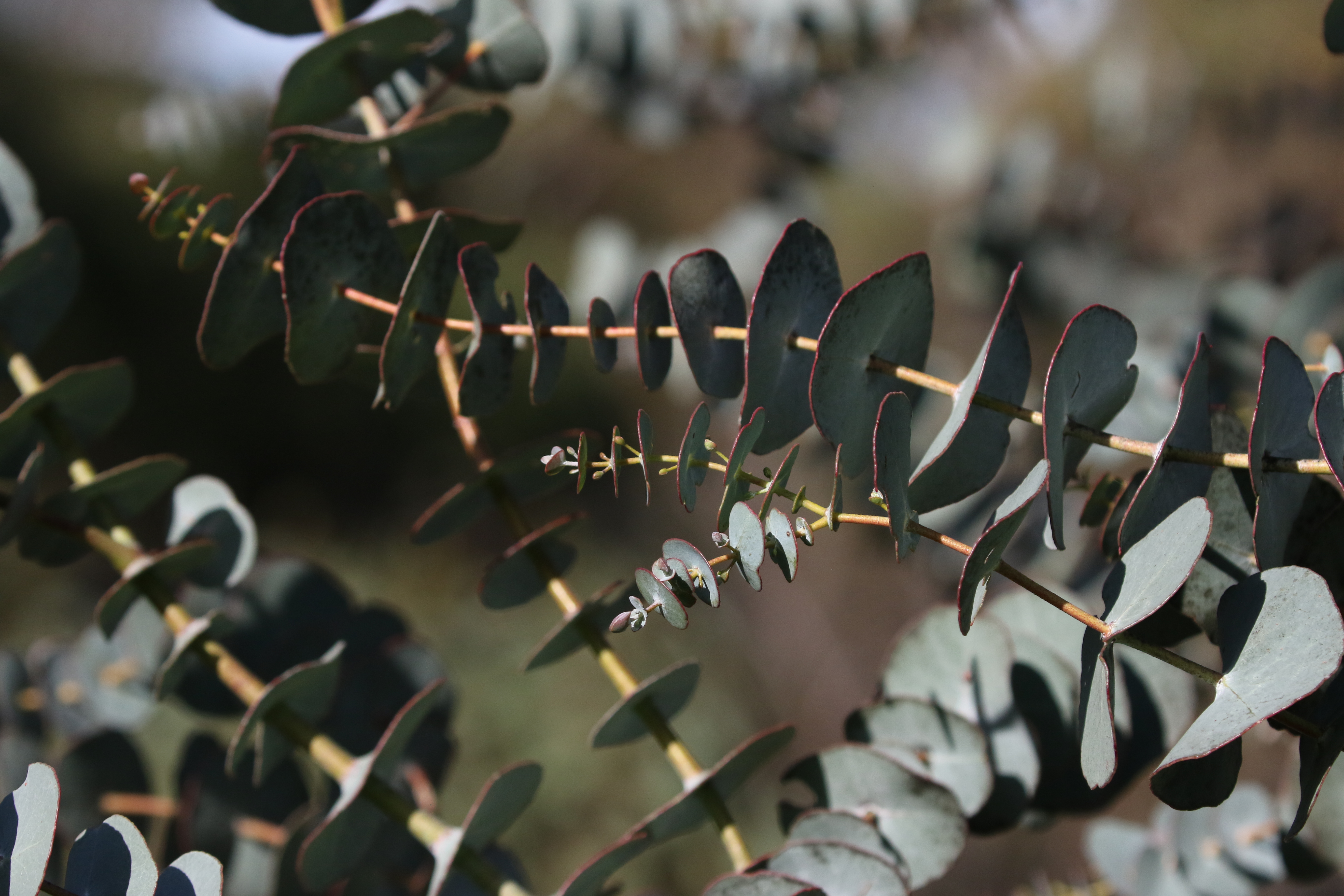inbox and environment news: Issue 575
March 12 - 18 2023: Issue 575
Large Leatherback Turtle Found On Whale Beach: Deceased
Further:
- Shark Meshing (Bather Protection) Program 2021/22 Annual Performance Report - Data Shows Vulnerable, Endangered and Critically Endangered Species Being Found Dead In Nets Off Our Beaches - August 2022
- Pittwater's Turtles Impacted By Boat Strikes In The Pittwater Estuary: 4 Knots Speed Limit/Distance To Shore Being Ignored - April 2022, Issue 533
- Shark Listening Stations + Drumlines Have Been Installed Off Our Beaches - May 2022 Update
- New Fleet Of Shark-Spotting Drones For New South Wales - July 2020
- NSW Shark Meshing (Bather Protection) Program 2020/21 Annual Performance Report: 90% Of Northern Beaches Marine Animals Entangled Were Not Targeted Sharks, Included are Threatened or Protected Species Mortalities
- NSW DPI's Shark Meshing 2019/20 Performance Report Released
- DPI Shark Meshing 2018/19 Performance Report: Local Nets Catch Turtles, a Few Sharks + Alternatives Being Tested + Historical Insights
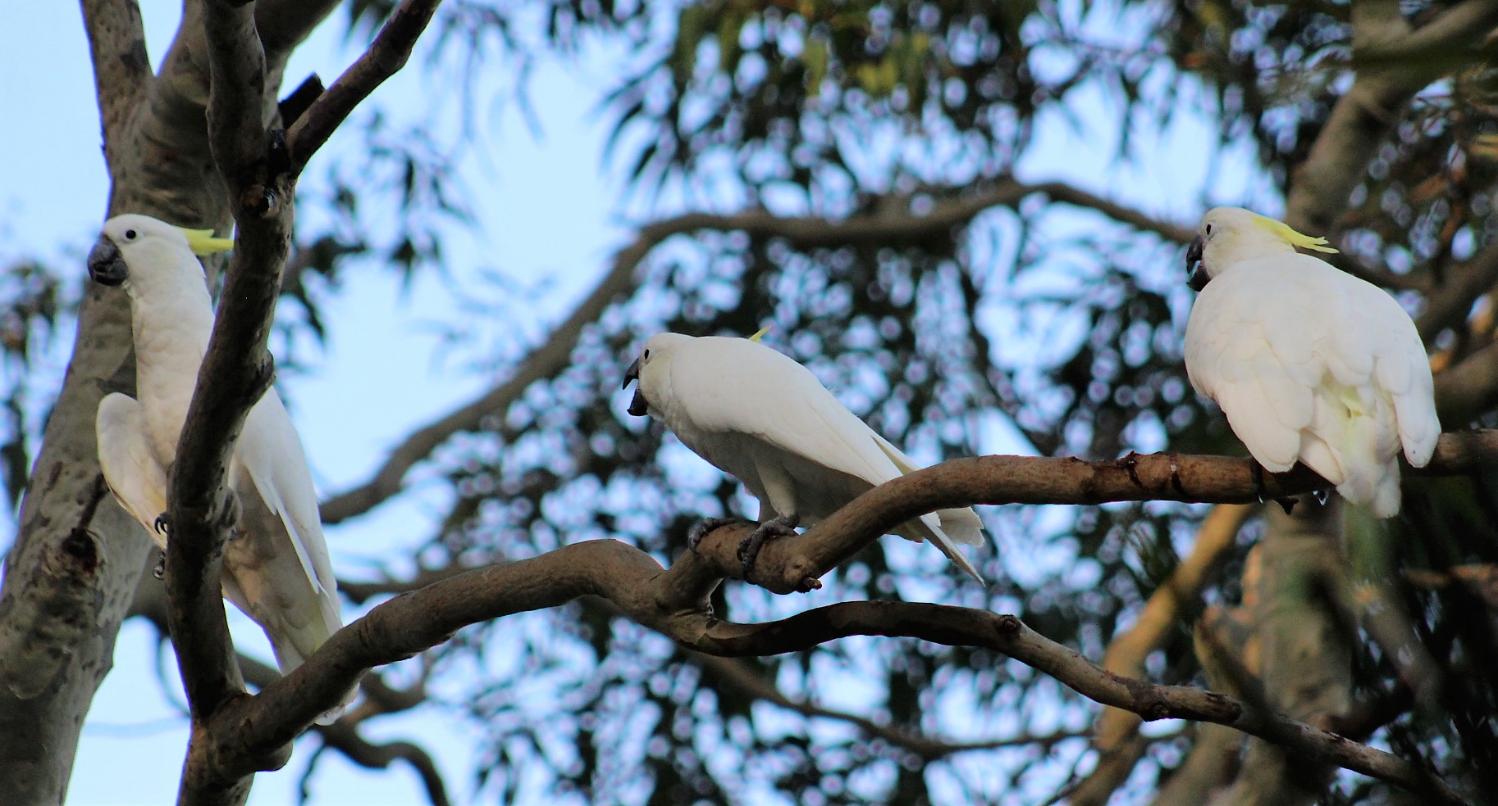
Avalon Dunes Bushcare: A Great Weeds Out Morning In March
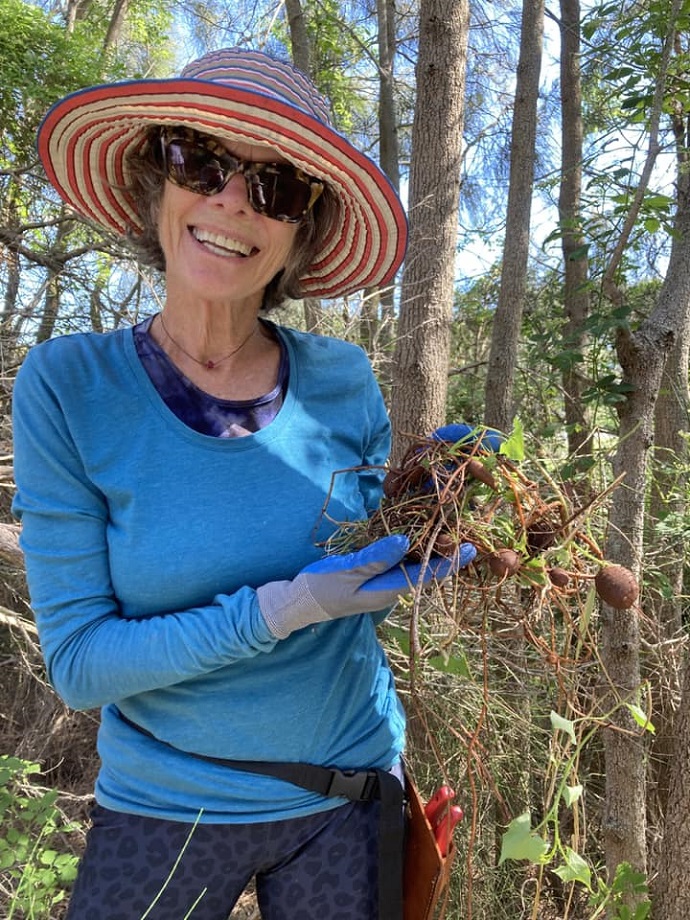
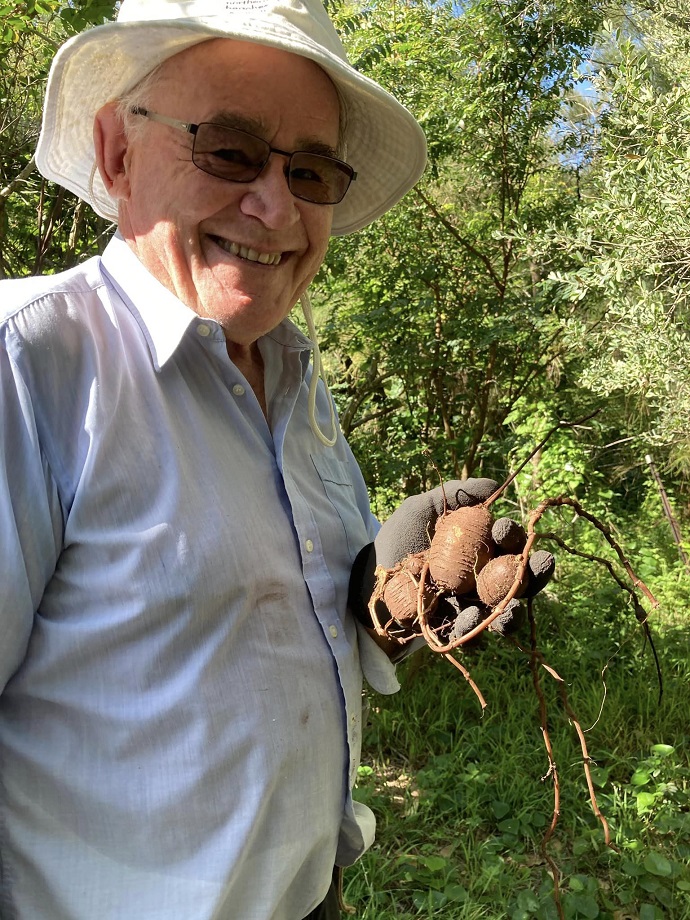
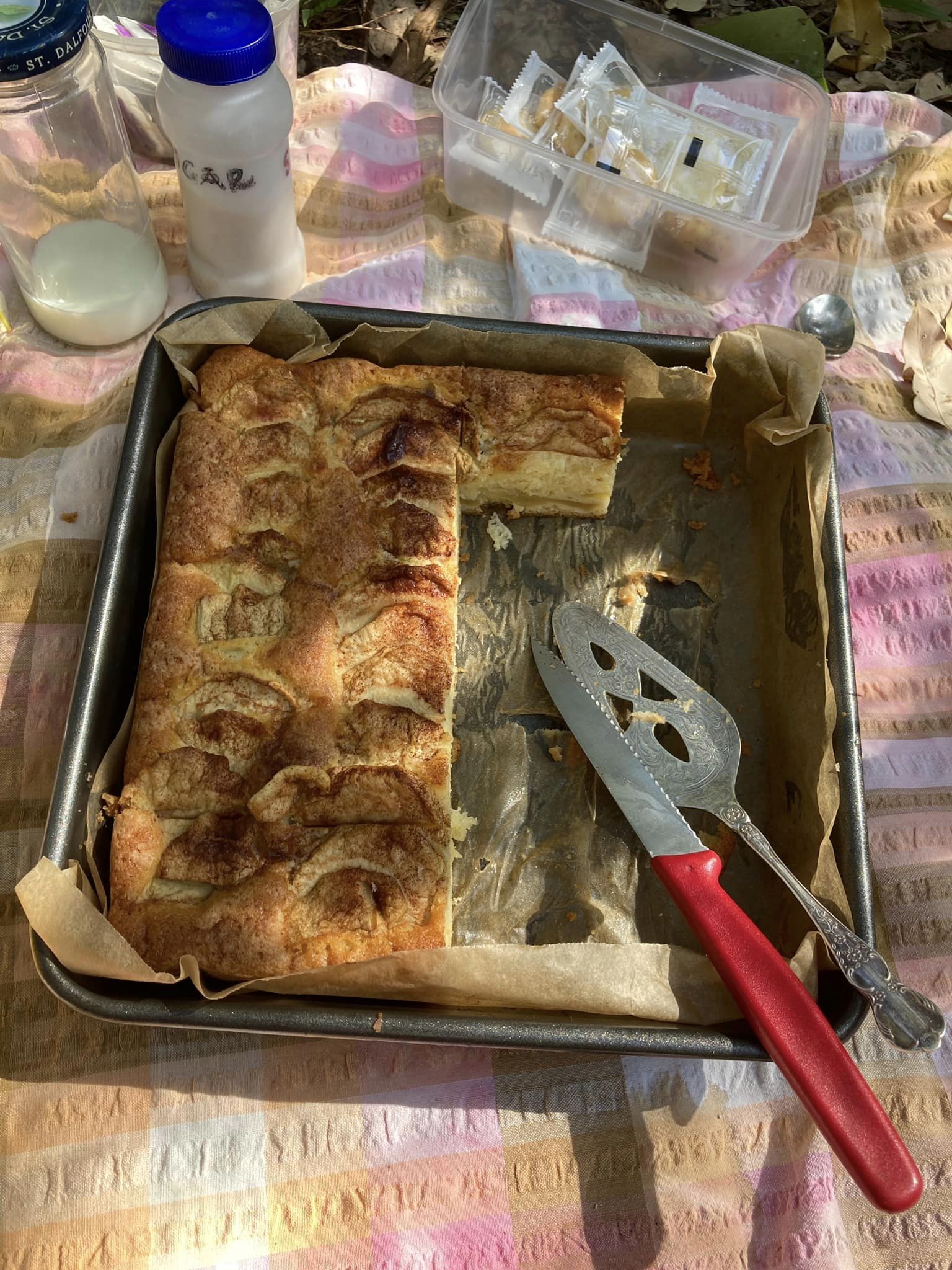
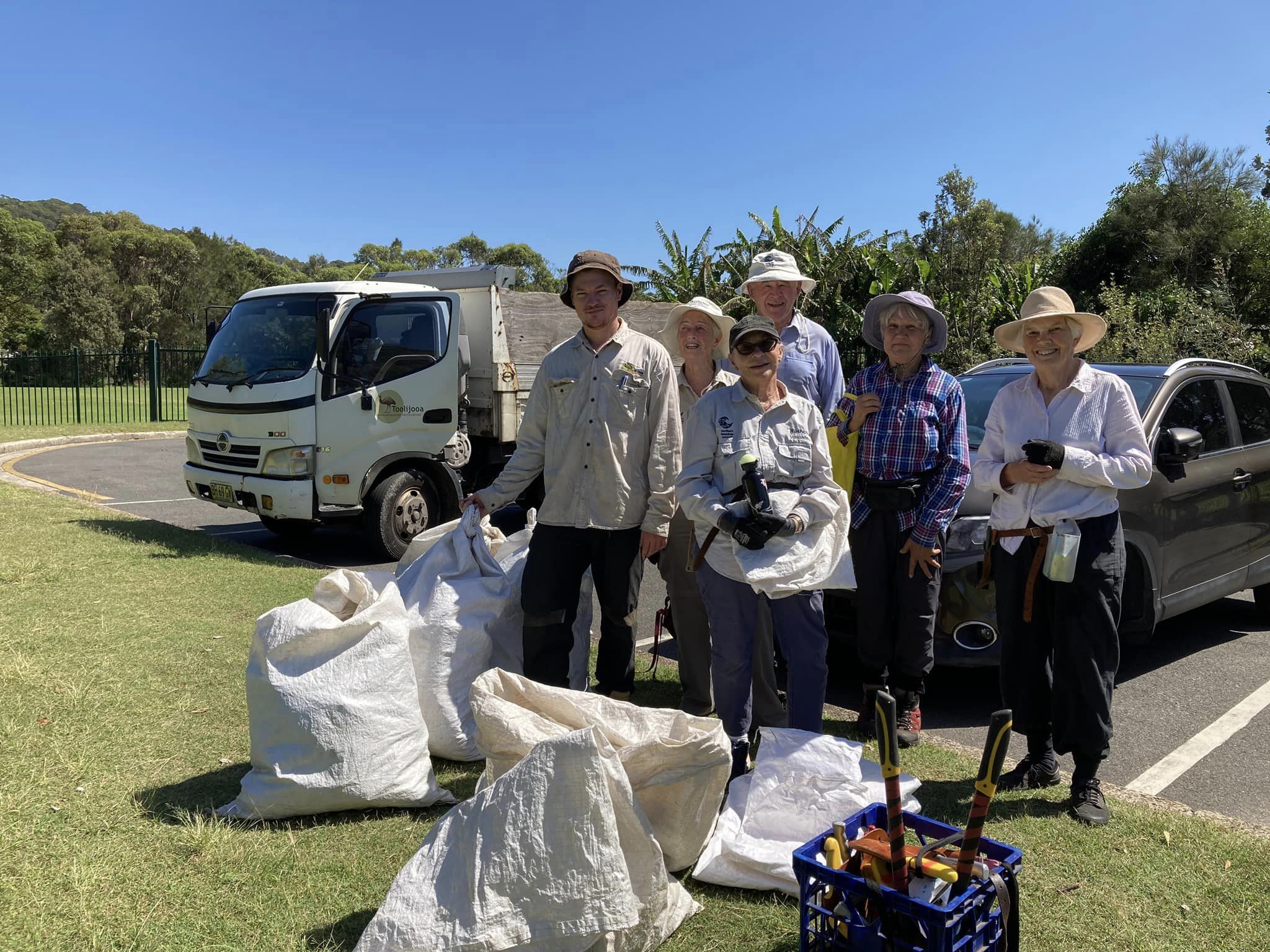
Swamp Wallaby At Palm Beach
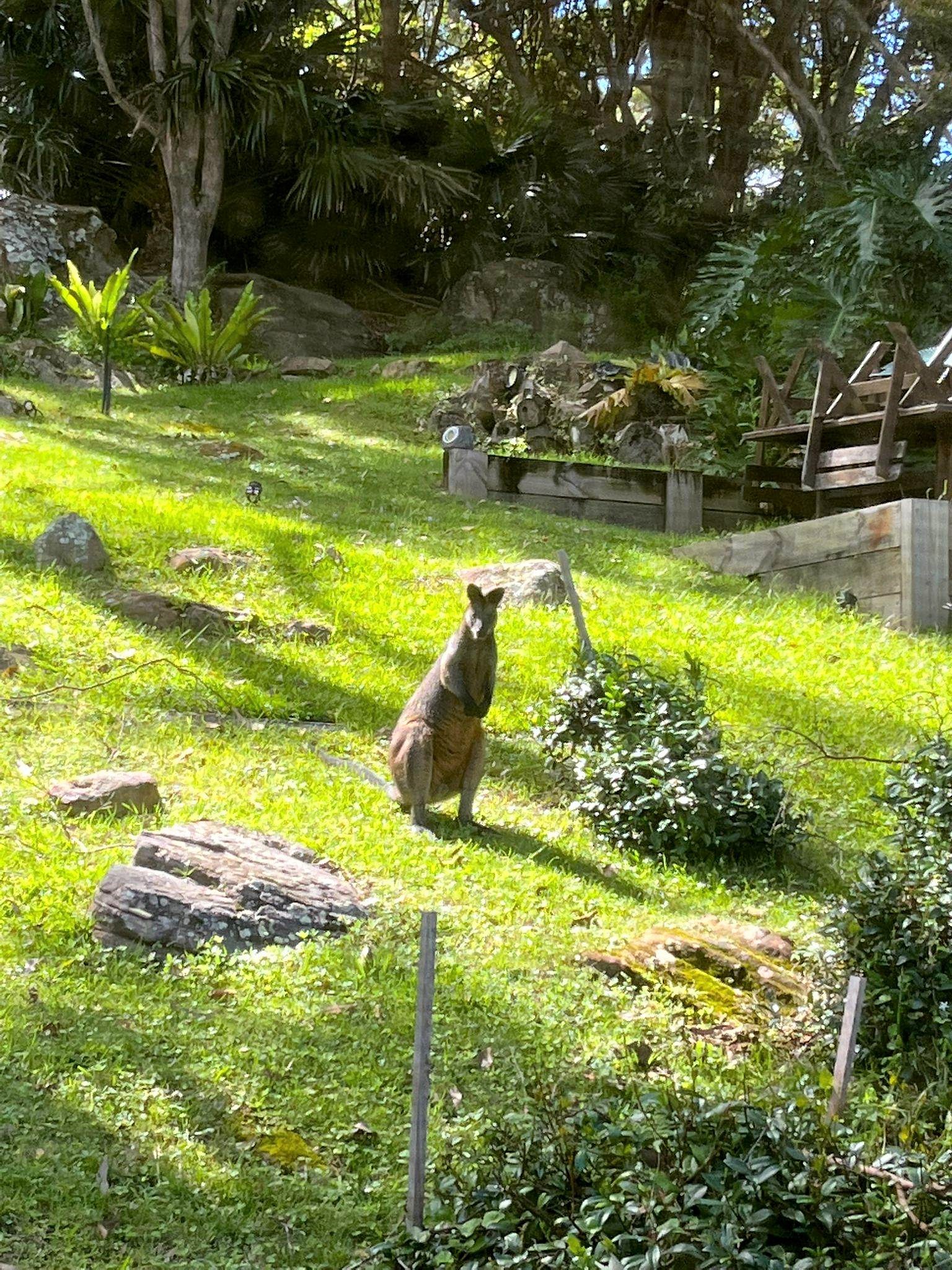
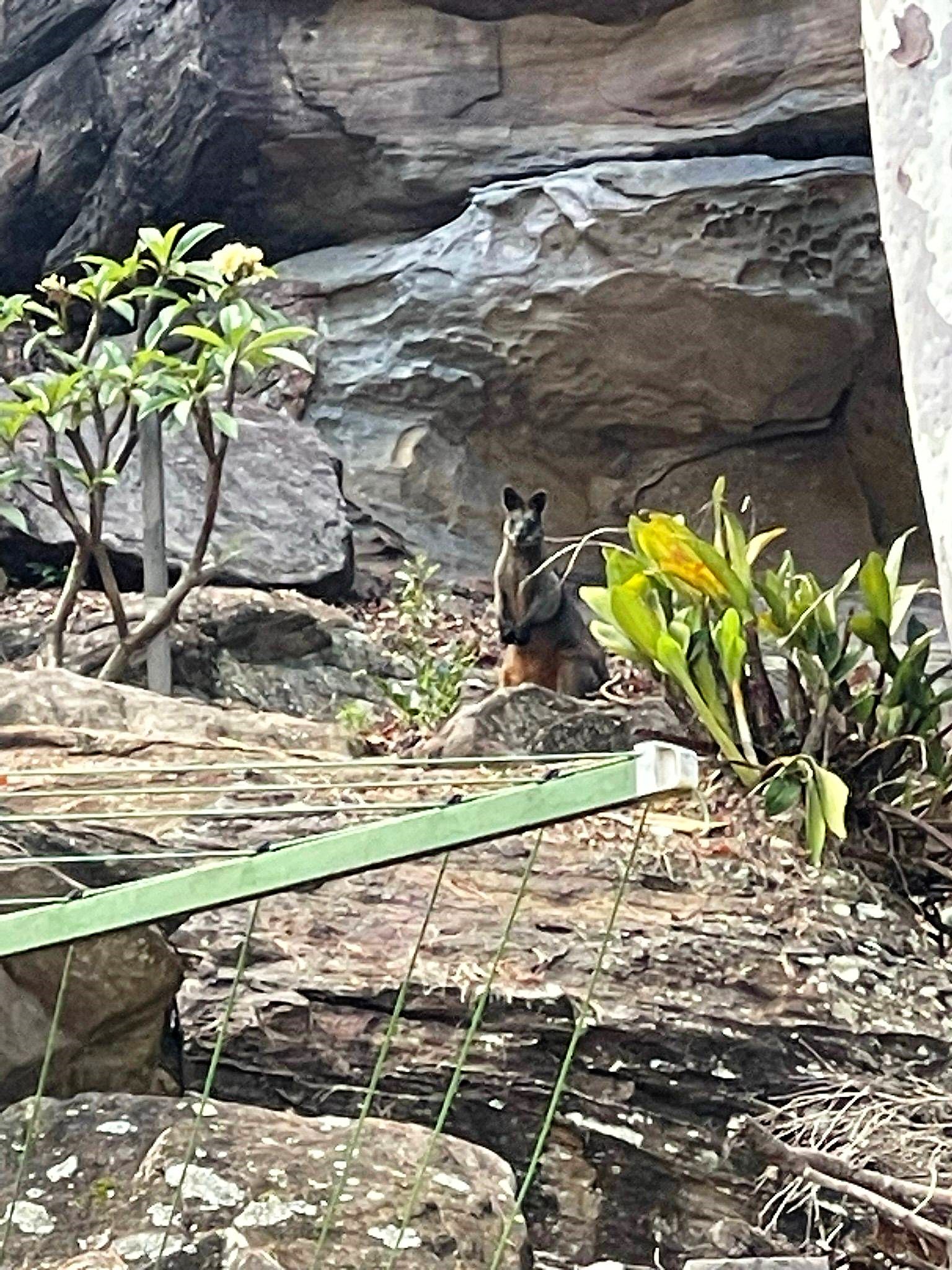
Cat Owners Encouraged To Keep Their Pets Safe At Home
Wednesday, 1 March 2023
Northern Beaches residents are being encouraged to keep their pets safe at home as part of a new animal protection campaign.
According to RSPCA NSW, two out of three cat owners have lost a cat to a roaming-related accident, and one in three to a car accident. Northern Beaches Council is proud to be one of 11 councils partnering with RSPCA NSW as part of the Keeping Cats Safe at Home project.
Promoting responsible ownership, the new campaign goes beyond desexing and micro chipping of beloved cats and asks owners to consider keeping their cats at home.
Northern Beaches CEO Ray Brownlee said there’s a dual benefit to cats and local wildlife that flows directly from promoting responsible ownership of domesticated cats.
“Northern Beaches residents love their pets, but they’re also passionate about protecting the local environment,” Mr Brownlee said.
“Because pet cats occupy a special place in our hearts we need to educate the community on how have them microchip and desexed to keep them safe. This initiative has an educational focus. It aims to protect tiny native species like lizards, mammals, baby birds and frogs, while also preventing domesticated cats from falling prey to road accidents.”
In 2021, the NSW Government awarded a $2.5 million grant from the NSW Environmental Trust to RSPCA NSW to deliver the project.
To help promote the campaign, Council is asking cat-lovers living on the Northern Beaches to submit a photo of their cat or kitten living their best life at home and go in the draw to win one of 10 $1000 vouchers for a deluxe outdoor cat enclosure from Catnets. The competition opens on March 1st and closes on Sunday April 9th 2023. Finalists will be published in an online gallery.
For competition details visit www.northernbeaches.nsw.gov.au/environment/non-native-animals/cats/competition-keeping-cats-safe-home
Learn more about keeping cats safe at www.rspcansw.org.au/keeping-cats-safe

Photo: Greg Hume
Protest For Koalas: Manly - Sunday March 12
We are taking a stand for koalas in NSW Environment Minister James Griffin’s Manly Electorate.
Koalas need forests.
The continual loss of habitat is contributing to the decline of koalas — and if we don’t end native forest logging they are on track to becoming extinct by 2050.
Join in showing your support in Manly to stand against the senseless devastation of koala habitat in NSW forests.
Environment Minister James Griffin is sitting on his hands on koalas.
It’s time we protect koalas by saving their habitat.
Speakers to be announced.
Event by Bob Brown Foundation
Manly Beach Promenade at the Corso: Sunday 12 March at 10am
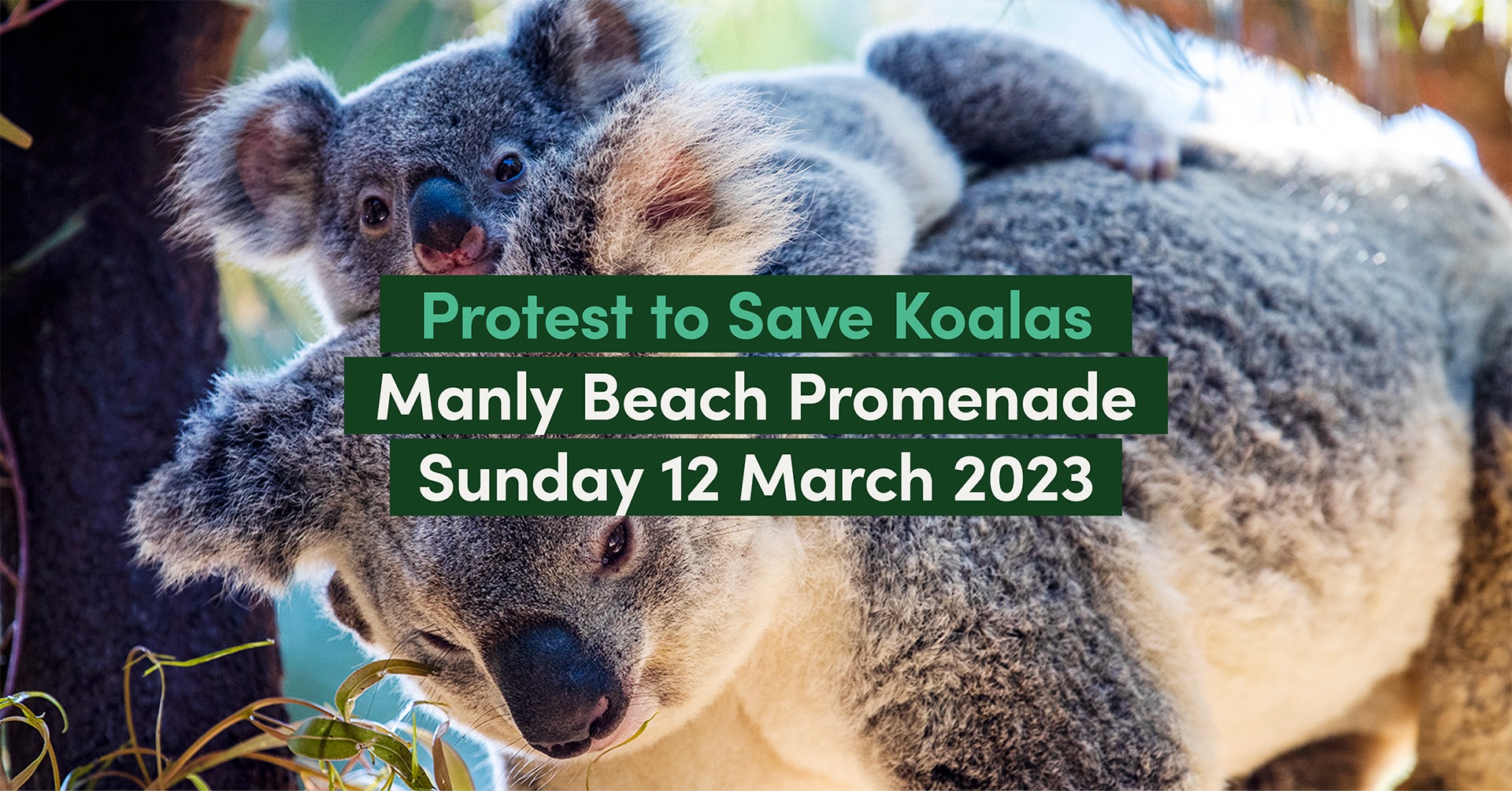
Concert: Rock For Lizard Rock
FREE. Register at: https://www.eventbrite.com/e/rock-for-lizard-rock-tickets-554768135427

Black Summer Vigil For Wildlife: April 2nd
The New South Wales Wildlife Council invites all wildlife carers, wildlife vets, vet nurses, first responders and supporters to the upcoming Black Summer Vigil for Wildlife on Sunday April 2nd 2023 starting at 2pm.
Please join us for the Black Summer Vigil, a three-year anniversary memorial service for the three billion animals who lost their lives in the fires – “one of the worst wildlife disasters in modern history”.
Attend online or in-person at Camperdown Memorial Rest Park (Sydney).
RSVP at: blacksummervigil.com
You’ll hear personal stories from the NSW Wildlife Council, Southern Cross Wildlife Care and other first responders across wildlife rescue, rural fire service, photojournalism, Aboriginal custodianship, veterinary medicine, ecology and more.
+ Performance and Ceremony by Jannawi Dance Clan, sharing a Dharug cultural perspective to honour the Ancestors and bring the spirit of the animals into our midst.
Join us to honour the animals who perished – and in doing so, celebrate the unique and extraordinary wildlife of these lands.
Speakers include:
Greg Mullins, Former Commissioner, Fire and Rescue NSW; Climate Councillor and founder, Emergency Leaders for Climate Action. Greg warned Australia's then–Prime Minister in April 2019 that a bushfire catastrophe was coming. He pleaded for support and was ignored, then risked his life dealing with the ramifications on the ground. “You couldn’t see very far because of the orange smoke. Everything was dark. It was probably 2 o’clock in the afternoon but it was like night. Then I saw something moving on the side of the road and I walked closer. It was a mob of kangaroos. The speed of that fire with its pyroconvective storm driving it in every direction, they had nowhere to go. They came out of the forest, on fire, and dropped dead on the road. I’ve never seen that. Kangaroos know what to do in a fire. They’re fast animals. Climate change, driven by the burning of coal, oil, and gas is driving worsening bushfires across Australia, and putting our precious, irreplaceable wildlife in danger.”
Internationally recognised ecologist and WWF board member, Professor Christopher Dickman oversaw the work calculating the animal deaths from Black Summer. A Fellow of the Australian Academy of Science, Professor Dickman already wore the heavy task of being an ecologist during the sixth mass extinction, in the country that has the worst rate of mammalian extinction in the world. On 8 January 2020 media around the world shared his finding that Black Summer fires had killed one billion animals. Sadly, the fires continued for two more months, and his team's final count was three billion. This does not include invertebrates: it is estimated 240 trillion beetles, moths, spiders, yabbies and other invertebrates died in the fires.
Coming up from the South Coast, owner of Wild2Free Kangaroo Sanctuary Rae Harvey, as seen in The Bond and The Fire. She is in the sad position of having personally known and cared for a number of Black Summer's victims: many of the orphaned joeys she cared for were killed in the fires. (She nearly died herself too.) For three years, she has been unable to even speak their names. Now, for the first time, she will tell the story of the joeys she lost.
Cultural burning practitioner and Southern NSW Regional Coordinator with Firesticks Alliance, Djiringanj-Yuin Custodian Dan Morgan. Dan practises using Aboriginal knowledge to heal Country. He has worked for 18 years with the NSW National Parks & Wildlife Service and is on the board of management for the Biamanga National Park, a sacred area home to the last surviving koalas on the NSW south coast – which was partly destroyed by the fires of Black Summer. “The animals that live on our sacred sites are our Ancestors, it's our Cultural obligation to protect them. We have evolved with our Country over thousands of years, nourishing and protecting all living species. Our Country represents our people. So when the fires came, it was devastating to see the aftermath, and the feeling of helplessness was truly traumatising for our people, due to the denial of our Cultural right to manage Country as our Ancestors did for thousands of years prior to colonisation. Australia needs to make legislative changes that allow us to heal Country and our community through the fire knowledge and to stop incinerating ecosystems with destructive 'hazard-reduction' burns."
Head of Programs & Disaster Response at Humane Society International (HSI), Evan Quartermain was one of the first responders on Kangaroo Island where nearly 40% of the island burnt at high severity: “Those were some of the toughest scenes I’d ever witnessed as an animal rescuer: the bodies of charred animals as far as the eye can see. Every time we found an animal alive it felt like a miracle.” As a result of this firsthand experience, HSI commissioned a report into the state of Australia's disaster response for wildlife, which we'll also hear about.
+ More to come.
The Black Summer Vigil is brought to you by the Department of Animals, Animals Australia, the NSW Wildlife Council, World Animal Protection, Humane Society International and Defend the Wild, with support from WIRES, Firesticks Alliance, Nature Conservation Council of NSW, Wild2Free Kangaroo Rescue, Four Paws, Friends of the Koala and Kangaroos Alive.

Permaculture Northern Beaches - Upcoming Events

- Learn about Permaculture design
- Caring for and raising chickens
- Native bees and bee hotels
- Living Skills - soap making
- AND Live Music!
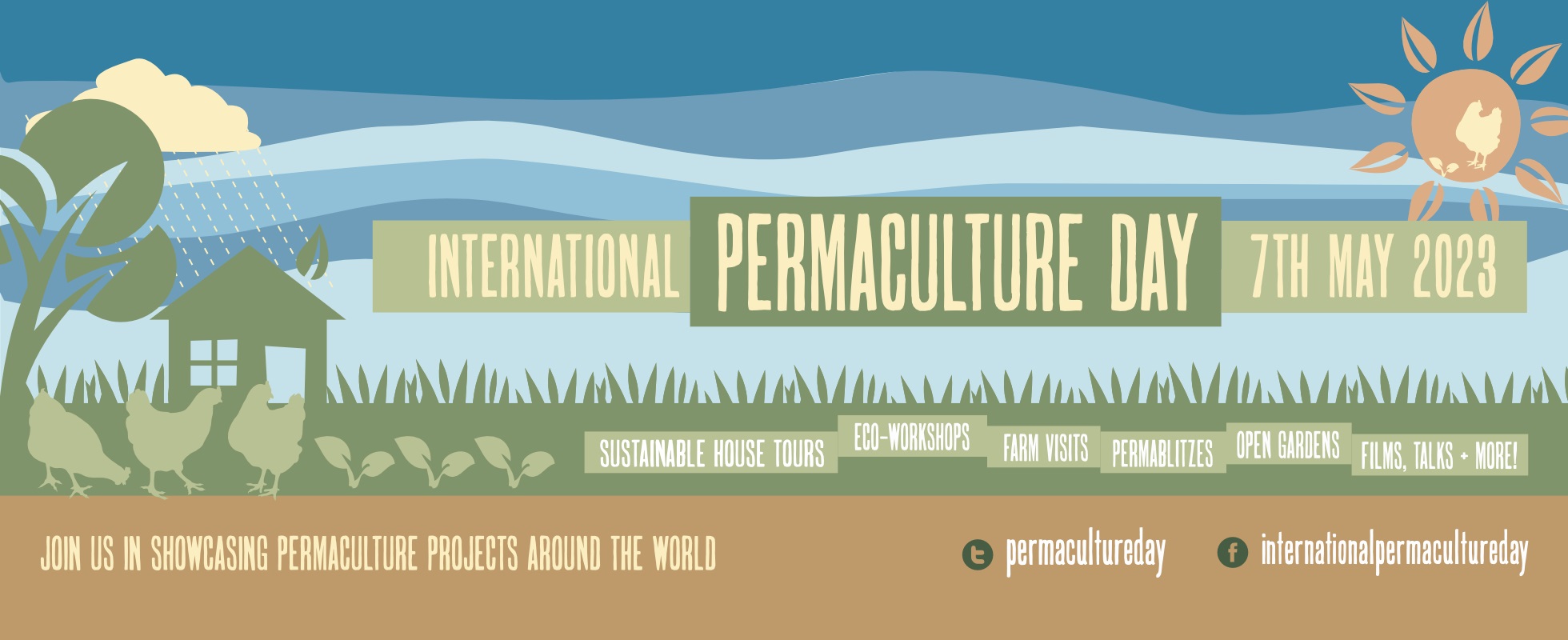
Australia’s Hotly Contested Eucalypt Of The Year Voting Now Open
Australia’s much loved - and hotly contested - Eucalypt of the Year voting is now open. Passionate gumtree lovers across the country are invited to vote for their favourite gum, now in its sixth consecutive year. There are ~850 species of eucalypt across the continent and they are an unmistakable feature of living where we do.
“After running for five years, there are still hundreds of eucalypts that haven’t had their time in the sun as Eucalypt of the Year. We’ve whittled down the species to a shortlist of 25 that represent a diverse range of ecological features and geographical spread to make it easier for you to vote. Last year’s winner - the mighty Mountain Ash (Eucalyptus regnans) is not eligible. Now is the time to cast your vote for your personal favourite,” says Linda Baird, CEO of Eucalypt Australia.
People can vote for their favourite eucalypt until 19th March at www.eucalyptaustralia.org.au
The winning eucalypt will be announced on National Eucalypt Day, Thursday March 23. National Eucalypt Day is Australia’s biggest annual celebration of eucalypts held every year to celebrate and promote Australia’s eucalypts and what they mean to our lives and hearts.
Tell the organisers how you voted on social media by tagging @EucalyptAus using the hashtag #EucalyptoftheYear. The 25 shortlisted species are:
- Angophora costata (Sydney Red Gum)
- Angophora hispida (Dwarf Apple)
- Corymbia aparrerinja (Ghost Gum)
- Corymbia citriodora (Lemon-scented Gum)
- Corymbia ficifolia (Red-flowering Gum)
- Corymbia opaca (Desert Bloodwood)
- Corymbia ptychocarpa (Swamp Bloodwood)
- Eucalyptus caesia (Silver Princess)
- Eucalyptus cinerea (Argyle Apple)
- Eucalyptus cneorifolia (Kangaroo Island Narrow-leaved Mallee)
- Eucalyptus lansdowneana (Crimson mallee)
- Eucalyptus platyphylla - (Poplar Gum)
- Eucalyptus leucoxylon - (Yellow Gum or South Australian Blue Gum)
- Eucalyptus macrandra (River Yate)
- Eucalyptus marginata (Jarrah)
- Eucalyptus miniata (Darwin Woollybutt)
- Eucalyptus perriniana (Tasmanian Spinning Gum)
- Eucalyptus radiata (Narrow-leaved Peppermint)
- Eucalyptus rhodantha (Rose Mallee)
- Eucalyptus rubida (Candlebark)
- Eucalyptus salmonophloia (Salmon Gum)
- Eucalyptus oleosa (Giant Mallee)
- Eucalyptus synandra (Jingymia Mallee)
- Eucalyptus tetraptera (Square-fruited Mallee or Four-winged Mallee)
- Eucalyptus vernicosa (Varnished Gum)
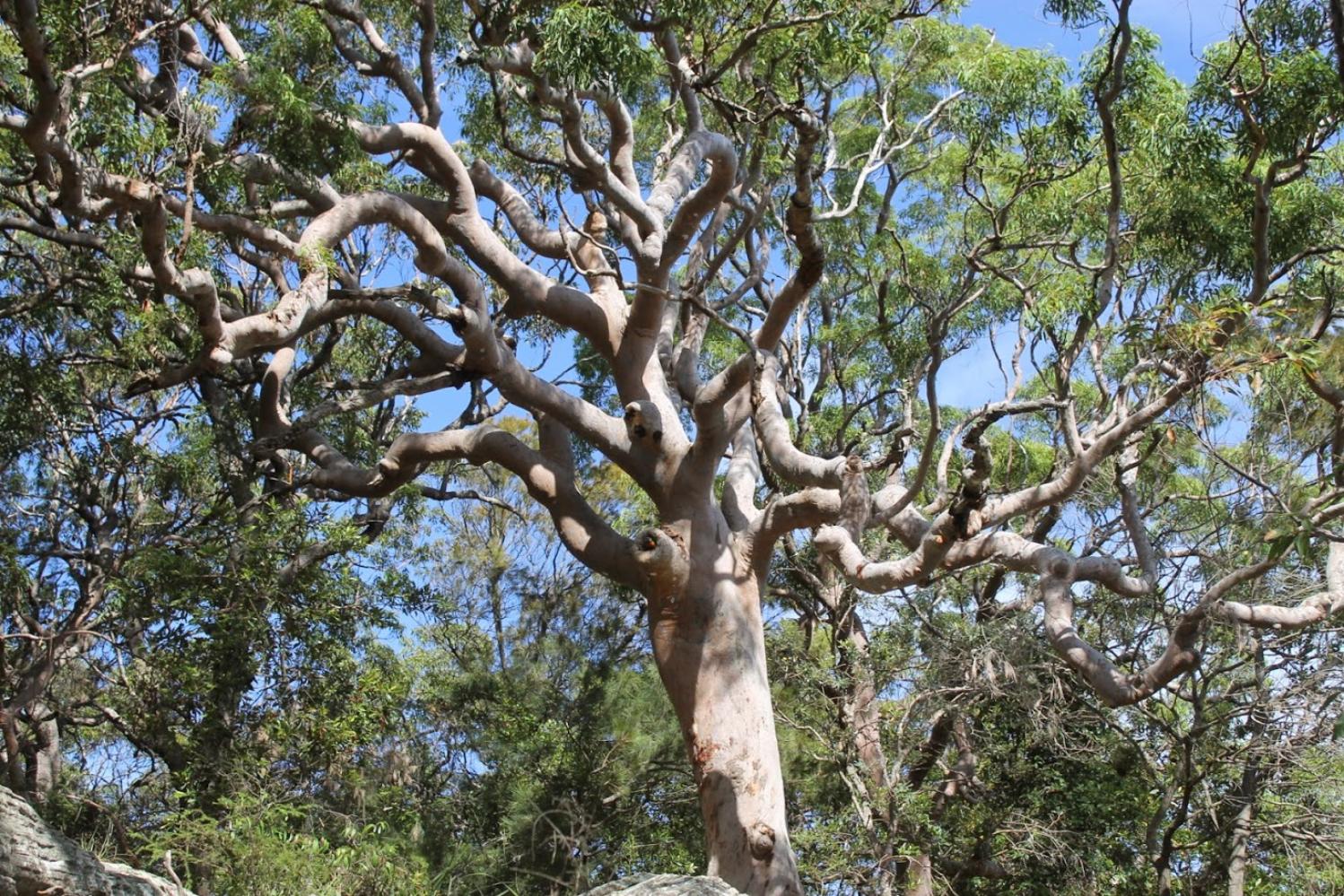
Angophora costata (Sydney Red Gum), McKay Reserve Palm Beach. Photo: A J Guesdon
Tasmanian Spinning Gum Eucalyptus perriniana. Photo: Remember The Wild, Catherine Cavallo, Instagram handle rememberthewild
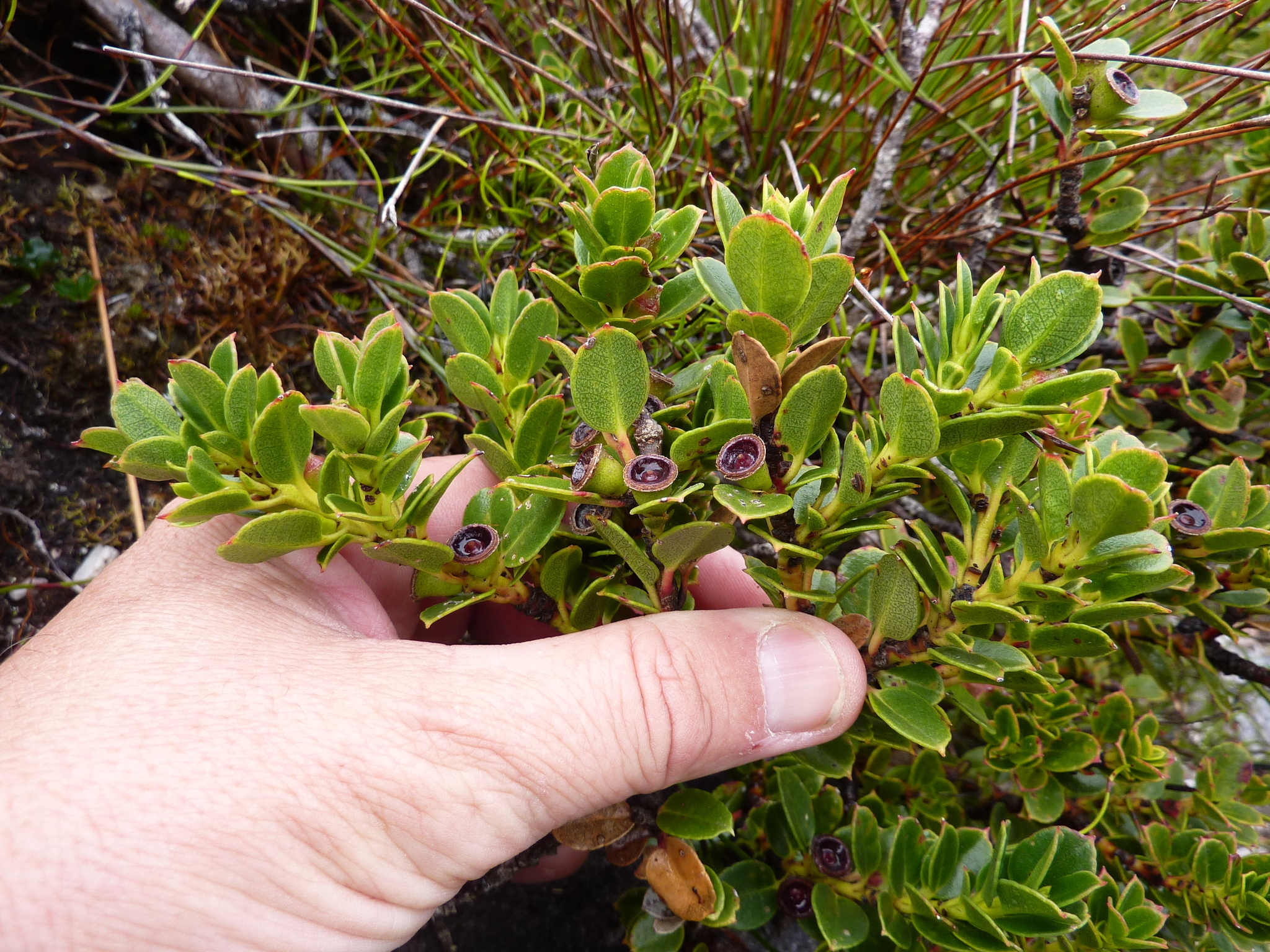
Varnished Mallee Eucalyptus vernicosa. Photo: Dean Nicolle
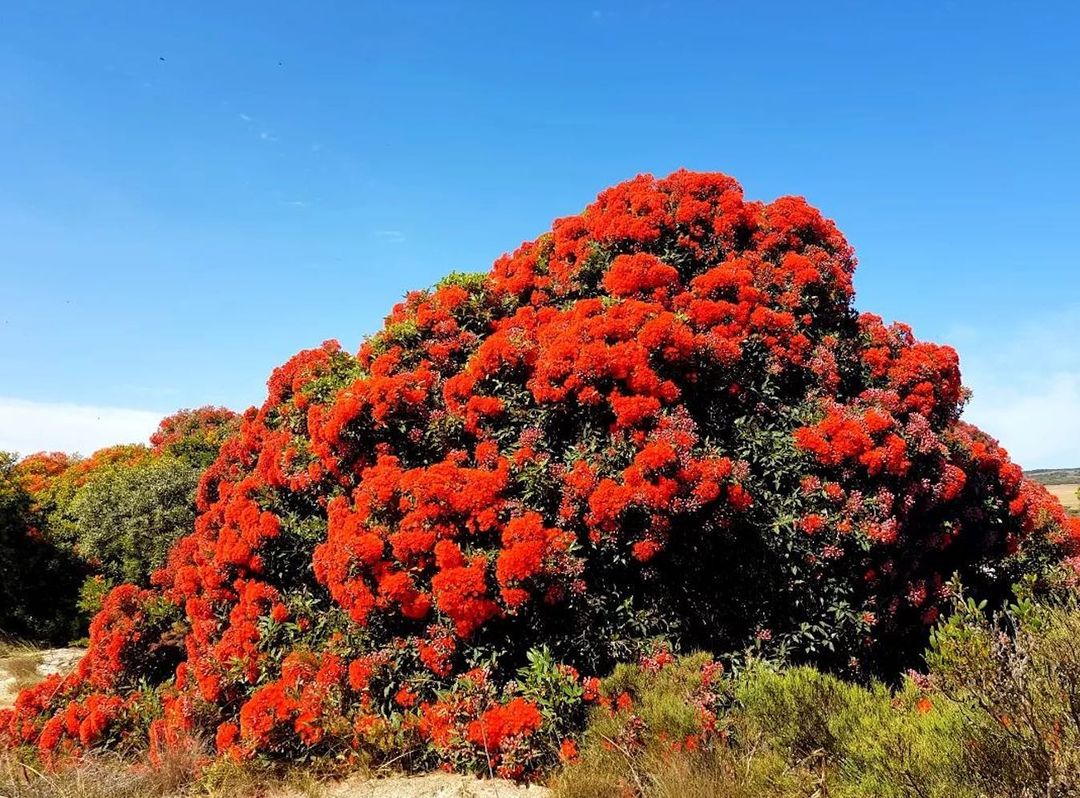
Red Flowering Gum Corymbia ficifolia. Photo: Melanie Cooper, Instagram handle maxxle5
Report Fox Sightings
%20(1).jpg?timestamp=1675893929686)
Weed Of The Week: Cassia - Please Pull Out And Save Our Bush
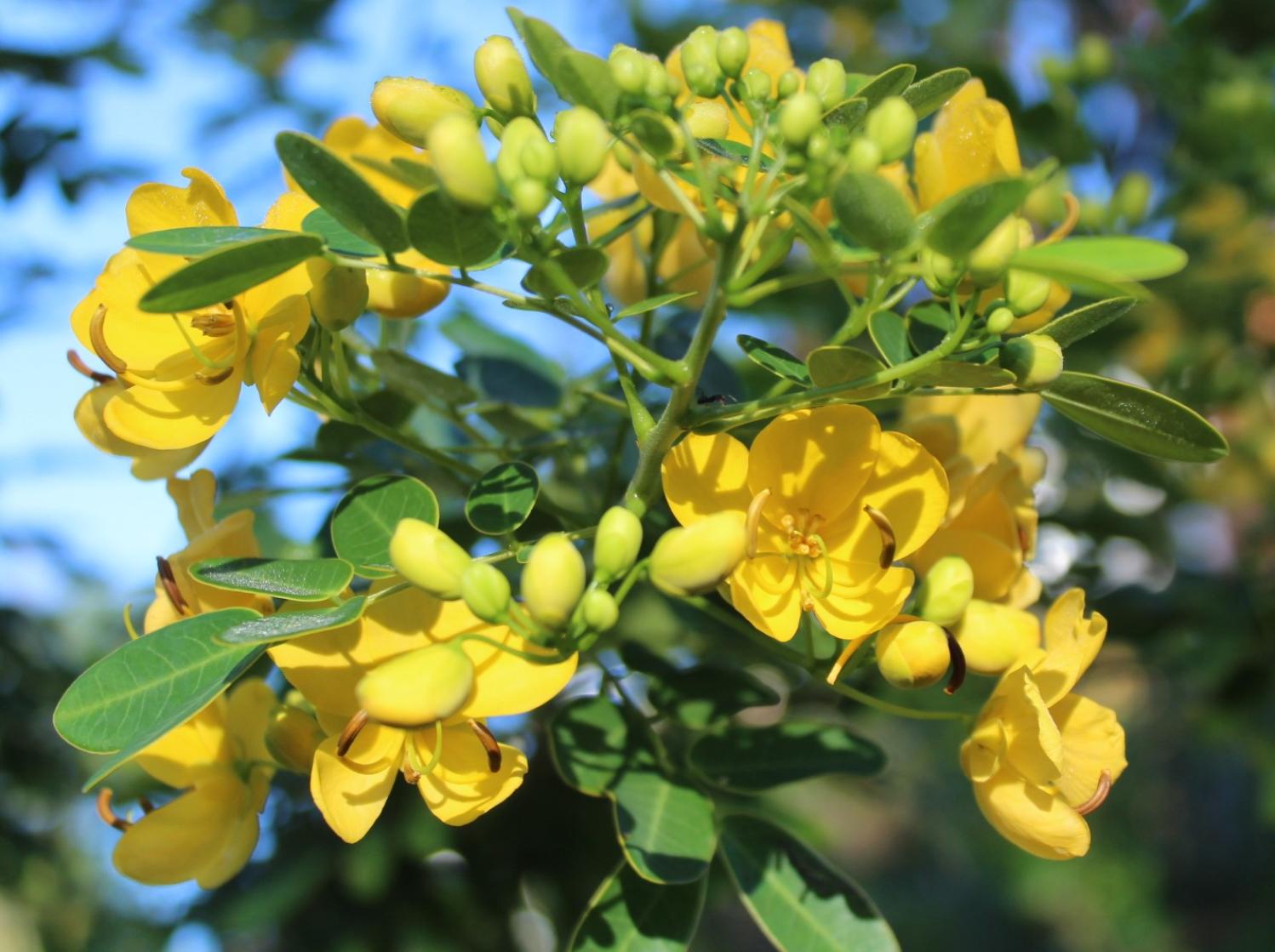
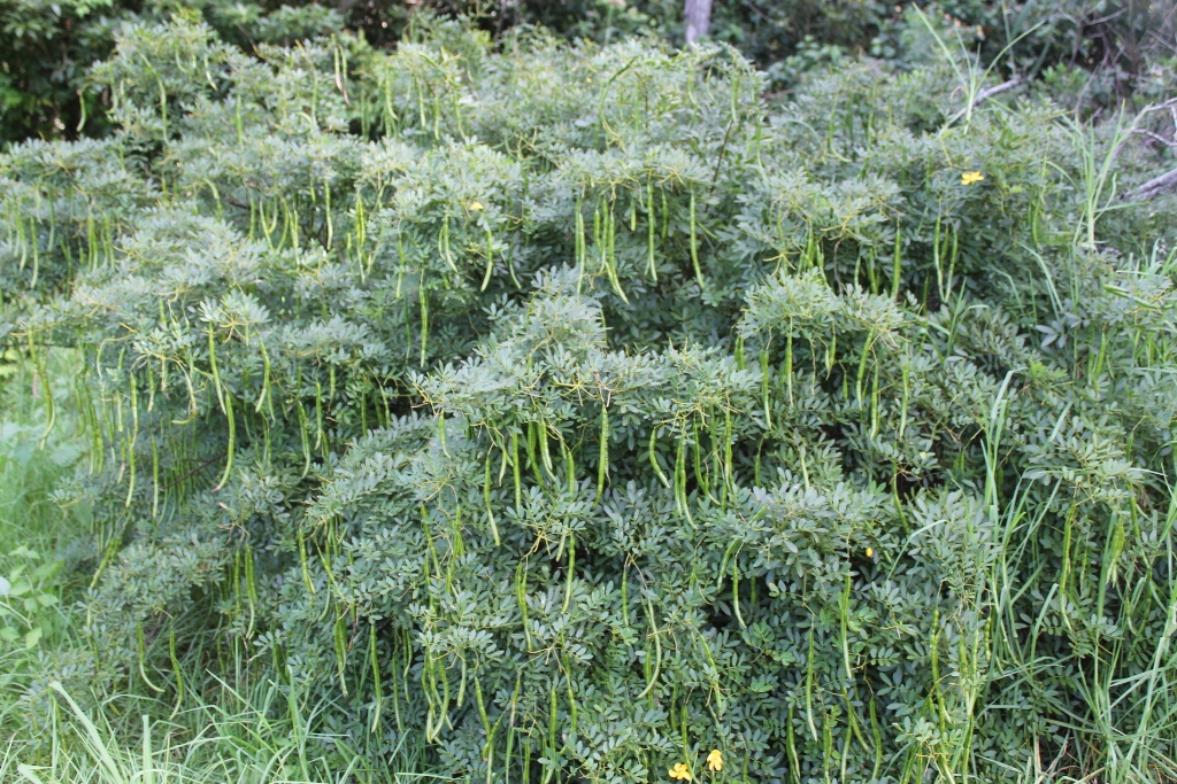
Create A Spit To Seaforth Oval Walk: The Missing Link - Petition
There is approx. 20,000 square metres of land situated between Rignold Street and Castle Circuit, Seaforth. The largest block is now FOR SALE. There is currently contracts out to overseas investors and developers.
The land is separated by conservation land that joins Garigal National Park. This land should be purchased and returned to the community for all to enjoy and wildlife to be given a fighting chance at survival.
This is a thriving riparian zone that should be made a wildlife corridor. It is currently the wildlife corridor that connects existing corridors to Garigal National Park .Running through the middle of the land is a permanent water source that attracts and aids the survival of many animals. Currently there are wallabies, echidnas, powerful owls, lyrebirds, monitor lizards, water dragons, numerous species of small birds and insects such as a large variety of dragonflies.
The Powerful Owl is listed as vulnerable in NSW and there is talk of changing the lyrebird's status to threatened in light of the recent loss of habitats due the devastating fire season of last summer. The Seaforth Mint Bush is listed as critically endangered. The Angophora's are a protected species.
The loss of hollow bearing trees is a key threatening process in determining whether or not these vulnerable and threatened species will survive.
Given the conservation status of this flora and fauna I am asking for this land be bought back to create a wildlife corridor to join the land that was saved behind Dalwood homes. At present the land is made up of two privately owned properties, one is owned by a Chinese consortium and the other is owned by an American family. Both parcels have derelict houses that are falling down, leaving shattered glass, asbestos and building rubble spread through the bush. One property has no street access and is only accessible by water.
Thank you to all who have read this far and thank you in anticipation of your signatures helping to protect this very unique area.
Petition at: https://www.change.org/p/create-a-spit-to-seaforth-oval-walk
THIS IS THE MISSING LINK TO CREATING A FORESHORE WALK THROUGH SEAFORTH.
New Marine Wildlife Rescue Group On The Central Coast
A new wildlife group was launched on the Central Coast on Saturday, December 10, 2022.
Marine Wildlife Rescue Central Coast (MWRCC) had its official launch at The Entrance Boat Shed at 10am.
The group comprises current and former members of ASTR, ORRCA, Sea Shepherd, Greenpeace, WIRES and Wildlife ARC, as well as vets, academics, and people from all walks of life.
Well known marine wildlife advocate and activist Cathy Gilmore is spearheading the organisation.
“We believe that it is time the Central Coast looked after its own marine wildlife, and not be under the control or directed by groups that aren’t based locally,” Gilmore said.
“We have the local knowledge and are set up to respond and help injured animals more quickly.
“This also means that donations and money fundraised will go directly into helping our local marine creatures, and not get tied up elsewhere in the state.”
The organisation plans to have rehabilitation facilities and rescue kits placed in strategic locations around the region.
MWRCC will also be in touch with Indigenous groups to learn the traditional importance of the local marine environment and its inhabitants.
“We want to work with these groups and share knowledge between us,” Gilmore said.
“This is an opportunity to help save and protect our local marine wildlife, so if you have passion and commitment, then you are more than welcome to join us.”
Marine Wildlife Rescue Central Coast has a Facebook page where you may contact members. Visit: https://www.facebook.com/profile.php?id=100076317431064
- Ph: 0478 439 965
- Email: marinewildlifecc@gmail.com
- Instagram: marinewildliferescuecc

Watch Out - Shorebirds About
.JPG.opt1460x973o0,0s1460x973.jpg?timestamp=1663629195339)
Possums In Your Roof?: Do The Right Thing

Aviaries + Possum Release Sites Needed

Bushcare In Pittwater
Where we work Which day What time
Avalon
Angophora Reserve 3rd Sunday 8:30 - 11:30am
Avalon Dunes 1st Sunday 8:30 - 11:30am
Avalon Golf Course 2nd Wednesday 3 - 5:30pm
Careel Creek 4th Saturday 8:30 - 11:30am
Toongari Reserve 3rd Saturday 9 - 12noon (8 - 11am in summer)
Bangalley Headland 2nd Sunday 9 to 12noon
Bayview
Winnererremy Bay 4th Sunday 9 to 12noon
Bilgola
North Bilgola Beach 3rd Monday 9 - 12noon
Algona Reserve 1st Saturday 9 - 12noon
Plateau Park 1st Friday 8:30 - 11:30am
Church Point
Browns Bay Reserve 1st Tuesday 9 - 12noon
McCarrs Creek Reserve Contact Bushcare Officer To be confirmed
Clareville
Old Wharf Reserve 3rd Saturday 8 - 11am
Elanora
Kundibah Reserve 4th Sunday 8:30 - 11:30am
Mona Vale
Mona Vale Beach Basin 1st Saturday 8 - 11am
Mona Vale Dunes 2nd Saturday +3rd Thursday 8:30 - 11:30am
Newport
Bungan Beach 4th Sunday 9 - 12noon
Crescent Reserve 3rd Sunday 9 - 12noon
North Newport Beach 4th Saturday 8:30 - 11:30am
Porter Reserve 2nd Saturday 8 - 11am
North Narrabeen
Irrawong Reserve 2nd Saturday 2 - 5pm
Palm Beach
North Palm Beach Dunes 3rd Saturday 9 - 12noon
Scotland Island
Catherine Park 2nd Sunday 10 - 12:30pm
Elizabeth Park 1st Saturday 9 - 12noon
Pathilda Reserve 3rd Saturday 9 - 12noon
Warriewood
Warriewood Wetlands 1st Sunday 8:30 - 11:30am
Whale Beach
Norma Park 1st Friday 9 - 12noon
Western Foreshores
Coopers Point, Elvina Bay 2nd Sunday 10 - 1pm
Rocky Point, Elvina Bay 1st Monday 9 - 12noon
Friends Of Narrabeen Lagoon Catchment Activities

Gardens And Environment Groups And Organisations In Pittwater
We now have a treaty governing the high seas. Can it protect the Wild West of the oceans?

Delegates gave a jubilant cheer at United Nations Headquarters in New York on Saturday night, as nations reached an agreement on ways to protect marine life in the high seas and the international seabed area.
It has been a long time coming, debated for almost two decades. It took nine years of discussions by an Informal Working Group, four sessions of a Preparatory Committee, five meetings of an Intergovernmental Conference and a 36-hour marathon final push to reach agreement.
So why was it so hard to achieve? And what does it do?
In short, the Biodiversity Beyond National Jurisdiction agreement paves the way for the establishment of more high seas marine protected areas. Only 1% of the high seas are currently fully protected, so the new agreement is a vital step towards achieving the recently adopted Kunming-Montreal biodiversity pact, which pledges to protect 30% of terrestrial and marine habitats by 2030.
In turn, the designation of more high seas marine protected areas could assist in curbing fishing activities in these waters. At present, distant water fleets can scoop up almost everything that swims or scuttles thousands of kilometres from their home country. As the high seas are also teeming with marine life, the new agreement also ensures this genetic wealth is shared fairly and equitably among the international community.
It’s not too much to say this agreement marks a significant turning point in the protection of our deep oceans.
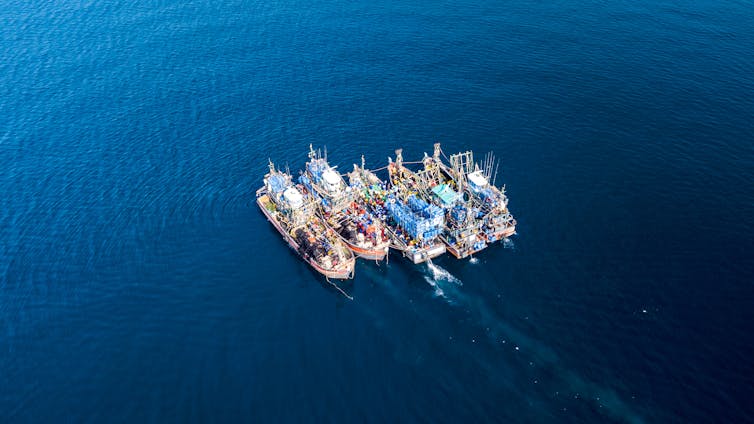
Where Are We Talking About?
Nations have rights to marine resources out to 200 nautical miles (370 kilometres) from their coastline. After that? It’s almost completely unregulated, much like the Wild West. It’s a huge area, representing over 60% of our oceans.
But this agreement doesn’t just cover what lives in the high seas water column. It also covers the seabed, ocean floor and subsoil beyond a coastal country’s continental shelf.
Major discoveries on the ocean floor have dispelled the long perceived myth that the deep seabed is a barren desert and featureless plain. One important breakthrough has been the discovery of hydrothermal vents and their rich biological community. These seabed habitats, have been labelled one of the richest nurseries of life on Earth and harbour unique organisms of particular interest to science and industry alike. These organisms may offer a limitless catalogue of medical, pharmaceutical and industrial applications. They may even hold the cure for cancer.
Isolation Is No Longer Protection
Due to their remote nature, the high seas were long considered protected from human impact. But only 13% of the ocean is now classified as marine wilderness, completely free from human disturbance, with most being located in the high seas.
International law, as it stands, is not up to the task of protecting this region. Regulations and rules are haphazard, with some regions and resources (like marine genetic resources) not protected at all. Enforcement is weak, and cooperation lacking, as I have found in my research.
Without adequate regulation, the high seas are being heavily exploited with 34% of all fished species now overfished. Illegal, unregulated and unreported fishing is also a serious problem on the high seas.
There is also growing interest in deep-sea mineral resources. The International Seabed Authority has entered into contracts with companies to mine deep-seabed areas, but the long term impacts of this mining activity are difficult to predict and its effects could have irreversible consequences for marine ecosystems. Marine pollution is also a growing problem with approximately 6.4 million tonnes of litter entering our oceans every year.
What Solutions Does This Agreement Offer?
Under this agreement, the door is open to establish marine parks and sanctuaries covering key areas of the high seas. Fishing could be banned or heavily restricted in these areas along with other activities that could have a detrimental impact on marine life.
You might have expected fishing to be a key reason for the long delay in getting this agreement across the line. However, one of the main stumbling blocks was how to share the genetic wealth of the high seas. Under the agreement, all countries will have to share benefits – financial and otherwise – from efforts to harness the benefits to be derived from these resources. Think of the possible new cancer treatments coming from compounds in sponges and starfish.
Why was this a challenge? It was difficult to find common ground on how to share benefits from this genetic wealth, with a clear divide between developed and developing nations. But it was achieved and now data, samples and research advances will need to be shared with the world.
What’s Next?
Reaching agreement has been achieved. To make it legally binding, it must be adopted and ratified by countries. Will the world’s nations sign up? We’ll need as close to universal participation as possible to make this work. The first part is done. But getting States to sign on, ratify and follow the agreement is likely to be a harder task. ![]()
Dr Sarah Lothian, Lecturer and Academic Barrister, Australian National Centre for Ocean Resources and Security, University of Wollongong, University of Wollongong
This article is republished from The Conversation under a Creative Commons license. Read the original article.
The high seas are supposed to belong to everyone – a new UN treaty aims to make it law
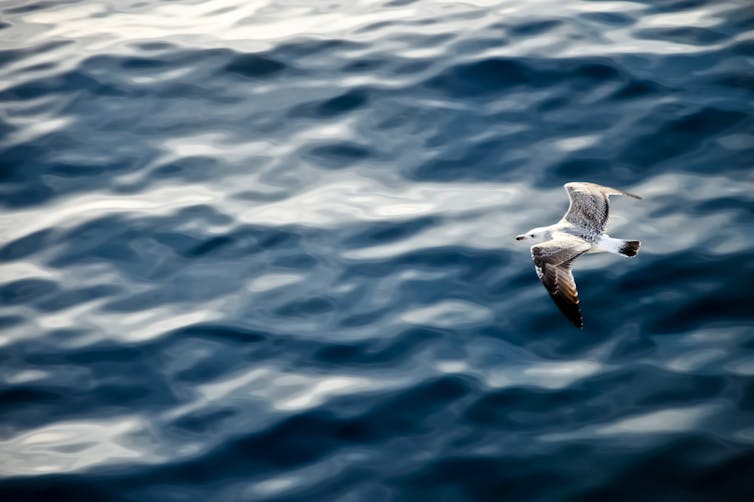
It may come as a surprise to fellow land-dwellers, but the ocean actually accounts for most of the habitable space on our planet. Yet a big chunk of it has been left largely unmanaged. It’s a vast global common resource, and the focus of a new treaty called the biodiversity beyond national jurisdiction (BBNJ) agreement.
For 15 years, UN member states have been negotiating rules that will apply to the ocean lying more than 200 nautical miles from coastlines, including the seabed and the air space above, referred to as the “high seas”.
Covering nearly half the Earth’s surface, the high seas are shared by all nations under international law, with equal rights to navigate, fish and conduct scientific research. Until now, only a small number of states have taken advantage of these opportunities.
This new agreement is supposed to help more countries get involved by creating rules for more fairly sharing the rewards from new fields of scientific discovery. This includes assisting developing countries with research funding and the transfer of technology.
Countries that join the treaty must also ensure that they properly assess and mitigate any environmental impacts from vessels or aircraft in the high seas under their jurisdiction. This will be especially relevant for novel activities like removing plastic.
Once at least 60 states have ratified the agreement (this may take three years or more), it will be possible to establish marine protected areas (MPAs) in high sea locations of special value.
This could protect unique ecosystems like the Sargasso Sea: a refuge of floating seaweed bounded by ocean currents in the north Atlantic which offers breeding habitat for countless rare species. By restricting what can happen at these sites, MPAs can help marine life persevere against climate change, acidification, pollution and fishing.
There are obstacles to all nations participating in the shared enjoyment and protection of the high seas, even with this new treaty. Nations joining the new agreement will need to work with existing global organisations such as the International Maritime Organization (IMO), which regulates shipping, as well as regional fisheries management organisations.
The new treaty encourages consultation and cooperation with existing bodies, but states will need to balance their commitments with those made under other agreements. Already, some departments within governments work against each other when implementing broad, international treaties. For example, one division may chafe at greenhouse gas pollution regulations imposed at the IMO while a sister agency advocates for more stringent climate change measures elsewhere.
A New Research Frontier
A key element of the new treaty addresses the disproportionate ability of developed countries to benefit from the scientific knowledge and commercial products derived from genetic samples taken from the high seas. More than 40 years ago, when the law of the sea convention was being negotiated, the same issue arose over seabed minerals in areas beyond national jurisdiction.
Industrialised nations had the technology to explore and intended to eventually mine these minerals, while developing countries did not. At that time, nations agreed that these resources were part of the “common heritage of humankind” and created the International Seabed Authority to manage a shared regime for exploiting them.
The extreme conditions for life in the open ocean have nurtured a rich diversity of survival strategies, from the bacteria that thrive in the extremely hot hydrothermal vents of the deep sea to icefish that breed in the intense cold of the Southern Ocean off Antarctica. These life forms carry potentially valuable information in their genes, known as marine genetic resources.
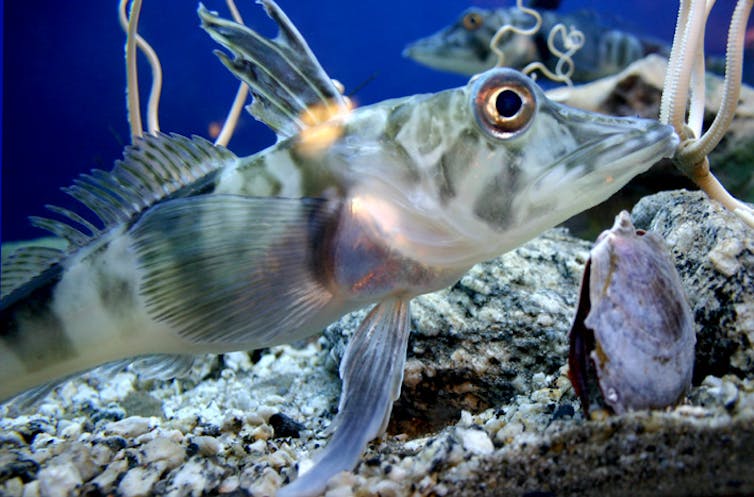
This new agreement provides developing states, whether coastal or landlocked, with rights to the benefits of marine genetic resources. It does not establish an administrative body comparable to that created for seabed mining, however. Instead, non-monetary benefits, such as access to samples and digital sequence information, will be shared and researchers from all countries will be able to study them for free.
Economic inequality between countries will still determine who can access these samples to a large extent, and sharing DNA sequencing data will be further complicated by the convention on biological diversity, another global treaty. The BBNJ agreement will establish a financial mechanism for sharing the monetary benefits of marine genetic resources, though experts involved in the negotiations are still parsing what it will eventually look like.
The best hope for robust marine protected areas and equitable use of marine genetic resources lies in rapid implementation of the BBNJ agreement. But making it effective will depend on how its provisions are interpreted in each country and what rules of procedure are established. In many ways, the hard work is beginning.
Although areas beyond national jurisdiction are remote for most people they generate the air you breathe, the food you eat and moderate the climate. Life exists throughout the ocean, from the surface to the seabed. Ensuring it benefits everyone living today, as well as future generations, will depend on this next phase of implementing the historic treaty.

Don’t have time to read about climate change as much as you’d like?
Get a weekly roundup in your inbox instead. Every Wednesday, The Conversation’s environment editor writes Imagine, a short email that goes a little deeper into just one climate issue. Join the 10,000+ readers who’ve subscribed so far.![]()
Cymie Payne, Associate Professor of Human Ecology and Law, Rutgers University and Robert Blasiak, Research Fellow in Ocean Management, Stockholm University
This article is republished from The Conversation under a Creative Commons license. Read the original article.
When is a nature reserve not a nature reserve? When it’s already been burned and logged
David Lindenmayer, Australian National University and Chris Taylor, Australian National UniversityAustralia has the world’s worst mammal extinction record, with nearly 40 native mammal species lost since European colonisation. By contrast, the United States has lost three.
Last year, the federal Labor government made a welcome commitment to stop further extinctions. One essential tool to do this is protecting habitat in dedicated conservation reserves.
Reserves can and do work – especially when well designed and then well managed. By some estimates, a quarter of the world’s bird species have been saved from extinction because of conservation reserves. Here too, the government is to be commended for plans to conserve 30% of the continent by 2030.
In light of this, we analysed Victoria’s newest conservation reserves - called Immediate Protection Areas - designed to conserve forest biodiversity in Victoria as the state prepares to phase out native forest logging by 2030.
We found Immediate Protection Areas didn’t do what they were supposed to do. The protected areas were small, and well short of the area needed to adequately conserve threatened species. Many Immediate Protection Areas were established in forests already burned, logged, or both, meaning their value as habitat was limited. Some areas even appeared to have been chosen because they were no longer needed for logging, rather than for their conservation value.
As we accelerate plans to protect more Australian habitat, we must watch for problems like this. Land with high conservation value must be prioritised for protection.
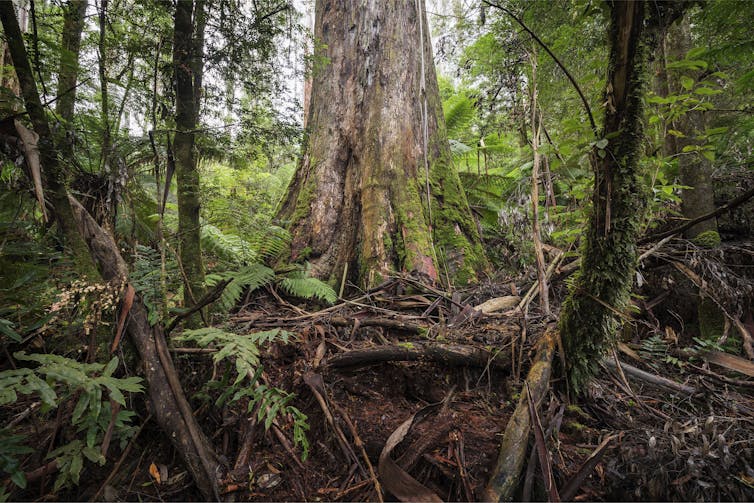
What Were These New Conservation Reserves Meant To Do?
Victoria’s state government has pledged to conserve biodiversity. This includes measures such as protecting the critically endangered Leadbeater’s Possum, ambitious investments to protect the Southern Greater Glider, and ending native forest logging by 2030.
As a prelude, the government established Immediate Protection Areas to better protect forest species from the impacts of logging.
We compared the known and mapped ranges of threatened species against the new conservation reserve areas. We wanted to see where 53 threatened species – including animals such as Leadbeater’s Possum and Southern Greater Glider – were most likely to occur. We also examined what had happened to these areas previously, to determine their habitat value. Had they been logged or burned?
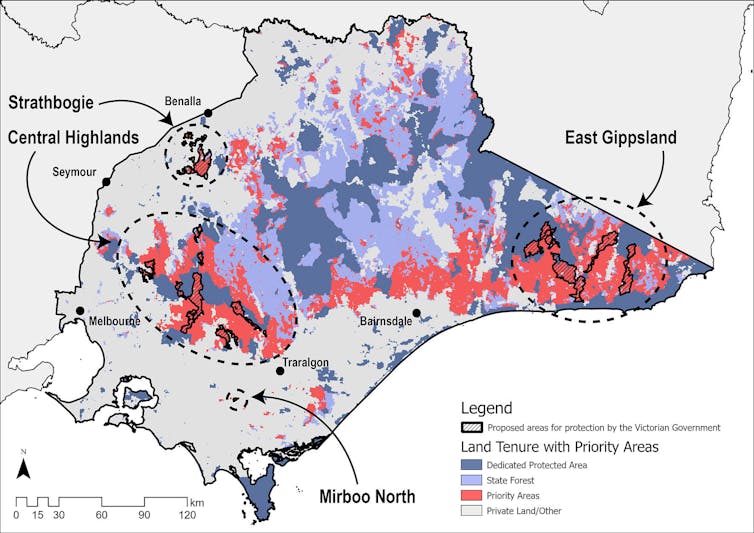
The results were sobering. The Immediate Protection Areas, combined with Victoria’s existing set of formal conservation reserves, fell well short of adequately protecting remaining areas of habitat for 23 of the 53 species analysed, such as the Southern Greater Glider, Leadbeater’s Possum, and Barred Galaxias.
This wouldn’t matter so much if the forests outside Victoria’s existing parks and reserves weren’t under pressure from continued industrial-scale logging of native forests by the state-owned forestry business, VicForests.
But they are. And worse, areas of highest conservation value for threatened forest-dependent species, such as the Central Highlands north east of Melbourne, and East Gippsland in the far east of Victoria, will actually be targeted for logging under the Timber Release Plan.
These high conservation value areas are important because they provide critical habitat for rare and threatened species, including endemic species found nowhere else.
Even as native forest logging is supposedly winding down, a major conflict between logging and conservation remains.
VicForests is legally bound to supply 350,000 cubic metres of logs from native forests to industry until 2030. This is the same year the Victorian government intends to cease native forest logging in Victoria.
In 2020, VicForest’s senior legal counsel testified in court that VicForests would have to shut down all its operations in the Central Highlands if it couldn’t continue to log threatened species’ habitat.
This is at at odds with both federal and state governments’ commitment to stop extinctions. Logging the remaining high conservation value habitat is going to accelerate rather than prevent extinctions.
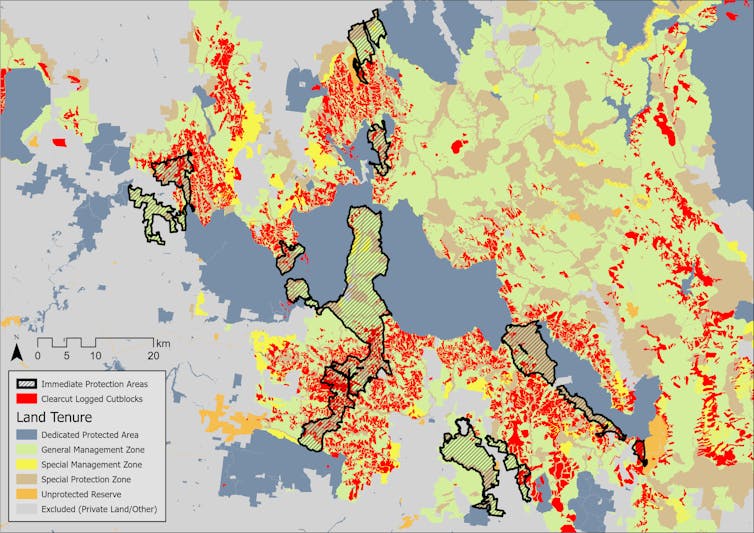
Protect All Remaining Habitat For Species On The Edge
An outsider might wonder why there has to be conflict. Aren’t there enough native forests to sustain seven more years of logging, especially now these Immediate Protection Areas have been established?
For many species, the answer is no. The number of sites occupied by species teetering on the edge of extinction, such as Leadbeater’s Possum, has fallen by half in the last 25 years. Logging is a major driver of its decline.
Protecting all Mountain and Alpine Ash forests where Leadbeater’s Possum occur should not be controversial. The federal government’s Threatened Species Scientific Committee declared in 2015 that the most effective way to prevent further decline and rebuild the possum population was to cease logging in Mountain Ash and Alpine Ash forests of the Central Highlands.
But this isn’t just a cautionary tale about logging in Victoria. Unless we’re careful, we’ll see the same story again and again.
Protecting 30% of Australian land by 2030, as the government intends, means rapidly protecting large areas of land. At present, around 20% of our land is protected in some way. Increasing this by half again in seven years is fast.
The danger is that governments will look for ways to rapidly boost the percentage of land area under protection without determining whether the land is effective for conservation.
As important as the size of the areas of land protected is what lives on it, and the ecosystem services it provides. To prevent extinctions in Australia, some ecosystems will need total protection of every fragment remaining, especially those under significant threat where key species are in marked decline. ![]()
David Lindenmayer, Professor, The Fenner School of Environment and Society, Australian National University and Chris Taylor, Research Fellow, Fenner School of Environment and Society, Australian National University
This article is republished from The Conversation under a Creative Commons license. Read the original article.
Study Into Global Daily Air Pollution Shows Almost Nowhere On Earth Is Safe
- Despite a slight decrease in high PM2.5 exposed days globally, by 2019 more than 70% of days still had PM2.5 concentrations higher than 15 μg/m³.
- In southern Asia and eastern Asia, more than 90% of days had daily PM2.5 concentrations higher than 15 μg/m³.
- Australia and New Zealand had a marked increase in the number of days with high PM2.5 concentrations in 2019.
- Globally, the annual average PM2.5 from 2000 to 2019 was 32.8 µg/m3.
- The highest PM2.5 concentrations were distributed in the regions of Eastern Asia (50.0 µg/m3) and Southern Asia (37.2 µg/m3), followed by northern Africa (30.1 µg/m3).
- Australia and New Zealand (8.5 μg/m³), other regions in Oceania (12.6 μg/m³), and southern America (15.6 μg/m³) had the lowest annual PM2.5 concentrations.
- Based on the new 2021 WHO guideline limit, only 0.18% of the global land area and 0.001% of the global population were exposed to an annual exposure lower than this guideline limit (annual average of 5 μg/m³) in 2019.
Drones Detect Moss Beds And Changes To Antarctica Climate
Pioneering Study Shows Flood Risks Can Still Be Considerably Reduced If All Global Promises To Cut Carbon Emissions Are Kept
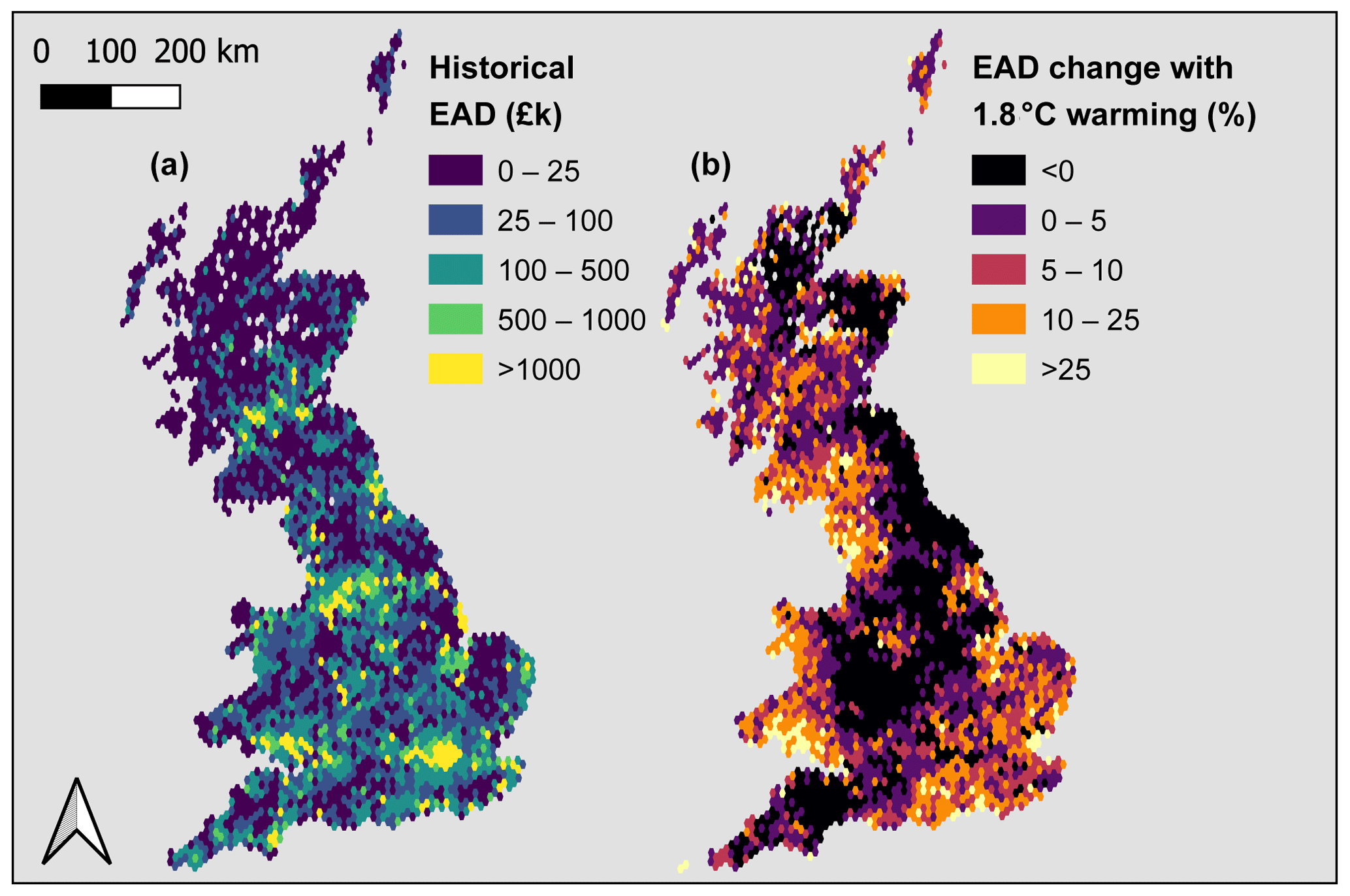
Solar power can cut living costs, but it’s not an option for many people – they need better support
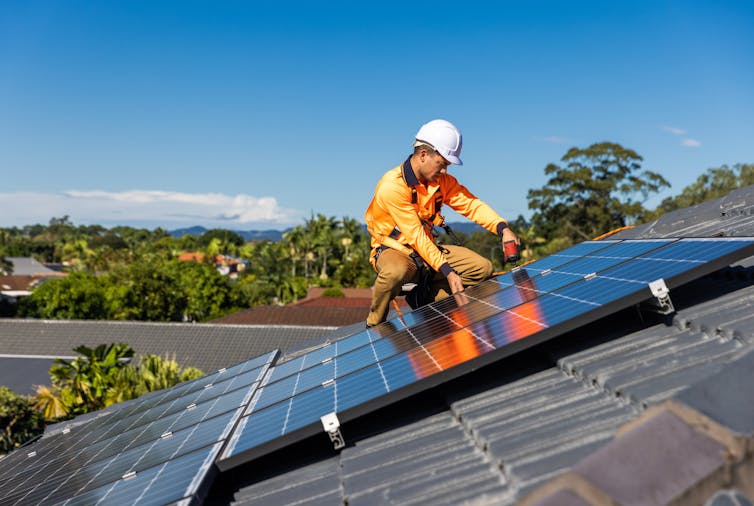
As the cost of living soars, many Australian households are turning to rooftop solar to cut their energy costs. A Pulse of the Nation survey last month showed about 29% of Australians have installed or are considering installing solar panels on their homes.
The same survey shows one in five Australians can’t afford to adequately heat or cool their homes. Many are also unable to install energy-saving options such as solar panels or insulation because of the upfront costs or because they are renters who cannot make changes to the dwelling. Among those who are financially stressed, earn less than A$50,000 or are between the ages of 18 and 34, a large majority do not intend to install energy-saving options, largely because they cannot afford them.
Renewable energy is not just critical for saving on energy bills, but also for mitigating climate change and fostering sustainable development. However, the reality is access to solar power is not equitable for all Australians. Our new research shows without better government support, many people will miss out on its benefits.
What Does Equity In Rooftop Solar Uptake Look Like?
Our research focuses on how to make access to rooftop solar more equitable.
It is important to distinguish between equity and equality. Equality means every household will be given the same resources or opportunities. For example, every household would receive the same subsidy to install solar panels.
Equity refers to fairness. The idea of equity recognises not all households start from the same place. Instead, adjustments to imbalances might be required.
In the context of solar adoption, equity would mean every Australian can benefit from solar power. Any subsidies or other support would be adjusted based on individual circumstances.
To better understand how it affects the adoption of solar panels, we looked at several aspects of inequity. These include financial situation, renting status, gender, education and ethnicity.
For our study, we collected 167 studies worldwide on household solar panel adoption to determine what we know about how it’s affected by these aspects of inequity.
Solar Power Equity Has Been Neglected
Our findings show there is very limited in-depth data and research on this issue in Australia. Australian studies on residential solar uptake account for 20 (12%) of the 167 studies.
Research in Australia tends to focus on equity related to income. Of the 20 Australian studies, six find a positive link between income and solar panel adoption, four find a negative link, five show inconclusive results and five omit income altogether.
These mixed results can be explained, in part, by the fact that a range of factors impact whether a household can afford solar power. For example, a somewhat higher household income does not automatically mean that a household has less bill stress and enough accumulated wealth to afford the upfront cost of installing solar power.
Few studies offer a deeper analysis of variables such as education or ethnicity. For Australia, only five studies looked at education and only one at ethnicity. There is a lack of data on solar uptake among Aboriginal and Torres Strait Islander people.
This limited research does not allow for definite conclusions about how these variables impact rooftop solar uptake.
Energy-saving installations in investment properties have also received limited attention. Many Australian renters report their dwellings have extremely poor insulation. This leads to hot indoor temperatures in summer and cold conditions in winter.
Renters typically have limited ways to fix these problems. The only available options for many renters are air conditioning and portable heaters powered by traditional energy sources, which increases electricity bills.
What Policies Can Improve Solar Equity?
Policies that could improve equity in rooftop solar access include:
direct financial support for low-income households that otherwise could not afford solar power
a variety of other financial incentives such as solar rebates
community solar programs that allow households to share the benefits.
Some programs are in place to help home owners on low incomes to install solar systems. For example, New South Wales has a “Solar for low-income households” program. Eligible individuals can get a free 3-kilowatt solar system in return for giving up the Low-Income Household Rebate for ten years. South Australia had a “Switch for Solar” trial, for which applications closed on August 31 2022.
However, to access these schemes Australians must first overcome one difficult hurdle: home ownership.
In addition, a focus on income alone can be problematic. Directing subsidies to low-income households alone misses households with low wealth that are above an income threshold.
The Australian government has promised new policy approaches. Its Powering Australia Plan pledged $102.2 million for community solar banks. These are community-owned projects to improve access for those currently locked out of solar power. Households can lease or buy a plot in these solar banks, instead of using their own rooftops.

The success of such projects will depend on whether they are accessible to and affordable for everyone.
More data collection is needed to identify priorities for policy action on energy equity. This can include a new Household Energy Consumption Survey (the Australian Bureau of Statistics conducted such a survey until a decade ago), broader analysis by researchers to consider equity dimensions, and collaboration between researchers and policymakers to trial new policies.![]()
Martina Linnenluecke, Professor of Environmental Finance at UTS Business School, University of Technology Sydney; Mauricio Marrone, Associate Professor, Department of Actuarial Studies and Business Analytics, Macquarie University, and Rohan Best, Senior Lecturer, Department of Economics, Macquarie University
This article is republished from The Conversation under a Creative Commons license. Read the original article.
First look at the new settlement rule of Australia’s electricity market, has it worked?
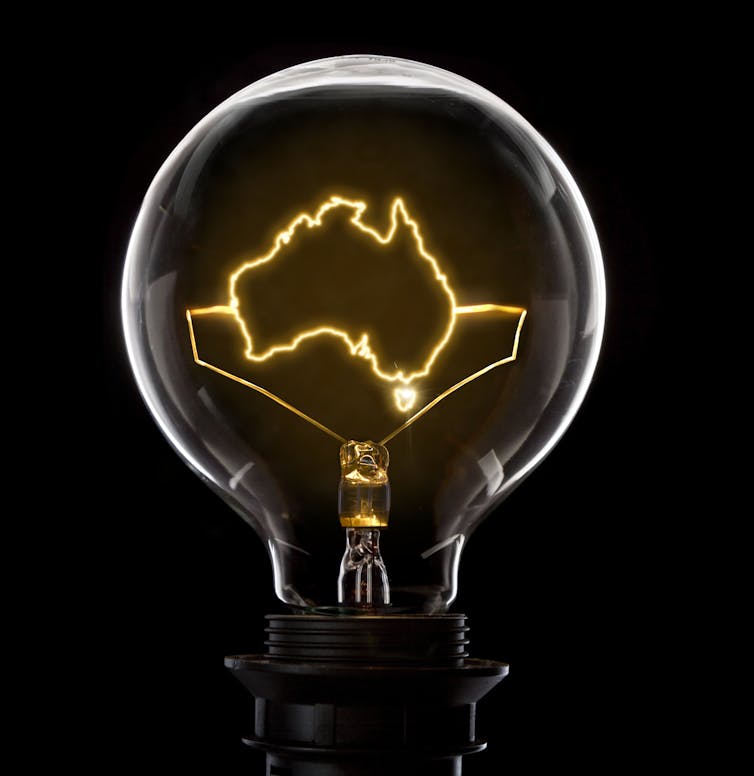
You might not realise this when you flick your switch at home, but Australian electricity generators are forever locked in a bidding war. They compete for the right to supply electricity on the spot market. The cheapest bids win and electricity from those generators is supplied, or “dispatched”, to the grid in five-minute intervals.
This means that every five minutes, the electricity grid is rebalanced to ensure supply meets demand. Too little supply causes blackouts; too much causes tripping (and more blackouts).
But until recently, the price paid for wholesale electricity (the settlement price) on the Australian National Electricity Market (NEM) was averaged over six five-minute intervals (30 minutes). (Australia is unusual in this regard. Many grids elsewhere such as in Europe operate forward or day-ahead markets, where supply is planned in advance.)
That worked fine in the early days, but when supply started to fluctuate more wildly with the advent of intermittent renewable energy, so did the bidding war. Some generators starting gaming the system, pushing prices sky-high. Retailers complained.
So when the NEM finally introduced five-minute settlement in October 2021, it was a big deal. There was a great deal of excitement. Most commentators expected wholesale electricity prices to settle down, coal to lose market share, and batteries to boom. That’s mainly because the new system would be more efficient, rewarding cheap, nimble and flexible generators including batteries.
But what actually happened? Our analysis reveals the average spot price went up, not down, in Tasmania, Queensland, and New South Wales. Black coal-fired generators made more money on the spot market, not less. Flexible generators, especially batteries, did well too. (In the other NEM states, South Australia and Victoria, there was no significant change).
We argue further changes are needed to achieve the desired effects. These include increasing competition in the market (reducing the power of the three biggest electricity generators), building the infrastructure needed to support a green grid, and investing in more flexible and fuel-efficient technologies.
Greening The Grid
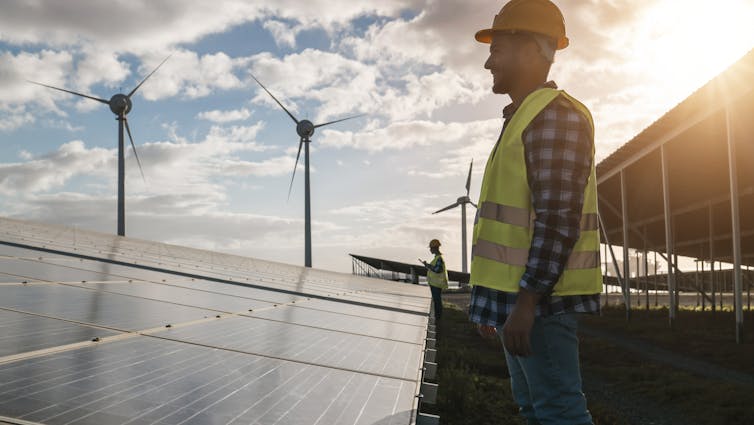
The NEM opened in 1998. The market adopted a 30-minute settlement rule at the time, because five-minute settlement would have pushed the limits of metering and data-processing capabilities.
But as the share of renewable energy grew, it became increasingly apparent that more flexible technology would be needed to cope with intermittent solar and wind power.
Problems included frequent price spikes, blackouts, power tripping, and “gaming” behaviours by major generators.
Energy retailers became frustrated by this gaming behaviour in particular, and complained to the authorities, prompting the rule change. Previously, coal and gas generators could send dispatch prices through the roof in one interval, so that when prices were averaged over the 30 minutes, it made the final trading price high. One way of doing this was to create artificial scarcity of supply, by withdrawing generation to raise spot prices.
When a price spike occurred, generators would then pile in by offering a lower price for the remainder of the 30-minute settlement period.
Five-minute settlement aimed to resolve these issues and better support the integration of wind and solar power into the electricity grid, ultimately making electricity more affordable for customers.
The new rule would also encourage investment in faster response technologies such as batteries.
Our study adds to the understanding of early effects of this regulatory change in the NEM. This will support the transition to clean energy generation, and inform policy for future electricity markets that offer stability, security and lower prices. We also propose courses of action to facilitate more effective adaptation to the rule change.
Did The New Rule Work?
The market had four years to prepare for the rule change, allowing generators to adjust their operations.
When five-minute settlement came in on October 1 2021, there was no substantial immediate effect.
However, within the first eight months of the change, the market started to adjust. We found that five-minute settlement led to an average spot price increase (not decrease) in Tasmania, Queensland and New South Wales.
That’s because generators no longer had a financial incentive to rebid at a very low price after a price spike, as they had done in a 30-minute trading interval. That was a strategy that caused significant fluctuation in the spot price.
Promisingly, the implementation of five-minute settlement had no measurable impact on the intensity of electricity price fluctuations. That suggests the new rule may have been effective in maintaining price stability.
So, in these early stages of the rule change, wholesale electricity customers are actually paying more, but the price has been more stable.
The impact on retail prices remains uncertain. The retailers’ costs of buying electricity and managing price risks are one component of what costumers pay in their energy bills. In 2020–21, it accounted for about a third of their bill. So if these effects persist, there is a possibility these higher prices will be passed on to consumers as well.
We also found that variable and flexible generators, especially batteries, took advantage of their flexibility to capture more revenue from the spot market. Gas generators’ revenue barely changed, but that could be because less flexible gas generators are lumped in together with highly flexible gas generators.
Surprisingly, the revenue earned by black coal-fired generators also increased. We suspect generators changed their operations and bidding strategies to align with the five-minute settlement rule. However, revenue for coal-fired generators is still likely to fall over the medium to long term.

Three Ways To Improve Five-Minute Settlement
It will take time to see the full effect of the rule change on the wholesale and retail electricity markets. However, we think the following changes are needed to fully realise the benefits of five-minute settlement:
Market concentration. The NEM is a concentrated market. The three largest generators, AGL Energy, Origin Energy and Energy Australia, hold a substantial market share. Together, they supply about 80% of the generated energy. Policies that promote competition are key to realising the benefits of five-minute settlement.
Supporting infrastructure. Five-minute settlement is expected to increase the operational cost of generating coal-fired power. That’s because ageing power plants would need to be upgraded to be able to compete during periods of fluctuating demand. Renewable generators, on the other hand, have extremely low operating costs, largely due to having no fuel costs. Coal-fired generators are likely to lose revenue and leave the market much earlier than expected. Firming and flexible demand technologies such as energy storage systems (pumped hydro, batteries or solar thermal) can effectively respond to the new market conditions and fill the gap.
Fuel-efficient and flexible technologies. Technologies such as batteries, pumped hydro and aero-derivative gas turbines operate more effectively in a five-minute settlement design. The recent rise in gas prices also necessitates investment in flexible and fuel-efficient technologies, such as reciprocating gas engines.
Without policies to address these three areas, we believe five-minute settlement is unlikely to offer substantial benefits to the market.![]()

Christina Nikitopoulos, Associate professor, Finance Discipline Group, University of Technology Sydney and Muthe Mwampashi, PhD Candidate, University of Technology Sydney
This article is republished from The Conversation under a Creative Commons license. Read the original article.
Buildings used iron from sunken ships centuries ago. The use of recycled materials should be business as usual by now
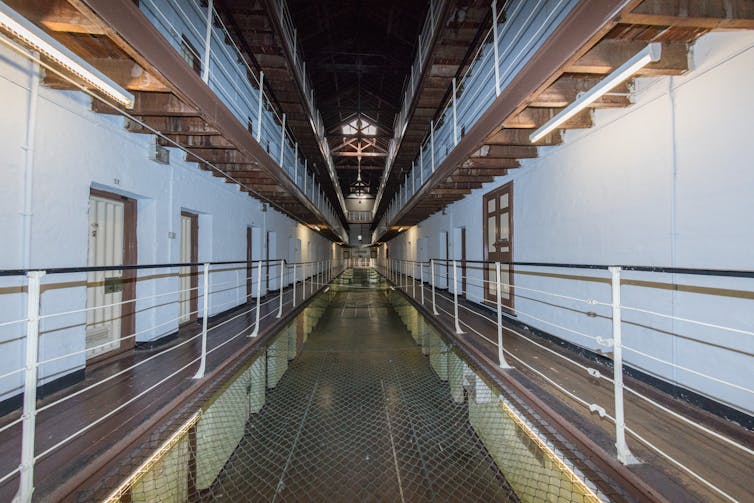
At Fremantle Prison in the 1850s, when metal was scarce, the prison gate and handrails were made from iron recovered from sunken ships. As I toured the prison recently, I reflected on how similar the situation was when COVID-19 disrupted building supply chains across Australia. The shortage of materials such as steel, which is still an issue, turned heads to using recycled steel, which would otherwise be exported overseas for full recovery.
Do we really needed material shortages for the construction industry to get serious about using products with recycled content? When resources are depleted, does it only then mean it’s time to go sustainable?
It is encouraging to see many state initiatives to recycle construction materials, such as Roads to Reuse in Western Australia. It offers a $5 per tonne incentive to use recycled materials such as road base and drainage rock for construction projects.
Are such programs enough to ensure the supply of construction materials is sustainable? No, and if you look back at the examples of the past two centuries, industry-wide reuse of such materials should have been business as usual by now.
What Is The Next Step?
As awareness of waste recycling benefits has risen, recovery rates have improved. The National Waste Report 2022 shows Australia now has an 80% recovery rate for construction and demolition waste. That waste, 29 million tonnes of it, comprises 38% of all waste produced in Australia.
These recycled materials are becoming increasingly available to the market, but it isn’t being widely used.
The next challenge is to increase the use of these products across the construction sector. But how? That’s the focus of our recently completed research project.
Showcasing The Use Of Recycled Materials
We conducted four case studies in Victoria and Western Australia. The two states produce about 46% of Australia’s construction and demolition waste.
The case studies are Burwood Brickworks Shopping Centre and Mordialloc Freeway in Victoria and the Tonkin Gap Project and OneOneFive Hamilton Hill in WA. They comprise two road projects, a shopping centre and a housing development. One goal of these projects is to showcase the possibilities for using recycled materials in the construction industry.
Brickworks Shopping Centre was completed in 2019 and has won numerous awards for its demonstration of sustainability. The project achieved full accreditation under the rigorous criteria of the Living Building Challenge.
The large amounts of recycled materials used in the project include crushed concrete in a sub-base of bitumen, salvaged timber for ceiling cladding, and recycled brick for the floor and as a finish on the building façade.
The head contractor explained the use of recycled products for these architectural features:
The end user, who’s the consumer at Burwood Brickworks, they can see it and it’s front of mind that, hey, we can reuse these things.
The Mordialloc project created a 9km freeway link between Dingley Bypass and Mornington Peninsula Freeway. Dubbed “Australia’s greenest freeway”, it was completed in 2021.
The project saved more than 300,000 tonnes of waste from going to landfill (or 3 hectares of land would have been needed for stockpiling). It used 675 tonnes of plastic waste in noise walls and drainage pipes and 21,000 tonnes of reclaimed asphalt in pavements.
A member of the project’s design team said:
It was a good example of taking a design and […] looking at ways where you could improve it in terms of using recycled materials. So I know it’s got a tagline as Australia’s greenest freeway at the moment, but I’m sure it’s just setting a precedent now. And almost all, if not all, future road projects will incorporate an increasing amount of recycled materials in them.
The Tonkin Gap Project is upgrading the Tonkin Highway east of Perth with extra lanes, new interchanges, bridges and a shared cycling and walking path.
By July 2022, the project had used 430,000 tonnes of recycled materials including:
296,000 tonnes of sand
105,000 tonnes of treated spoil
27,000 tonnes of crushed recycled concrete
1,200 tonnes of reclaimed asphalt pavement.
A Main Roads WA representative said:
The culture comes down to a lot of experience. You need to make sure that there’s a positive experience using the [recycled] product, and make sure that there’s enough training and education and awareness that can be delivered to the industry on using the product and what they need to do to use it safely.
OneOneFive Hamilton Hill redeveloped an old high school and neighbouring lands (11.9 hectares) as a residential estate. It was one of DevelopmentWA’s Innovation Through Demonstration projects to showcase sustainability in the built environment. It was recognised as a sustainable project by the national EnviroDevelopment initiative.
Recycled materials in this project included:
salvaged timber in landscaping features such as shade structures and seating
40,000 clay bricks and roof tiles reused as aggregates under the drainage infrastructure
old bricks in brick walls and a toilet block
crushed brick, tiles and concrete in the road sub-base
2,425 cubic metres of recycled concrete in retaining walls
400 tonnes of other recycled products in various constructions including temporary access roads.
The project’s client representative said:
We want to be showing that we’re pushing the boundaries and trying to, I suppose, provide demonstration projects that show what can be done within a normal commercial environment.
What Are The Barriers And How Do We Overcome Them?
Case study participants said the major barriers to optimal industry use of recycled materials include:
unsupportive regulations
limited availability of quality recycled materials
lack of expertise and understanding of their applications
inconsistency in recycled materials quality and performance.
They said education, investigation and demonstration activities together with effective project management planning could help overcome these barriers.
We thank our collaborators in the research Professor Tim Ryley (Griffith University), Dr Savindi Caldera (University of Sunshine Coast), Associate Professor Atiq Zaman (Curtin University) and Professor Peter S.P. Wong (RMIT University).![]()
Salman Shooshtarian, Lecturer, School of Property, Construction and Project Management, RMIT University and Tayyab Maqsood, Associate Dean and Head of of Project Management, RMIT University
This article is republished from The Conversation under a Creative Commons license. Read the original article.
‘Let’s get real’: scientists discover a new way climate change threatens cold-blooded animals
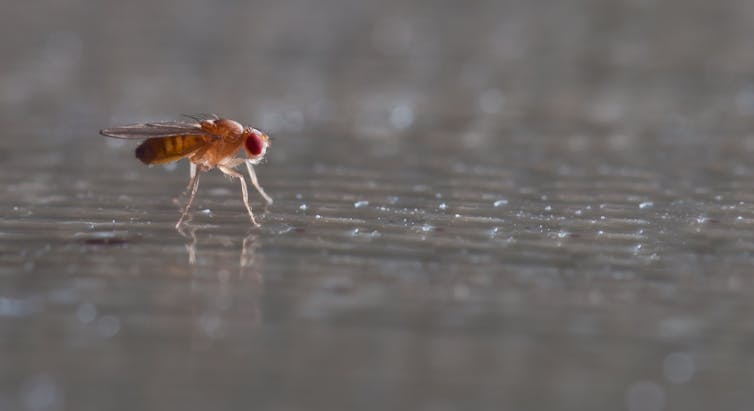
All animals need energy to live. They use it to breathe, circulate blood, digest food and move. Young animals use energy to grow, and later in life, to reproduce.
Increased body temperature increases the rate at which an animal uses energy. Because cold-blooded animals rely on the thermal conditions of their environment to regulate their body temperature, they’re expected to need more energy as the planet warms.
However, our new research, published today in Nature Climate Change, suggests temperature is not the only environmental factor affecting the future energy needs of cold-blooded animals. How they interact with other species will also play a role.
Our findings suggest cold-blooded animals will need even more energy in a warmer world than previously thought. This may increase their extinction risk.
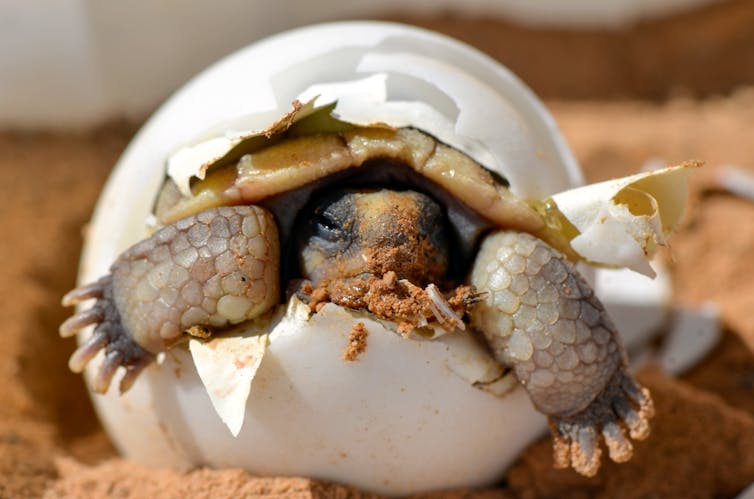
What We Already Know
The amount of energy animals use in a given amount of time is called their metabolic rate.
Metabolic rate is influenced by a variety of factors, including body size and activity levels. Larger animals have higher metabolic rates than smaller animals, and active animals have higher metabolic rates than inactive animals.
Metabolic rate also depends on body temperature. This is because temperature affects the rate at which the biochemical reactions involved in energy metabolism proceed. Generally, if an animal’s body temperature increases, its metabolic rate will accelerate exponentially.
Most animals alive today are cold-blooded, or “ectotherms”. Insects, worms, fish, crustaceans, amphibians and reptiles – basically all creatures except mammals and birds – are ectotherms.
As human-induced climate change raises global temperatures, the body temperatures of cold-blooded animals are also expected to rise.
Researchers say the metabolic rate of some land-based ectotherms may have already increased by between 3.5% and 12% due to climate warming that’s already occurred. But this prediction doesn’t account for the animals’ capacity to physiologically “acclimate” to warmer temperatures.
Acclimation refers to an animal’s ability to remodel its physiology to cope with a change in its environment.
But rarely can acclimation fully negate the effect of temperature on metabolic processes. For this reason, by the end of the century land-based ectotherms are still predicted to have metabolic rates about 20% to 30% higher than they are now.
Having a higher metabolic rate means that animals will need more food. This means they might starve if more food is not available, and leaves them less energy to find a mate and reproduce.

Our Research
Previous research attempts to understand the energetic costs of climate warming for ectotherms were limited in one important respect. They predominantly used animals studied in relatively simple laboratory environments where the only challenge they faced was a change in temperature.
However, animals face many other challenges in nature. This includes interacting with other species, such as competing for food and predator-prey relationships.
Even though species interact all the time in nature, we rarely study how this affects metabolic rates.
We wanted to examine how species interactions might alter predictions about the energetic costs of climate warming for cold-blooded animals. To do this, we turned to the fruit fly (from the genus Drosophila).
Fruit fly species lay their eggs in rotting plant material. The larvae that hatch from these eggs interact and compete for food.
Our study involved rearing fruit fly species alone or together at different temperatures. We found when two species of fruit fly larvae compete for food at warmer temperatures, they were more active as adults than adults that didn’t compete with other species as larvae. This means they also used more energy.
From this, we used modelling to deduce that species interactions at warmer global temperatures increase the future energy needs of fruit flies by between 3% and 16%.
These findings suggest previous studies have underestimated the energetic cost of climate warming for ectotherms. That means purely physiological approaches to understanding the consequences of climate change for cold-blooded animals are likely to be insufficient.

Let’s Get Real
Understanding the energy needs of animals is important for understanding how they’ll survive, reproduce and evolve in challenging environments.
In a warmer world, hotter ectotherms will need more energy to survive and reproduce. If there is not enough food to meet their bodies’ energy demands, their extinction risk may increase.
Clearly, we must more accurately predict how climate warming will threaten biodiversity. This means studying the responses of animals to temperature change under more realistic conditions.![]()
Lesley Alton, Research Fellow, Monash University and Vanessa Kellermann, Research fellow, Monash University
This article is republished from The Conversation under a Creative Commons license. Read the original article.
Crocodiles are uniquely protected against fungal infections. This might one day help human medicine too
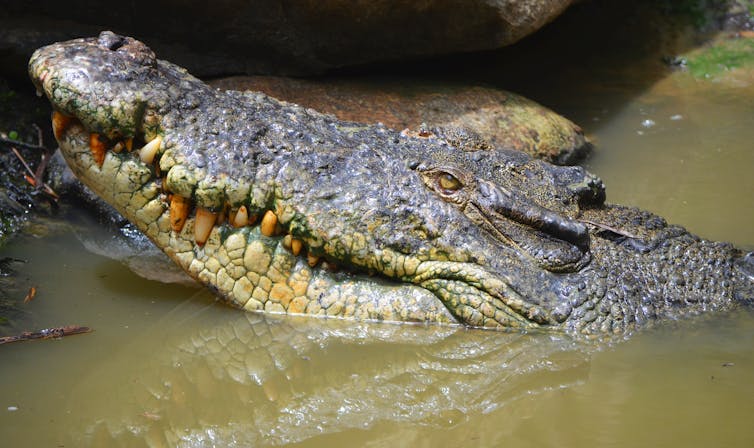
Over the millions of years crocodiles and their relatives have roamed our planet, they have evolved robust immune systems to help combat the potentially harmful microbes in the swamps and waterways they call home.
Our study, recently published in Nature Communications, takes a closer look at antimicrobial proteins called defensins, found in saltwater crocodiles. These proteins play a key role in the reptiles’ first line of defence against infectious disease.
As the threat of antibiotic-resistant microbes grows, so does our need for new and effective treatments. Could the defensins of these beasts hold the answers to help create a new wave of life-saving therapeutics?
What Are Defensins?
Defensins are small proteins produced by all plants and animals. In plants, defensins are usually made in the flowers and leaves, whereas animal defensins are made by white blood cells and in mucous membranes (for example in the lungs and intestines). Their role is to protect the host by killing infectious organisms.
Research into the defensins of different plant and animal species has found they can target a broad range of disease-causing pathogens. These include bacteria, fungi, viruses and even cancer cells.
The most common way defensins kill these pathogens is by attaching themselves to the outer membrane – the layer that holds the cell together. Once there, defensins create holes in the membrane, causing the cell contents to leak out, killing the cell in the process.
What’s Special About Crocodile Defensins?
Despite living in dirty water, crocodiles rarely develop infections even though they often get wounded while hunting and fighting for territory. This suggests crocodiles have a potent immune system. We wanted to better understand how their defensins have adapted over time to protect them in these harsh environments.
By searching through the genome of the saltwater crocodile, we found that one particular defensin, named CpoBD13, was effective at killing the fungus Candida albicans – the leading cause of human fungal infections worldwide. Although some plant and animal defensins have previously been shown to target Candida albicans, the mechanism behind CpoBD13’s antifungal activity is what makes it unique.
That’s because CpoBD13 can self-regulate its activity based on the pH of the surrounding environment. At neutral pH (for example, in the blood) the defensin is inactive. However, when it reaches a site of infection which has a lower, acidic pH, the defensin is activated and can help clear the infection. This is the first time this mechanism has been observed in a defensin.
Our team discovered this mechanism by revealing the structure of CpoBD13 using a process called X-ray crystallography. This involves “shooting” lab-grown protein crystals with high-powered X-rays, which we were able to do at the Australian Synchrotron.

Are Fungi Really A Threat To Human Health?
In comparison to bacterial and viral infections, fungal infections are often not seen as serious. After all, pandemics throughout human history have only ever been caused by the former. Indeed, fungi are most commonly known in the general public for causing athlete’s foot and toenail infections – hardly life-threating conditions.
But fungi can pose severe problems to human health, particularly in people with impaired immune systems. Globally, approximately 1.5 million deaths per year are attributed to fungal infections.
Our current arsenal of antifungals is limited to only a handful of drugs. Furthermore, we haven’t had a new class of antifungal treatments since the early 2000s. To make matters even worse, overuse of the antifungal medicines we do have has led to some drug-resistant fungal strains.
Rising global temperatures have also made once cooler regions more hospitable to pathogenic fungi. Climate change has even been linked with the emergence of new drug-resistant species, such as Candida auris.
A Long Way From Crocs To The Clinic
In the hunt for new medicines, our study and those like it are important for finding potential future antibiotics. By characterising the defensins of crocodiles, we have provided the groundwork needed to develop CpoBD13 into an effective antifungal. However, undertaking clinic trials is a long and costly process. From the initial discovery, it can take between five and 20 years to get a new drug approved.
Currently, protein-based treatments can sometimes unintentionally harm a person’s healthy cells. By using our knowledge of the crocodile’s defensins, we could potentially engineer other proteins to take on CpoBD13’s pH-sensing mechanism. Thus, they would only “turn on” upon reaching the infection.
Although there is much work to do before we see crocodile defensins in the clinic, we hope to one day harness the unique primal power of the crocodile’s immune system to aid in the global fight against infectious disease.![]()
Scott Williams, PhD Candidate in Biochemistry, La Trobe University and Mark Hulett, Professor and Head of Department, La Trobe University
This article is republished from The Conversation under a Creative Commons license. Read the original article.
How we discovered flamingos form cliques, just like humans
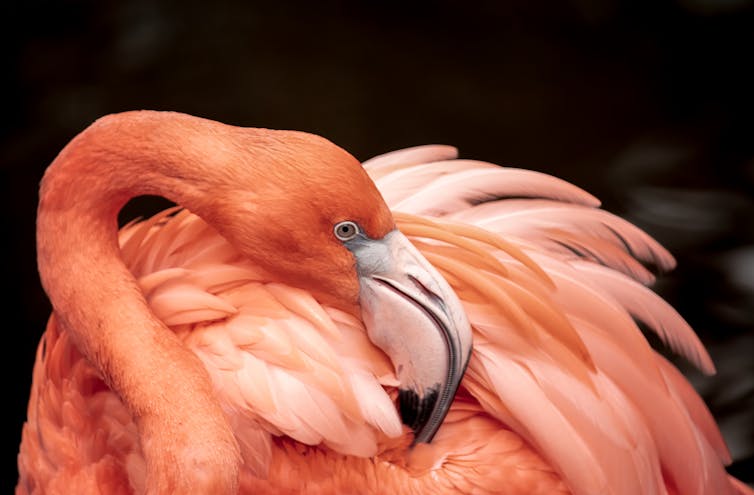
As social animals we have an innate understanding of the joy a good friendship can bring. So it’s unsurprising humans delight in seeing such closeness between animals. We can see ourselves reflected in the behaviour of cuddling chimpanzees, but a new wave of research is showing less relatable animals have pals too.
Our team’s new research found that while flamingos appear to live in a very different world to humans, they form cliques much like human ones. Like us, flamingos have a need to be social, are long lived (sometimes into their 80s) and form enduring friendships. Paul Rose’s previous work indicates captive flamingos are as picky about their friends as we are. They spend their time with preferred companions and depend on them for support during squabbles with rivals.
A flamingo’s inner circle can include their breeding partner plus several friends. Flamingos will form both platonic and maybe even sexual bonds with birds of the same sex and can form mixed sexed trios and quartets. These relationships can last for decades.
Wise humans know you can’t be friends with everyone. Paul was keen to learn why the flamingos formed friendships with some birds but not others. Animals choose their companions according to all sort of rules. Some of them do it by body length, for example guppies, others by age, such as in albatrosses. Personality impacts friend choice in many species such as chimpanzees (and, of course, humans).
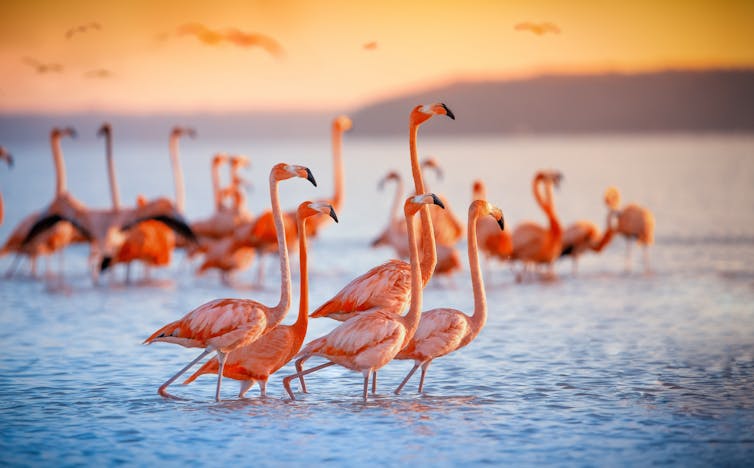
Throughout his project studying long term flamingo friendships, Paul noticed flamingos living on Wildfowl and Wetlands Trust (WWT) reserves (and indeed those that live in zoos) formed cliques not unlike children in a playground. There were the popular kids, the bullies, the quiet ones in the corner… always the same birds and nearly always together. This provided a perfect opportunity to test if these personality cues might help explain how flamingos find their friendship groups.
Fionnuala McCully was recruited to address this question as part of her masters in animal behaviour. She set about documenting the dramatic lives of the Chilean and Caribbean flamingos housed at WWT Slimbridge in Gloucestershire, south-west England. Each bird carried a leg ring with a unique code, which she used to tell them apart and establish who was spending time with who. Working out these friendship groups took a lot of observation – four months to be exact.
By scrutinising the birds’ behaviour over the days and months, Fionnuala built a personality profile for every flamingo in each flock. Aggressive birds would often be spotted intimidating their flock mates, while submissive birds avoided conflict. Then, we used a technique called social network analysis to investigate the relationships within each flock, and whether personality could explain the friendships.
The answer was yes. The flamingos in both flocks tended to have friends who where similar in personality. In the Caribbean flock, the importance of personality ran deeper. Aggressive, outgoing birds had more friends compared to quieter flockmates. These confident cliques also spent more time in each other’s company than less outgoing groups. Caribbean flamingos were more willing to start fights and enter a fray to defend their friends. In contrast, there was no evidence to suggest outgoing Chilean flamingos had more friends, nor were they more willing to aid their buddies during rows. This shows that what is true for one species may not be true for the others, even when they are closely related. Caribbean and Chilean flamingos, for example, both have the same body structure and foraging behaviour.
Our work demonstrates how flamingos need space and time to choose and maintain their own friendships. When a flock is large enough for all different personality types to be represented, each flamingo has the opportunity to find a social partner of its liking. Keeping flamingos within the same flock across several breeding seasons helps them work out “who is who” and get better at forming compatible relationships once they have worked out the social dimensions of the group. Flamingo breeding is a numbers game - the more birds, the greater the chance of success. So understanding choosy flamingo friendships can help staff take good care of captive flamingos and manage populations.
As behaviour scientists, we are discouraged from comparing animals directly to humans as it can increase the risk of biasing our work with human values. But sometimes we can’t help ourselves. For example, the king and queen of the Caribbean flock were a particularly outgoing mated pair who Fionnuala affectionately nicknamed “the Beckhams”.
More and more studies are revealing the complexity of animals’ social lives, which makes it harder to ignore our reflections in research findings. Using human behaviour as a blueprint might give us valuable clues into what animals need to be happy. This is applied more easily to some species (such as primates) than others. However it is critical that science doesn’t neglect the social needs of animals simply because they are considered less “clever” or “relatable” than other species in the zoo. If humans require friendships to be happy, is it really such a great leap to think that flamingos might need the same?![]()
Fionnuala McCully, PhD candidate in behavioural ecology, University of Liverpool and Paul Rose, Lecturer, University of Exeter
This article is republished from The Conversation under a Creative Commons license. Read the original article.
Pittwater Reserves: Histories + Notes + Pictorial Walks
A History Of The Campaign For Preservation Of The Warriewood Escarpment by David Palmer OAM and Angus Gordon OAM
A Stroll Through Warriewood Wetlands by Joe Mills February 2023
A Walk Around The Cromer Side Of Narrabeen Lake by Joe Mills
America Bay Track Walk - photos by Joe Mills
An Aquatic June: North Narrabeen - Turimetta - Collaroy photos by Joe Mills
Angophora Reserve Angophora Reserve Flowers Grand Old Tree Of Angophora Reserve Falls Back To The Earth - History page
Annie Wyatt Reserve - A Pictorial
Avalon's Village Green: Avalon Park Becomes Dunbar Park - Some History + Toongari Reserve and Catalpa Reserve
Bairne Walking Track Ku-Ring-Gai Chase NP by Kevin Murray
Bangalley Headland Bangalley Mid Winter
Banksias of Pittwater
Barrenjoey Boathouse In Governor Phillip Park Part Of Our Community For 75 Years: Photos From The Collection Of Russell Walton, Son Of Victor Walton
Barrenjoey Headland: Spring flowers
Barrenjoey Headland after fire
Bayview Baths
Bayview Wetlands
Beeby Park
Bilgola Beach
Botham Beach by Barbara Davies
Bungan Beach Bush Care
Careel Bay Saltmarsh plants
Careel Bay Birds
Careel Bay Clean Up day
Careel Bay Playing Fields History and Current
Careel Creek
Careel Creek - If you rebuild it they will come
Centre trail in Ku-ring-gai Chase National Park
Chiltern Track- Ingleside by Marita Macrae
Clareville Beach
Clareville/Long Beach Reserve + some History
Coastal Stability Series: Cabbage Tree Bay To Barrenjoey To Observation Point by John Illingsworth, Pittwater Pathways, and Dr. Peter Mitchell OAM
Cowan Track by Kevin Murray
Curl Curl To Freshwater Walk: October 2021 by Kevin Murray and Joe Mills
Currawong and Palm Beach Views - Winter 2018
Currawong-Mackerel-The Basin A Stroll In Early November 2021 - photos by Selena Griffith
Currawong State Park Currawong Beach + Currawong Creek
Deep Creek To Warriewood Walk photos by Joe Mills
Drone Gives A New View On Coastal Stability; Bungan: Bungan Headland To Newport Beach + Bilgola: North Newport Beach To Avalon + Bangalley: Avalon Headland To Palm Beach
Duck Holes: McCarrs Creek by Joe Mills
Dunbar Park - Some History + Toongari Reserve and Catalpa Reserve
Dundundra Falls Reserve: August 2020 photos by Selena Griffith - Listed in 1935
Elsie Track, Scotland Island
Elvina Track in Late Winter 2019 by Penny Gleen
Elvina Bay Walking Track: Spring 2020 photos by Joe Mills
Elvina Bay-Lovett Bay Loop Spring 2020 by Kevin Murray and Joe Mills
Fern Creek - Ingleside Escarpment To Warriewood Walk + Some History photos by Joe Mills
Iluka Park, Woorak Park, Pittwater Park, Sand Point Reserve, Snapperman Beach Reserve - Palm Beach: Some History
Ingleside
Ingleside Wildflowers August 2013
Irrawong - Ingleside Escarpment Trail Walk Spring 2020 photos by Joe Mills
Irrawong - Mullet Creek Restoration
Katandra Bushland Sanctuary - Ingleside
Lucinda Park, Palm Beach: Some History + 2022 Pictures
McCarrs Creek
McCarr's Creek to Church Point to Bayview Waterfront Path
McKay Reserve
Mona Vale Beach - A Stroll Along, Spring 2021 by Kevin Murray
Mona Vale Headland, Basin and Beach Restoration
Mount Murray Anderson Walking Track by Kevin Murray and Joe Mills
Mullet Creek
Narrabeen Creek
Narrabeen Lagoon Catchment: Past Notes Present Photos by Margaret Woods
Narrabeen Lagoon State Park
Narrabeen Lagoon State Park Expansion
Narrabeen Rockshelf Aquatic Reserve
Nerang Track, Terrey Hills by Bea Pierce
Newport Bushlink - the Crown of the Hill Linked Reserves
Newport Community Garden - Woolcott Reserve
Newport to Bilgola Bushlink 'From The Crown To The Sea' Paths: Founded In 1956 - A Tip and Quarry Becomes Green Space For People and Wildlife
Pittwater Reserves: The Green Ways; Bungan Beach and Bungan Head Reserves: A Headland Garden
Pittwater Reserves, The Green Ways: Clareville Wharf and Taylor's Point Jetty
Pittwater Reserves: The Green Ways; Hordern, Wilshire Parks, McKay Reserve: From Beach to Estuary
Pittwater Reserves - The Green Ways: Mona Vale's Village Greens a Map of the Historic Crown Lands Ethos Realised in The Village, Kitchener and Beeby Parks
Pittwater Reserves: The Green Ways Bilgola Beach - The Cabbage Tree Gardens and Camping Grounds - Includes Bilgola - The Story Of A Politician, A Pilot and An Epicure by Tony Dawson and Anne Spencer
Pittwater spring: waterbirds return to Wetlands
Pittwater's Lone Rangers - 120 Years of Ku-Ring-Gai Chase and the Men of Flowers Inspired by Eccleston Du Faur
Pittwater's Parallel Estuary - The Cowan 'Creek
Resolute Track at West Head by Kevin Murray
Resolute Track Stroll by Joe Mills
Riddle Reserve, Bayview
Salvation Loop Trail, Ku-Ring-Gai Chase National Park- Spring 2020 - by Selena Griffith
Seagull Pair At Turimetta Beach: Spring Is In The Air!
Stapleton Reserve
Stapleton Park Reserve In Spring 2020: An Urban Ark Of Plants Found Nowhere Else
Stony Range Regional Botanical Garden: Some History On How A Reserve Became An Australian Plant Park
The Chiltern Track
The Resolute Beach Loop Track At West Head In Ku-Ring-Gai Chase National Park by Kevin Murray
Topham Track Ku-Ring-Gai Chase NP, August 2022 by Joe Mills and Kevin Murray
Towlers Bay Walking Track by Joe Mills
Trafalgar Square, Newport: A 'Commons' Park Dedicated By Private Landholders - The Green Heart Of This Community
Tranquil Turimetta Beach, April 2022 by Joe Mills
Turimetta Beach Reserve by Joe Mills, Bea Pierce and Lesley
Turimetta Beach Reserve: Old & New Images (by Kevin Murray) + Some History
Turimetta Headland
Warriewood Wetlands and Irrawong Reserve
Whale Beach Ocean Reserve: 'The Strand' - Some History On Another Great Protected Pittwater Reserve
Wilshire Park Palm Beach: Some History + Photos From May 2022
Winji Jimmi - Water Maze

New Shorebirds WingThing For Youngsters Available To Download
A Shorebirds WingThing educational brochure for kids (A5) helps children learn about shorebirds, their life and journey. The 2021 revised brochure version was published in February 2021 and is available now. You can download a file copy here.
If you would like a free print copy of this brochure, please send a self-addressed envelope with A$1.10 postage (or larger if you would like it unfolded) affixed to: BirdLife Australia, Shorebird WingThing Request, 2-05Shorebird WingThing/60 Leicester St, Carlton VIC 3053.

 Shorebird Identification Booklet
Shorebird Identification Booklet
The Migratory Shorebird Program has just released the third edition of its hugely popular Shorebird Identification Booklet. The team has thoroughly revised and updated this pocket-sized companion for all shorebird counters and interested birders, with lots of useful information on our most common shorebirds, key identification features, sighting distribution maps and short articles on some of BirdLife’s shorebird activities.
The booklet can be downloaded here in PDF file format: http://www.birdlife.org.au/documents/Shorebird_ID_Booklet_V3.pdf
Paper copies can be ordered as well, see http://www.birdlife.org.au/projects/shorebirds-2020/counter-resources for details.
Download BirdLife Australia's children’s education kit to help them learn more about our wading birdlife
Shorebirds are a group of wading birds that can be found feeding on swamps, tidal mudflats, estuaries, beaches and open country. For many people, shorebirds are just those brown birds feeding a long way out on the mud but they are actually a remarkably diverse collection of birds including stilts, sandpipers, snipe, curlews, godwits, plovers and oystercatchers. Each species is superbly adapted to suit its preferred habitat. The Red-necked Stint is as small as a sparrow, with relatively short legs and bill that it pecks food from the surface of the mud with, whereas the Eastern Curlew is over two feet long with a exceptionally long legs and a massively curved beak that it thrusts deep down into the mud to pull out crabs, worms and other creatures hidden below the surface.
Some shorebirds are fairly drab in plumage, especially when they are visiting Australia in their non-breeding season, but when they migrate to their Arctic nesting grounds, they develop a vibrant flush of bright colours to attract a mate. We have 37 types of shorebirds that annually migrate to Australia on some of the most lengthy and arduous journeys in the animal kingdom, but there are also 18 shorebirds that call Australia home all year round.
What all our shorebirds have in common—be they large or small, seasoned traveller or homebody, brightly coloured or in muted tones—is that each species needs adequate safe areas where they can successfully feed and breed.
The National Shorebird Monitoring Program is managed and supported by BirdLife Australia.
This project is supported by Glenelg Hopkins Catchment Management Authority and Hunter Local Land Services through funding from the Australian Government’s National Landcare Program. Funding from Helen Macpherson Smith Trust and Port Phillip Bay Fund is acknowledged.
The National Shorebird Monitoring Program is made possible with the help of over 1,600 volunteers working in coastal and inland habitats all over Australia.
The National Shorebird Monitoring program (started as the Shorebirds 2020 project initiated to re-invigorate monitoring around Australia) is raising awareness of how incredible shorebirds are, and actively engaging the community to participate in gathering information needed to conserve shorebirds.
In the short term, the destruction of tidal ecosystems will need to be stopped, and our program is designed to strengthen the case for protecting these important habitats.
In the long term, there will be a need to mitigate against the likely effects of climate change on a species that travels across the entire range of latitudes where impacts are likely.
The identification and protection of critical areas for shorebirds will need to continue in order to guard against the potential threats associated with habitats in close proximity to nearly half the human population.
Here in Australia, the place where these birds grow up and spend most of their lives, continued monitoring is necessary to inform the best management practice to maintain shorebird populations.
BirdLife Australia believe that we can help secure a brighter future for these remarkable birds by educating stakeholders, gathering information on how and why shorebird populations are changing, and working to grow the community of people who care about shorebirds.
To find out more visit: http://www.birdlife.org.au/projects/shorebirds-2020/shorebirds-2020-program
Aussie Bread Tags Collection Points

History Of The Balmoral Beach Tramline
Published March 11, 2023 by BackTracks.Channel
The Balmoral Beach Tramline was one of the last tramlines to open in Sydney - in the last decade of the line trams ran from both Athol Wharf and Chatswood - and during peak hours some ran from Wynyard.
Express Yourself 2023
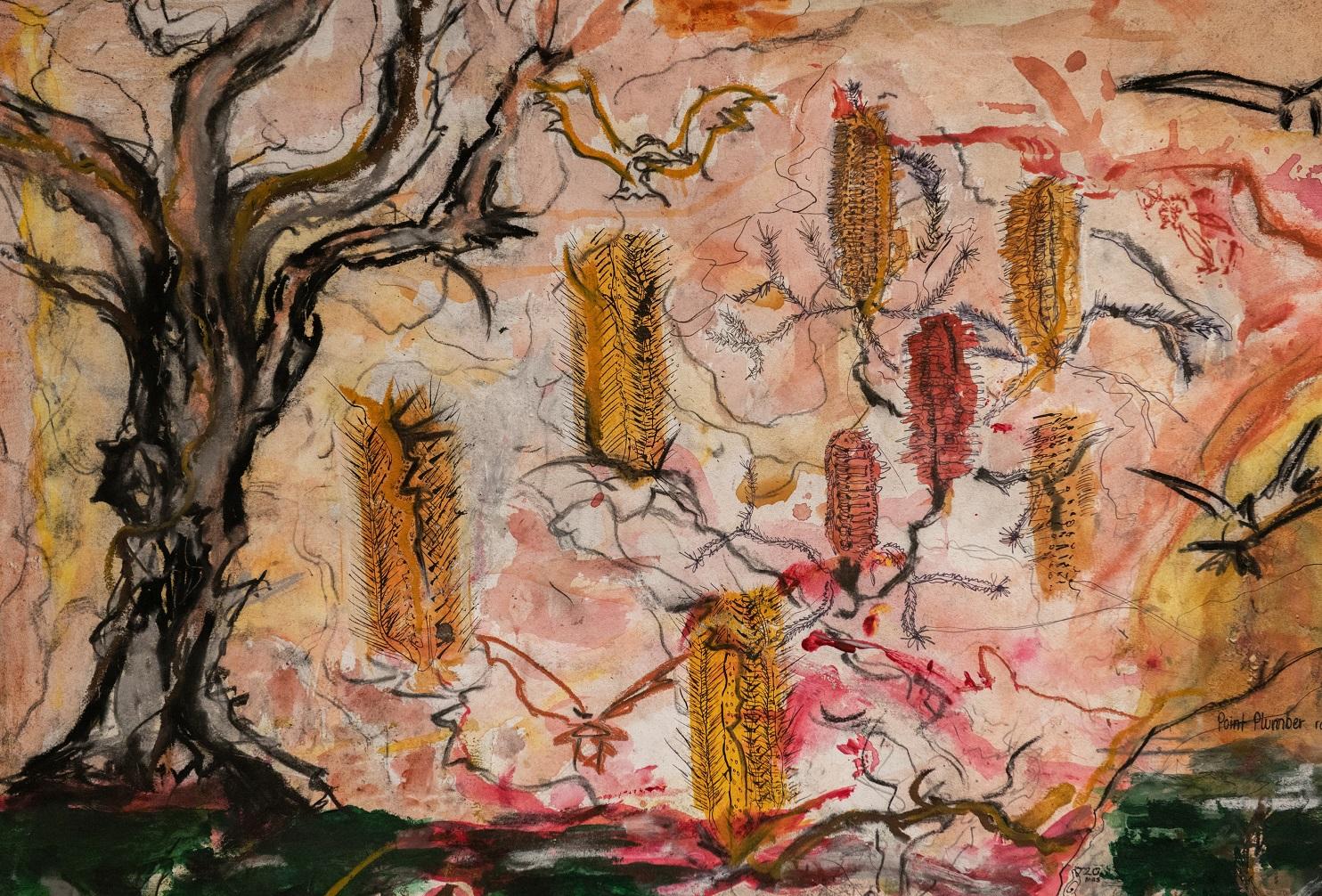
Newport - Circa 1880-1890
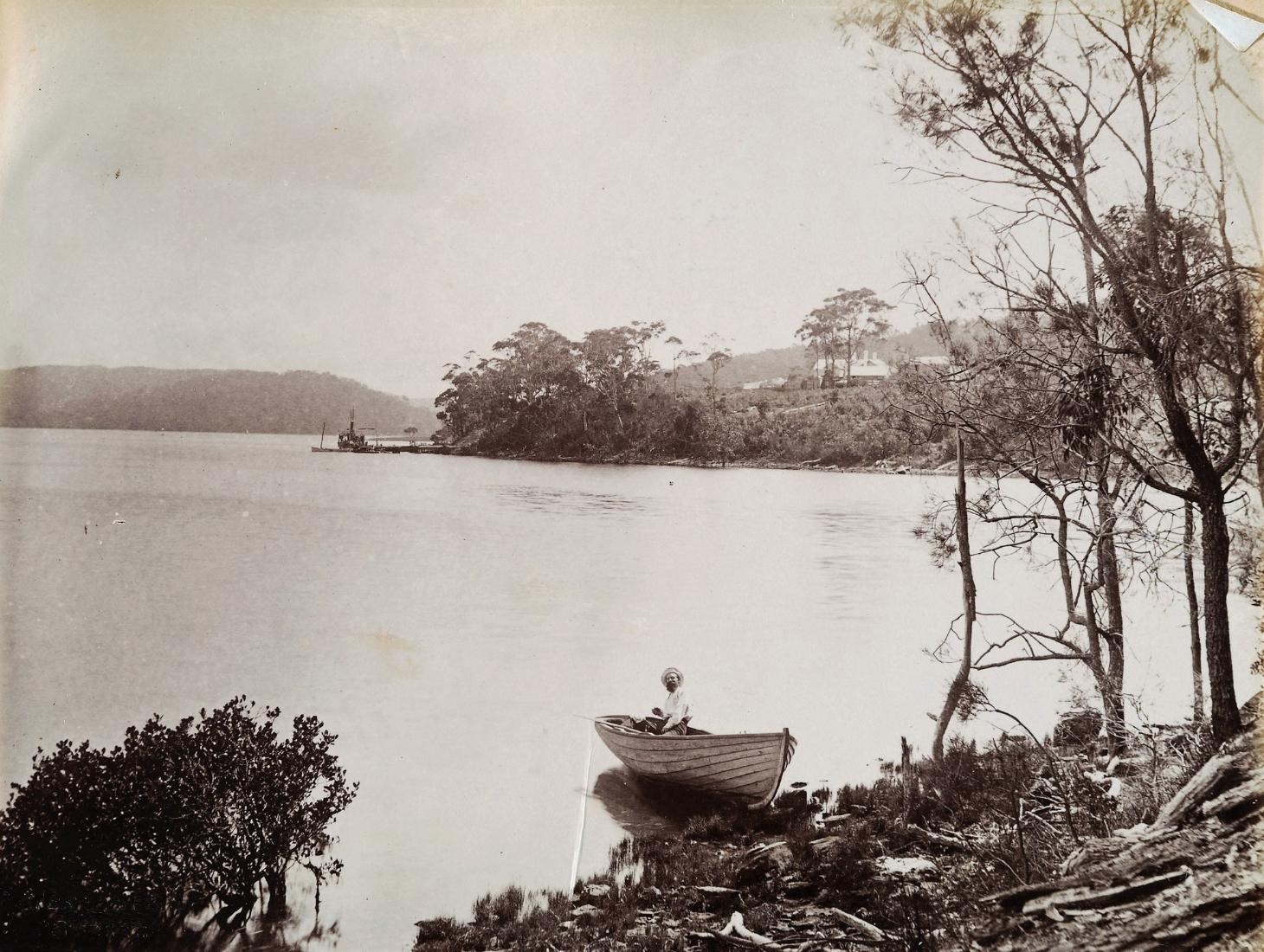
Photograph of 'Newport wharf', circa 1880-1890 (probably by Henry King who photographed numerous places around Pittwater during these years)
This photograph is one of 147 albumen prints made by some of the most significant photographers who worked in New South Wales during the 19th century. This object is also part of the Royal Australian Historical Society (RAHS) collection which was donated to the Powerhouse Museum in 1981. From Album containing photographic prints of New South Wales scenes.
Visit: Photographers of Early Pittwater: Henry King
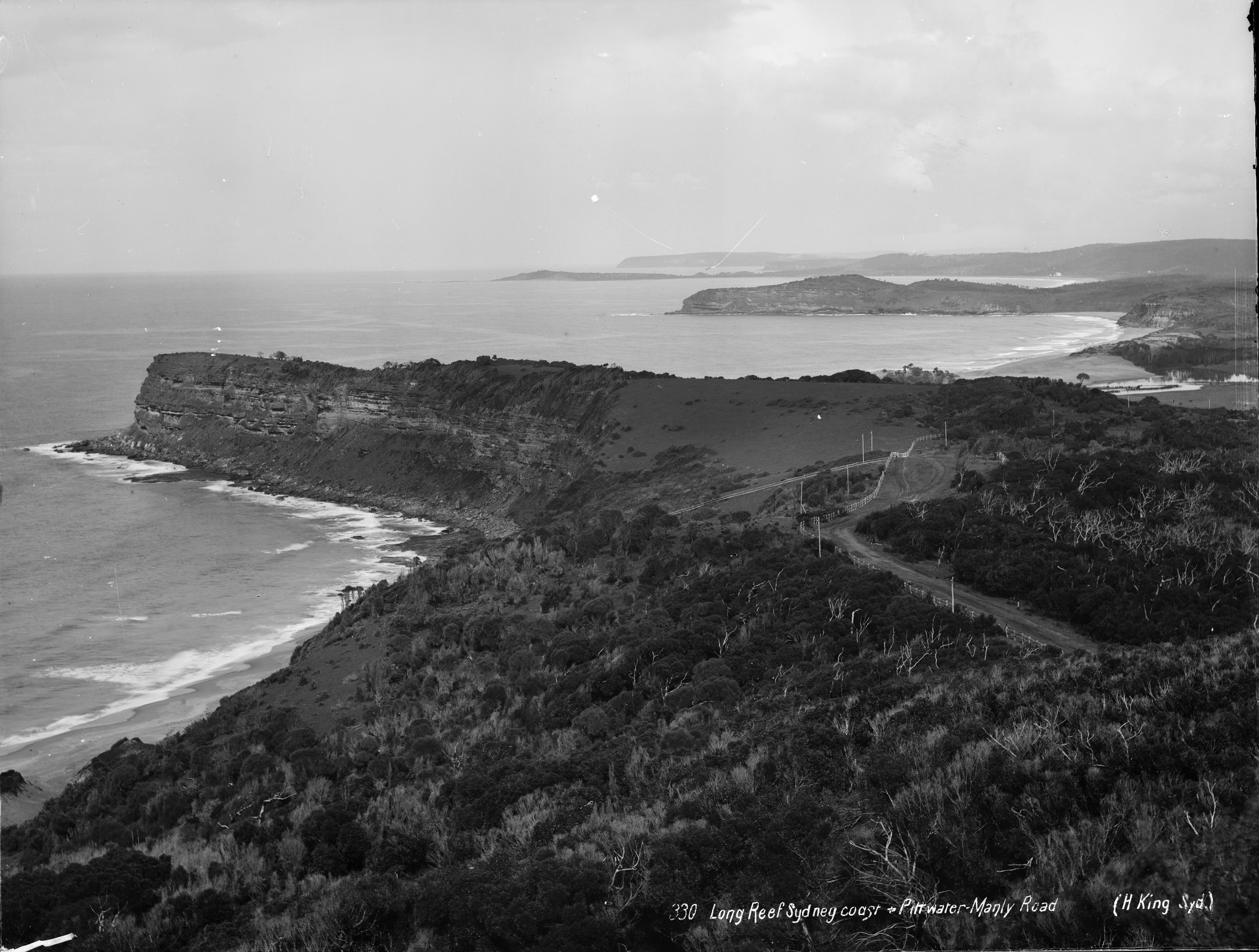
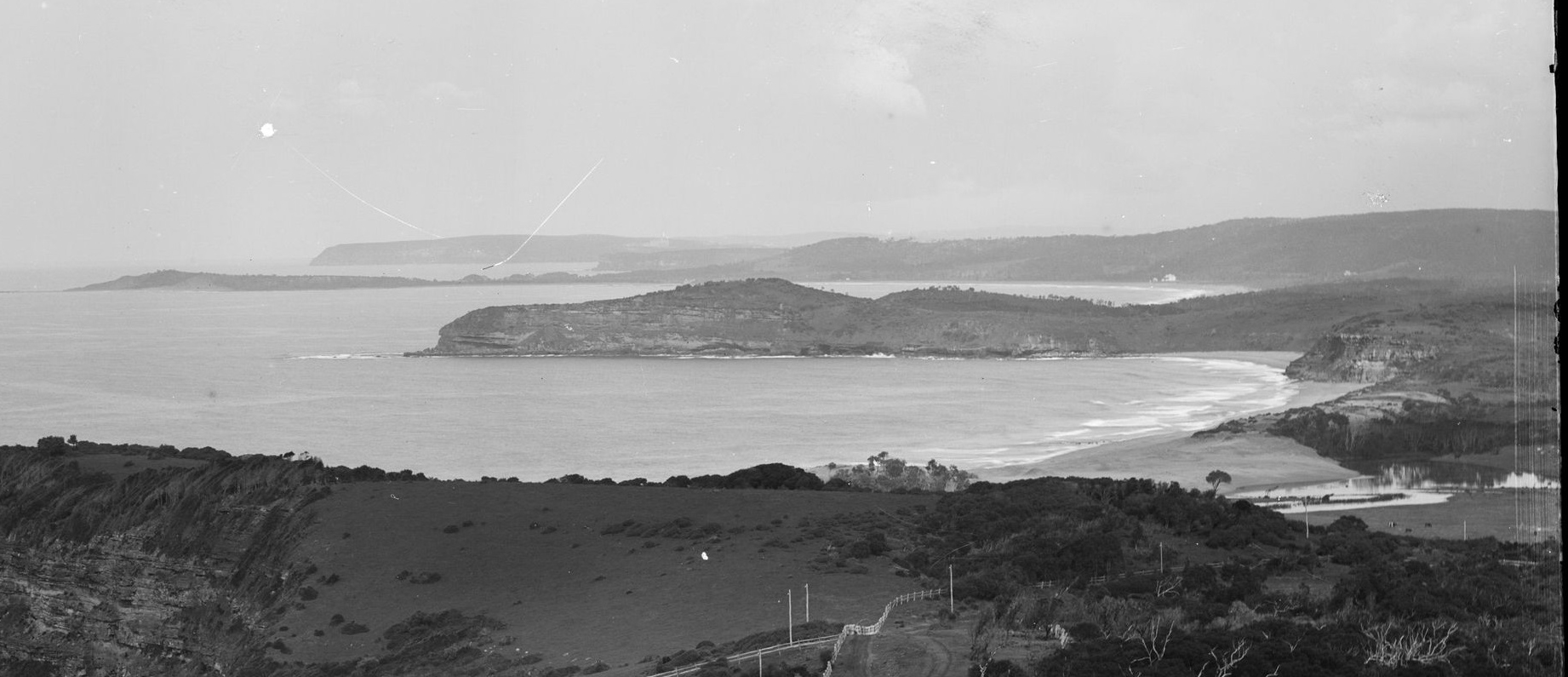
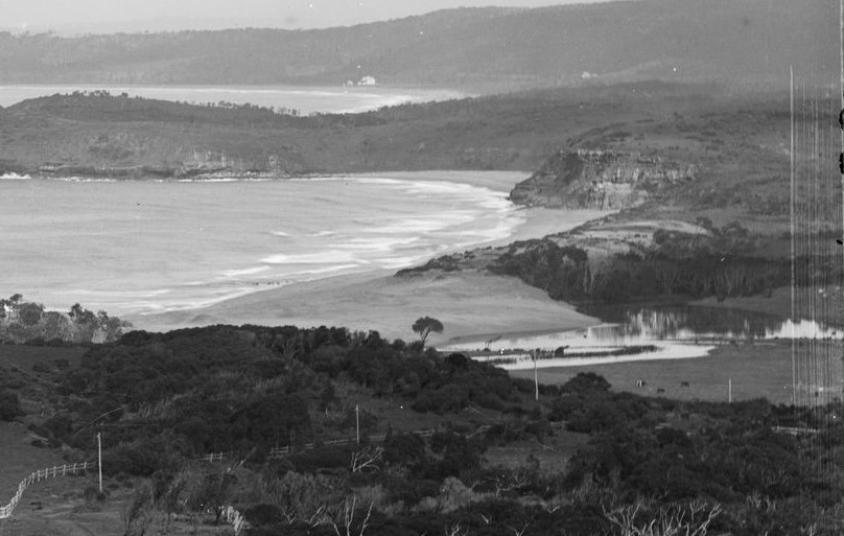
Northern Composure Band Competition 2023
Due to the pandemic, Council have had the 20th anniversary on hold but pleased to say that the competition is open and running again.
Northern Composure is the largest and longest-running youth band competition in the area and offers musicians local exposure as well as invaluable stage experience. Bands compete in heats, semi finals and the grand final for a total prize pool of over $15,000.
Over the past 20 years we have had many success stories and now is your chance to join bands such as:
- Ocean Alley
- Lime Cordiale
- Dear Seattle
- What So Not
- The Rions
- Winston Surfshirt
- Crocodylus
And even a Triple J announcer plus a wide range of industry professionals
About the Competition
In 2023, the comp looks a little different.
All bands are invited to enter our heats which will be exclusively run online and voted on by your peers and community by registering below and uploading a video of one song of your choice. (if you are doing a cover, please make sure to credit the original band) We are counting on you to spread the word and get your friends, family, teachers voting for you!
The top 8-12 bands will move on through to our live semi finals with a winner from each moving on to the grand final held during National Youth Week. Not only that but we have raised the age range from 19 to 21 for all those musicians who may have missed out over the past two years.
Key dates
- Voting open for heats: Mon 13 Feb – Sun 26 Feb
- Band Briefing: Mon 6 March, Dee Why PCYC
- Semi 1: Sat 18 March Mona Vale Memorial Hall
- Semi 2: Sat 25 March, YOYOs, Frenchs Forest
- Grand Final: Fri 28 April, Dee Why PCYC
For more information contact Youth Development at youth@northernbeaches.nsw.gov.au or call 8495 5104
Stay in the loop and follow Northern Composure Unplugged on KALOF Facebook.
School Leavers Support
- Download or explore the SLIK here to help guide Your Career.
- School Leavers Information Kit (PDF 5.2MB).
- School Leavers Information Kit (DOCX 0.9MB).
- The SLIK has also been translated into additional languages.
- Download our information booklets if you are rural, regional and remote, Aboriginal or Torres Strait Islander, or living with disability.
- Support for Regional, Rural and Remote School Leavers (PDF 2MB).
- Support for Regional, Rural and Remote School Leavers (DOCX 0.9MB).
- Support for Aboriginal and/or Torres Strait Islander School Leavers (PDF 2MB).
- Support for Aboriginal and/or Torres Strait Islander School Leavers (DOCX 1.1MB).
- Support for School Leavers with Disability (PDF 2MB).
- Support for School Leavers with Disability (DOCX 0.9MB).
- Download the Parents and Guardian’s Guide for School Leavers, which summarises the resources and information available to help you explore all the education, training, and work options available to your young person.
School Leavers Information Service
- navigate the School Leavers Information Kit (SLIK),
- access and use the Your Career website and tools; and
- find relevant support services if needed.
Word Of The Week: Viola
noun
1. an instrument of the violin family, larger than the violin and tuned a fifth lower.2. a wooden musical instrument with four strings, held against the shoulder and played by moving a bow across the strings. It is slightly larger than the violin. 3. a bowed stringed instrument chiefly of the 16th and 17th centuries made in treble, alto, tenor, and bass sizes and distinguished from members of the violin family especially in having a deep body, a flat back, sloping shoulders, usually six strings, a fretted fingerboard, and a low-arched bridge
Also - Viola
noun
1. any of various garden hybrids with solitary white, yellow, or purple often variegated flowers resembling but smaller than typical pansies - a violet.
Viola - the musical instrument:
Etymology - From: Noun - borrowed from Italian, "viola, viol," borrowed from Old Occitan viola, viula "viol". Middle English vial, borrowed from Anglo-French viel, viele, viole, corresponding to continental Old French viele (by suffix substitution vielle) and viole, from a Gallo-Romance base vi-, attested earliest in Old Occitan viola, viula "viol," of uncertain origin
First known use: 15th century
NOTE: It has been claimed that the base vi- is of onomatopoeic origin, originally in verbal derivatives (Old French vieller, Old Occitan violar "to play a stringed instrument"), from which the noun designating the instrument is derived. However, it is unlikely that the resemblance between the viola words and Germanic *fiþlō- (whence Old High German fidula, Old English *fiðele; fiddle), a noun probably designating a string instrument, is pure chance, and borrowing from Germanic into Gallo-Romance seems more plausible than the reverse direction (despite the unexplained voicing of initial f). Medieval Latin vitula, vidula (best attested in English documents) are not necessarily indicative of an earlier Gallo-Romance form of viola, as the Germanic etymon may have contaminated the Romance word. There is no likely relation between the Medieval Latin words and Latin Vītula "goddess of joy," vītulārī "to utter a cry of exultation," which should have developed quite differently in Romance.
OTHERS STATE: The word "violin" was first used in English in the 1570s. The word "violin" comes from "Italian violino, [a] diminutive of viola. The term "viola" comes from the expression for "tenor violin" in 1797, from Italian and Old Provençal viola, [which came from] Medieval Latin vitula as a term which means "stringed instrument," perhaps [coming] from Vitula, Roman goddess of joy..., or from related Latin verb vitulari, "to cry out in joy or exaltation." The related term "Viola da gamba" meaning "bass viol" (1724) is from Italian, literally "a viola for the leg" (i.e. to hold between the legs)." A violin is the "modern form of the smaller, medieval viola da braccio." ("arm viola").
 Viola da braccio (from Italian "arm viola", plural viole da braccio) is a term variously applied during the baroque period to instruments of the violin family, in distinction to the viola da gamba ("leg viola") and the viol family to which the latter belongs. At first "da braccio" seems to encompass the entire violin family. Monteverdi's Orfeo (printed 1609) designates an entire six-part string section "viole da brazzo", apparently including bass instruments held between the knees like the cello and bass violin. His Selva morale (1641) contains a piece calling for "due violini & 3 viole da brazzo ouero 3 Tronboni" (2 violins & 3 viole da braccio or trombones), reflecting a general shift in meaning towards the lower instruments. Eventually it came to be reserved for the alto member, the viola. A famous example is Bach's Sixth Brandenburg Concerto (1721), combining two viole da braccio with two viole da gamba. The German word for viola, Bratsche, is a relic of this last use.
Viola da braccio (from Italian "arm viola", plural viole da braccio) is a term variously applied during the baroque period to instruments of the violin family, in distinction to the viola da gamba ("leg viola") and the viol family to which the latter belongs. At first "da braccio" seems to encompass the entire violin family. Monteverdi's Orfeo (printed 1609) designates an entire six-part string section "viole da brazzo", apparently including bass instruments held between the knees like the cello and bass violin. His Selva morale (1641) contains a piece calling for "due violini & 3 viole da brazzo ouero 3 Tronboni" (2 violins & 3 viole da braccio or trombones), reflecting a general shift in meaning towards the lower instruments. Eventually it came to be reserved for the alto member, the viola. A famous example is Bach's Sixth Brandenburg Concerto (1721), combining two viole da braccio with two viole da gamba. The German word for viola, Bratsche, is a relic of this last use.
Image: Viola da braccio in detail from a fresco by Gaudenzio Ferrari in Santa Maria dei Miracoli, Saronno (c. 1534)
Old Occitan (Modern Occitan: occitan ancian, Catalan: occità antic), also called Old Provençal, was the earliest form of the Occitano-Romance languages, as attested in writings dating from the eighth through the fourteenth centuries. Old Occitan generally includes Early and Old Occitan. Middle Occitan is sometimes included in Old Occitan, sometimes in Modern Occitan. As the term occitanus appeared around the year 1300, Old Occitan is referred to as "Romance" (Occitan: romans) or "Provençal" (Occitan: proensals) in medieval texts.
The viola is a string instrument that is bowed, plucked, or played with varying techniques. Slightly larger than a violin, it has a lower and deeper sound. Since the 18th century, it has been the middle or alto voice of the violin family, between the violin (which is tuned a perfect fifth above) and the cello (which is tuned an octave below). The strings from low to high are typically tuned to C3, G3, D4, and A4.
The viola was first introduced in northern Italy between 1530 and 1550. It is generally assumed that the alto, tenor and bass versions emerged soon after the soprano instrument. During this early period the word “viola” referred to any bowed Western classical stringed instrument. The word viola originates from the Italian language. The Italians often used the term viola da braccio meaning literally: 'of the arm'. "Brazzo" was another Italian word for the viola, which the Germans adopted as Bratsche. The French had their own names: cinquiesme was a small viola, haute contre was a large viola, and taile was a tenor. Today, the French use the term alto, a reference to its range.
The forerunner of the instruments of the violin family, it had low ribs, a rounded back, F-shaped sound holes, a fretless fingerboard, a neck raised from the body with a scroll and four strings across a curved bridge, which meant that they could be bowed individually.
Around 1800, because music was now being performed more often in concert halls, and also because François Tourte (1747–1835) had strengthened the bow, a succession of changes to the construction of the instruments in the violin family, including the viola, were made. Strings were made heavier and their tension increased to improve projection. The neck was set at a slight backward angle to the body and was now longer, retaining the same circumference along its whole length making it easier for the left hand to slide up and down to different positions. The body and bridge were also reinforced during this period.
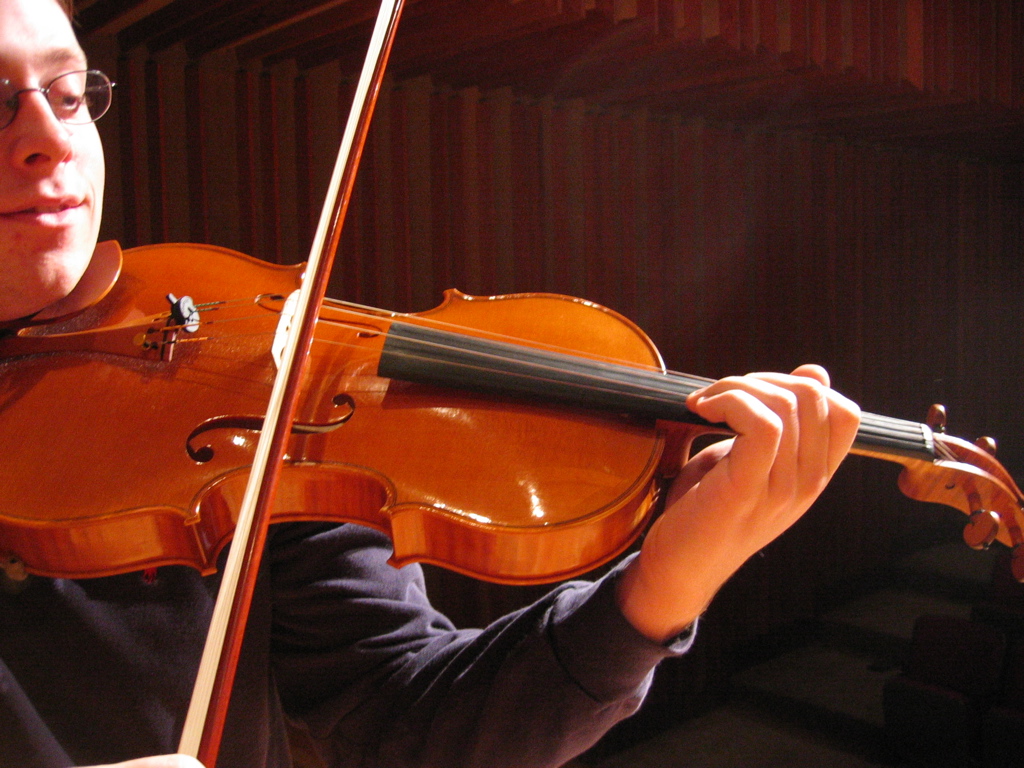
Playing a 43 cm (17 in) viola in 3rd position.
The viola was popular in the heyday of five-part harmony, up until the eighteenth century, taking three lines of the harmony and occasionally playing the melody line. Music for the viola differs from most other instruments in that it primarily uses the alto clef. When viola music has substantial sections in a higher register, it switches to the treble clef to make it easier to read.
The viola often plays the "inner voices" in string quartets and symphonic writing, and it is more likely than the first violin to play accompaniment parts. The viola occasionally plays a major, soloistic role in orchestral music. Examples include the symphonic poem Don Quixote, by Richard Strauss, and the symphony/concerto Harold en Italie, by Hector Berlioz. In the earlier part of the 20th century, more composers began to write for the viola, encouraged by the emergence of specialized soloists such as Lionel Tertis and William Primrose. English composers Arthur Bliss, York Bowen, Benjamin Dale, Frank Bridge, Benjamin Britten, Rebecca Clarke and Ralph Vaughan Williams all wrote substantial chamber and concert works. Many of these pieces were commissioned by, or written for, Lionel Tertis. William Walton, Bohuslav Martinů, Tōru Takemitsu, Tibor Serly, Alfred Schnittke, and Béla Bartók have written well-known viola concertos. The concerti by Béla Bartók, Paul Hindemith, Carl Stamitz, Georg Philipp Telemann, and William Walton are considered major works of the viola repertoire. Paul Hindemith, who was a violist, wrote a substantial amount of music for viola, including the concerto Der Schwanendreher.
The viola is sometimes used in contemporary popular music, mostly in the avant-garde. John Cale of The Velvet Underground used the viola, as do some modern groups such as alternative rock band 10,000 Maniacs, Imagine Dragons, folk duo John & Mary, British Sea Power and others. Jazz music has also seen its share of violists, from those used in string sections in the early 1900s to a handful of quartets and soloists emerging from the 1960s onward. It is quite unusual though, to use individual bowed string instruments in contemporary popular music.
John Davies Cale OBE (born 9 March 1942) is a Welsh musician, composer, singer, songwriter and record producer who was a founding member of the American rock band the Velvet Underground. Over his six-decade career, Cale has worked in various styles across rock, drone, classical, avant-garde and electronic music.
He studied music at Goldsmiths College, University of London, before relocating in 1963 to New York City's downtown music scene, where he performed as part of the Theatre of Eternal Music and formed the Velvet Underground. Since leaving the band in 1968, Cale has released sixteen solo studio albums, including the widely acclaimed Paris 1919 (1973) and Music for a New Society (1982). Cale has also acquired a reputation as an adventurous record producer, working on the debut albums of several innovative artists, including the Stooges and Patti Smith.
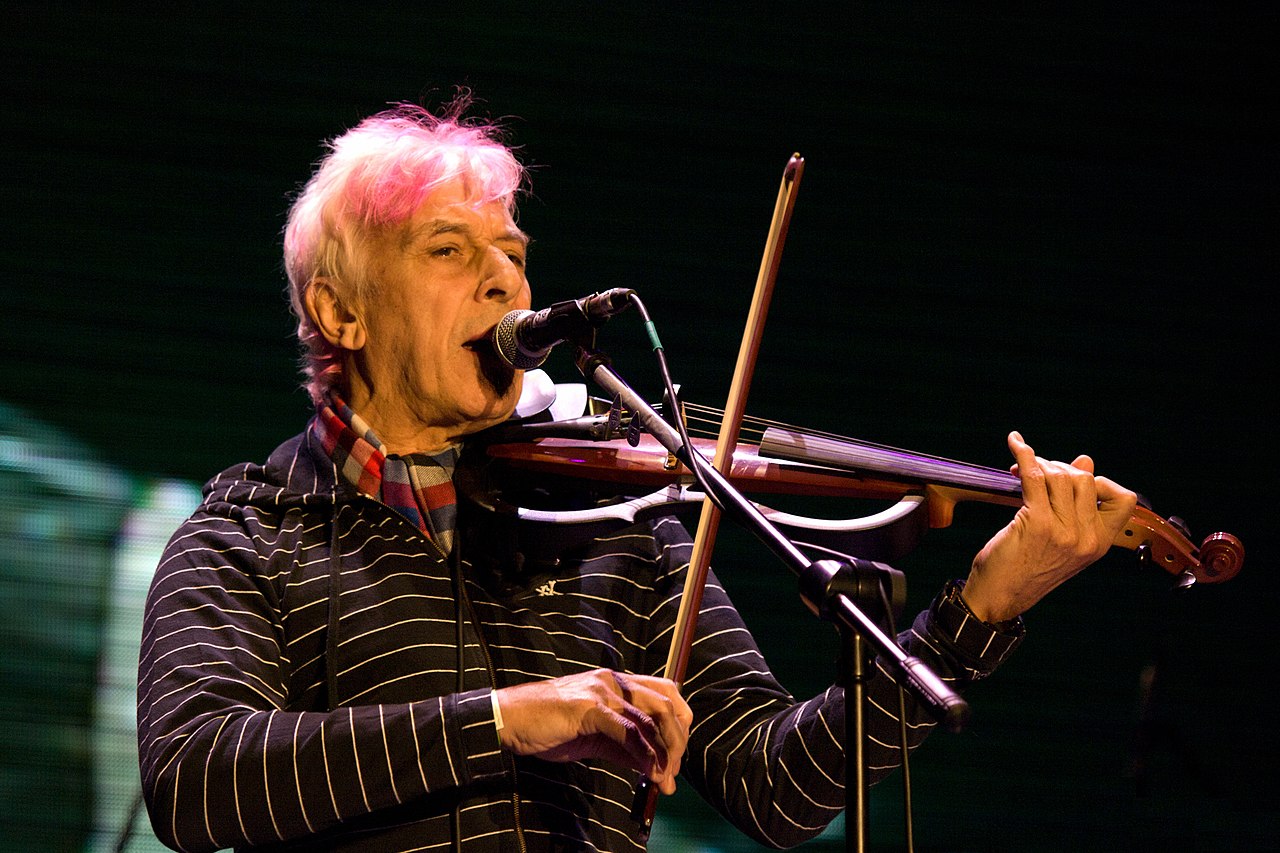
Cale performing at Urban SimpleLife Festival in 2010. Photo: Rex Huang
Viola - the flower:
noun
Middle English, borrowed from Latin, "violet" - Violet.
Viola is a genus of flowering plants in the violet family Violaceae. It is the largest genus in the family, containing between 525 and 600 species. Most species are found in the temperate Northern Hemisphere; however, some are also found in widely divergent areas such as Hawaii, Australasia, and the Andes.
Some Viola species are perennial plants, some are annual plants, and a few are small shrubs. Many species, varieties and cultivars are grown in gardens for their ornamental flowers. In horticulture the term pansy is normally used for those multi-coloured, large-flowered cultivars which are raised annually or biennially from seed and used extensively in bedding. The terms viola and violet are normally reserved for small-flowered annuals or perennials, including the wild species.
Etymology - From: 1300, from Old French violete (12c.), diminutive of viole "violet," from Latin viola "the violet, a violet colour," cognate with Greek ion (see iodine), probably from a pre-Indo-European substrate Mediterranean language. From Middle English violet, vyolet, vyolette, from Old French violette, from Latin viola (“violet”). Cognate with Lithuanian violetinė (“purple, violet”).
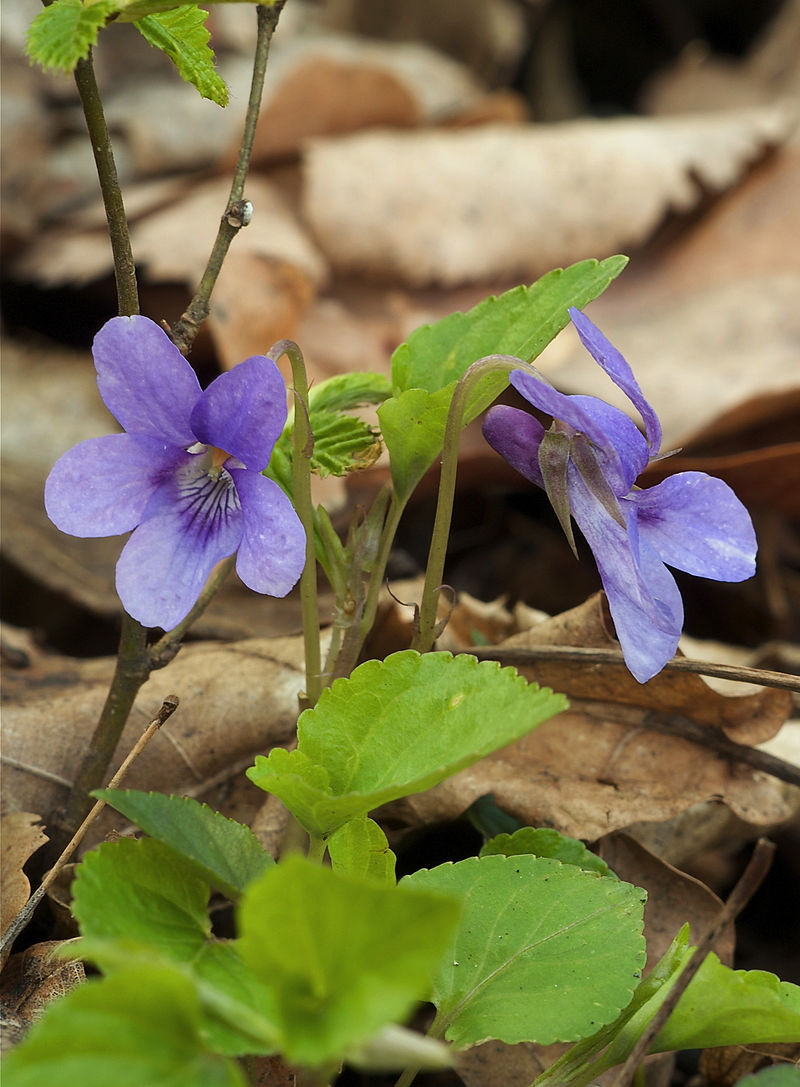
Viola reichenbachiana, Chemnitz, Germany. Photo: , Jörg Hempel
Music, silence, love and power: the engrossing story of a child prodigy in the court of Louis XIV
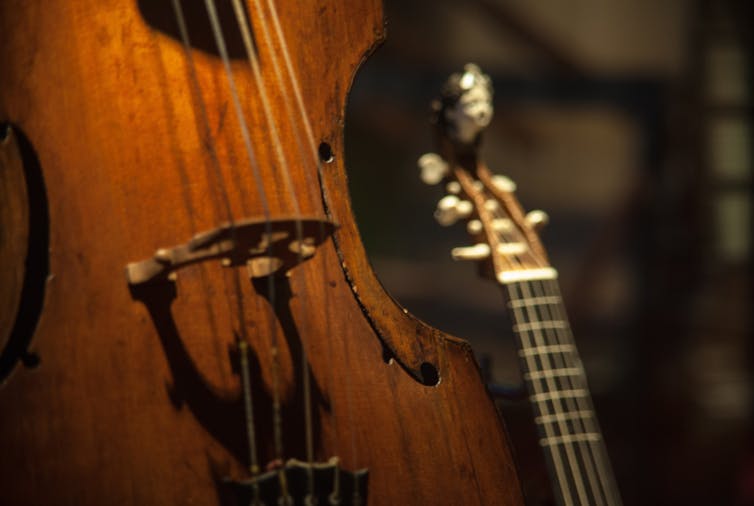
Brilliant. Inventive. Devilish.
This is how 15-year old Jean-Baptiste Forqueray (1699-1742) describes the music that his father Antoine (1672-1745) draws from the viol, aka viola da gamba. The same words could be applied to this novel, a brilliant read inventively devised by Adelaide’s Michael Meehan, but somewhat devilish to review.
An Ungrateful Instrument – Michael Meehan (Transit Lounge)
Because, although music often tells stories, this story tells music. By which I mean that it works contrapuntally, careering ahead but also looking back and catching itself up, complicating and enhancing itself via reversals and repetitions and new motifs, never short of a theme to be introduced and played on.
I invite you to look at, listen to and enjoy this extract from the first chapter of this book, written by Charlotte-Elisabeth, purportedly Jean-Baptiste’s younger sister:
… I can tell of how the boy creeps from the house in the first light of dawn, his viol swathed in thick canvas. Of how he steps through the drifts that lead down to the river, his footsteps first to break the newest fall of snow.
He steals down to a clearing by the bank, to a seat on a toppled sycamore. He draws the viol from the canvas and opens its music to the air. The first sounds moan and clash, as though in sorrow, but then reach out, testing the silver spaces of the frozen river, the keening of the breeze that troubles the highest branches, the muffled sound of the waters that move deep below the ice.
He begins to play. A new kind of music. Not a music he has ever learned. Not a music to be played indoors, to be played within his father’s hearing. He listens closely, blending his music with all he hears around him. Chasing the rhythm, not quite yet a rhythm. Seeking a motion to bind the drip, drip, drip of melting snow, to catch the fractured melodies that run through the chill boughs above.
He drums his fingers on the belly, tracing the hiding harmonies, the matching rhythms of water, wind and trees. He draws from the frozen river a music that was there before him, a music that was there long before his father, before the first growth of his instrument, the woods through which he plays.
The prose may be unapologetically poetic, but the narrative itself is vivid and lively, sometimes even quirky, though its origins are firmly based in the history of French music. Forqueray père and, later, Jean-Baptiste, began their careers as child prodigies during the 70-year reign of Louis XIV, and in time overlapped as official court musicians.
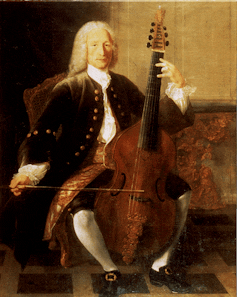
Their fictionalised story is written down by the above-mentioned Charlotte-Elisabeth, who does not speak but whose role is in every way central. When she was a child and learning to play the harpsichord, her father was determined to turn her into a prodigy as famous as her brother: one day, she too must play at court.
To this end he tries to thrash her into learning, as he’d successfully done with his son; but in contrast to her brother, Charlotte-Elisabeth rebels. Her creative life will be her own choice, not her father’s.
When she is seven, he inflicts on her a particularly savage beating, yanking a clump of her hair out, striking her with his bow until it breaks, and shutting her in her room for several days “to be starved into music”. Instead, Charlotte-Elisabeth makes a thrilling discovery: silence is her friend and consolation. When she is let out, she chooses never to speak again.
Cruelty
Forever mute (but NOT deaf-mute, as the book’s front flap nonsensically claims) she is nevertheless far from isolated. Behind the curtains of the window-seat, people confide to her the things they cannot say to anyone else, not even to themselves. Within her silence she harbours “the lost truth of all their lives”; and she continues to play the harpsichord for her own personal pleasure.

The father also continues on his path, cruelty still his weapon of instruction. Teaching Jean-Baptiste, he permits only his own compositions to be used; but as he never commits them to paper, they demand endless hours at the piano, enabling the father to overwork a pupil who must reach the level he has frenziedly set.
Unfortunately, the father fails to grasp that while this standard is high enough to impress the court and garner some fame, it is ultimately constrained by his own limitations.
Jean-Baptiste is five when he first plays for the king in the Hall of Mirrors at Versailles, desperately uncomfortable under a hot wig and heavy court dress. Despite much applause from the audience, the father showers him with imprecations. The reader again understands what the father does not: that the son cannot rise above a teacher who has no intention of being outstripped by his pupil.
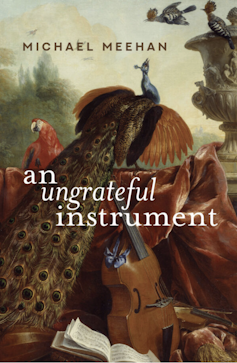
Alongside this painful histoire runs the story introduced in the quote. We now learn that when Jean-Baptiste played in the forest he was heard by an ancient luthier living in its depths; the old man’s deep and intimate knowledge of every tree – maple, sycamore, pear-wood, ebony, cherry-wood, spruce – ensures his unerring ability to select the wood best suited to a specified instrument. After Jean-Baptiste has come by a few more times, the old man offers to make him a new viol.
The ensuing story of Jean-Baptiste’s life and career as a viol-player is not without adventures and trials. He is thrown into prison, gifted by the Duc d’Orleans with a priceless if troublesome instrument known as the regent’s viol, and exiled from France; he walks to Venice and is invited to play in the basilica of the Frari. Plus much more.
Alongside his exploits run the eventful stories of the two special instruments, the “regent’s viol” and the “forest viol”; and also those of two girls, Jeanne and Marie-Rose, both musicians, who constitute Jean-Baptiste’s romantic and conjugal life.
In the end, everything in this engrossing and beautifully presented novel contributes to one ultimate message. Music and Love should never just respond; they must both create, using the human energy that is poured into them.![]()
Judith Armstrong, Honorary Fellow of the School of Languages and Linguistics, The University of Melbourne
This article is republished from The Conversation under a Creative Commons license. Read the original article.
He is one of the originators of the Tulsa sound, a loose genre drawing on blues, rockabilly, country, and jazz. In 2008, Cale and Clapton received a Grammy Award for their album The Road to Escondido.
Dangerous selfies aren’t just foolish. We need to treat them like the public health hazard they really are
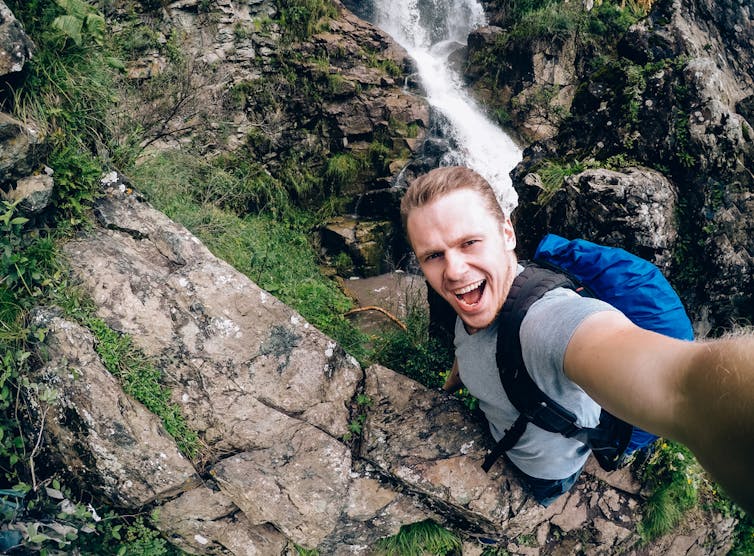
Selfies have been called everything from an artform to narcissistic and a sign of a dysfunctional society.
They can also kill.
When people go to extreme lengths to take an image to share on social media – perhaps in remote or picturesque locations – they can risk their lives.
So we need to move beyond describing selfies as a social phenomenon, fuelled by the rise of smartphones and social media.
We need to treat dangerous selfies as the public health hazard they really are.
More Deaths, Year After Year
Certain picturesque locations have been linked to selfie deaths. This includes Yosemite National Park in California. In Australia, we’ve seen people die at places including cliffs, natural pools and waterfalls.
These are not isolated incidents.
One study found 379 people worldwide were killed due to selfies between 2008 and 2021, with even more injured. Incidents are more likely in young adults, particularly males.
Many are travellers or tourists (particularly in Australia and the United States). In Australia and the US, selfie takers tend to be injured or killed while solo, and commonly in locations very difficult for emergency services to access. In countries such as India and Pakistan, selfie takers are more likely to die, tragically, as a group, especially near bodies of water, such as lakes.
Researchers have called for the introduction of “no selfie zones” around hotspots, such as tall buildings. Russian and Indian authorities have introduced these. Russia has launched a “safe selfie” guide.
But it’s not clear how effective these strategies have been. If anything, selfie incidents seem to be increasing globally.
Media Calls These Foolish, Selfish
The media often portrays people involved in selfie incidents as foolish or selfish.
This seems to confirm our research showing media reports often blame the victim. Reports almost never provide safety information.
But taking selfies is a normal part of everyday life for millions of people. We need to stop judging people who are taking risky selfies, and instead see risky selfies as a public health issue.
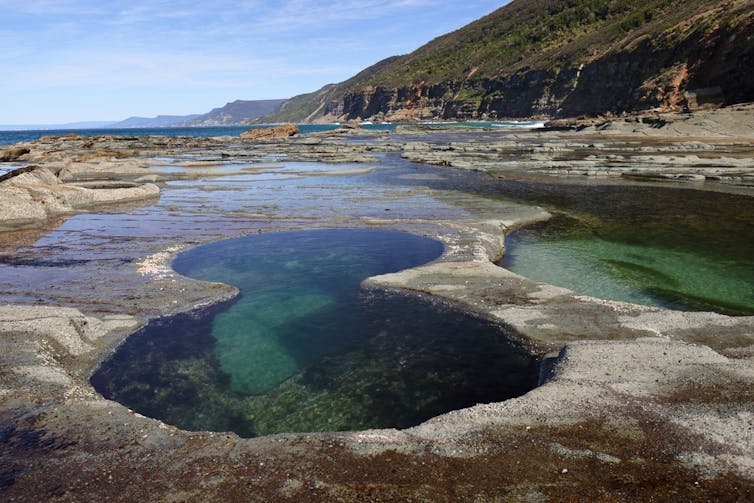
Why Is This A Public Health Issue?
We’ve had similar problems with other activities we now see as public health hazards. These include driving without a seatbelt, riding a bicycle without a helmet, smoking cigarettes or excessive alcohol consumption. These are all examples people once considered “normal”, which we now see as risky. Taking dangerous selfies needs to be added to that list.
By thinking of these selfies as a public health issue, we move away from victim blaming and instead need to effectively communicate risk to selfie-takers.
One example relates to the popular selfie hotspot, Figure Eight Pools in the Royal National Park, New South Wales, where people can be overwhelmed by big, “freak” waves. Authorities have produced a colour-coded risk rating that takes into account ocean and weather conditions. People can go online to see if the risk of going to the pools is “very low” to “extreme”.
If we think of these risky selfies as a public health issue we also move towards education and prevention.
Signs at selfie hotspots are one thing. But we know signs are often ignored, or simply not seen.
So we need to better communicate safety messages to selfie takers when and how they will actually take notice.
Our research with Instagram aims to do this by communicating directly to selfie takers through the Instagram app. The aim is to tailor safety messaging to Instagram users by geolocating them with known risky selfie spots – sending users a safety alert in real time.
With the right communication strategy, we know we can reduce the number of these entirely avoidable tragedies.
5 Tips To Stay Safe When Taking Selfies In Nature
1. Think about weather and water conditions
Weather and coastal conditions can change rapidly. Just because the weather and waves don’t appear dangerous when you start your selfie journey, they might be when you get there. Check before you go, avoid bad weather, and keep a close eye on tidal and wave conditions.
2. Don’t walk past safety signs and physical barriers
Warning signs are there to provide life-saving information. Pay attention to signs and heed their advice. Don’t jump or go around any physical barriers blocking access. They are likely there for a good reason.
3. Stay on the designated path
Staying on paths and trails is safest and also does fragile ecosystems a big favour.
4. Don’t get too close to the edge. Be aware of crumbling edges
Don’t trust cliff edges and be aware of unstable ground. Cliff edges are naturally eroding and your extra weight doesn’t help. People have died from cliff edges crumbling away while standing on them.
5. No amount of ‘likes’ is worth your life
Consider your motivations for taking selfies and using social media. Studies show spending time in nature is good for our health. But the world looks better when not viewed through a screen.![]()
Samuel Cornell, PhD Candidate, UNSW Beach Safety Research Group, School of Population Health, UNSW Sydney; Amy Peden, NHMRC Research Fellow, School of Population Health & co-founder UNSW Beach Safety Research Group, UNSW Sydney, and Rob Brander, Professor, UNSW Beach Safety Research Group, School of Biological, Earth & Environmental Sciences, UNSW Sydney
This article is republished from The Conversation under a Creative Commons license. Read the original article.
The World's First Horse Riders
March 2023
The earliest evidence of horse riders has likely been found by an international team of archaeologists and bioanthropologists.
The researchers discovered evidence of horse riding by studying the remains of human skeletons found in burial mounds called kurgans, which were between 4500-5000 years old. The earthen burial mounds belonged to the Yamnaya culture. The Yamnayans had migrated from the Pontic-Caspian steppes to find greener pastures in today´s countries of Romania and Bulgaria up to Hungary and Serbia.
Yamnayans were mobile cattle and sheep herders, now believed to be on horseback.
"Horseback-riding seems to have evolved not long after the presumed domestication of horses in the western Eurasian steppes during the fourth millennium BCE. It was already rather common in members of the Yamnaya culture between 3000 and 2500 BCE," says Volker Heyd, Professor of Archaeology at the University of Helsinki and a member of the international team, which made the discovery.
These regions west of the Black Sea constitute a contact zone where mobile groups of herdsmen from the Yamnaya culture first encountered the long-established farmer communities of Late Neolithic and Chalcolithic traditions. For decades, the Early Bronze Age expansion of steppe people into southeastern Europe was explained as a violent invasion.
With the advent of ancient DNA research, the differences between these migrants from the east and members of local societies became even more pronounced.
"Our research is now beginning to provide a more nuanced picture of their interactions. For example, findings of physical violence as were expected are practically non-existent in the skeletal record so far. We also start understanding the complex exchange processes in material culture and burial customs between newcomers and locals in the 200 years after their first contact," explains Bianca Preda-Bălănică, another team member from the University of Helsinki.
Horse riding is a pivotal moment in human history
The use of animals for transport, in particular the horse, marked a turning point in human history. The considerable gain in mobility and distance had profound effects on land use, trade, and warfare. Current research has mostly focused on the horses themselves. However, horse-riding is an interaction of two components -- the mount and its rider -- and human remains are available in larger numbers and more complete condition than early horse remains. Since horseback riding is possible without specialized equipment, the absence of archaeological finds with regard to earliest horsemanship does not come unexpected.
Traces of horsemanship can be found in the skeletons
"We studied over 217 skeletons from 39 sites of which about 150 found in the burial mounds belong to the Yamnayans. Diagnosing activity patterns in human skeletons is not unambiguously. There are no singular traits that indicate a certain occupation or behaviour. Only in their combination, as a syndrome, symptoms provide reliable insights to understand habitual activities of the past.," explains Martin Trautmann, Bioanthropologist in Helsinki and the lead author of the study.
The international team decided to use a set of six diagnostic criteria established as indicators of riding activity (the so-called "horsemanship syndrome"):
- Muscle attachment sites on pelvis and thigh bone (femur);
- Changes in the normally round shape of the hip sockets;
- Imprint marks caused by pressure of the acetabular rim on the neck of the femur;
- The diameter and form of the femur shaft;
- Vertebral degeneration caused by repeated vertical impact;
- Traumata that typically can be caused by falls, kicks or bites from horses.
To increase the diagnostic reliability, the team also used a stricter filtering method and developed a scoring system that takes into account the diagnostic value, distinctiveness and reliability of each symptom. Altogether, out of the 156 adult individuals of the total sample at least 24 (15.4%) can be classified as 'possible riders', while five Yamnaya and two later as well as two possibly earlier individuals qualify as 'highly probable riders'. "The rather high prevalence of these traits in the skeleton record, especially with respect to the overall limited completeness, show that these people were horse riding regularly," Trautmann states.
If the primary use of horseback riding was as a convenience in a mobile pastoral lifestyle, in allowing a more effective herding of cattle, as means of swift and far-ranging raids or just as symbol of status needs further research.
Could it all have happened even earlier?
"We have one intriguing burial in the series" remarks David Anthony, emeritus Professor of Hartwick College USA and also senior co-author in the study.
"A grave dated about 4300 BCE at Csongrad-Kettöshalom in Hungary, long suspected from its pose and artifacts to have been an immigrant from the steppes, surprisingly showed four of the six riding pathologies, possibly indicating riding a millennium earlier than Yamnaya. An isolated case cannot support a firm conclusion, but in Neolithic cemeteries of this era in the steppes, horse remains were occasionally placed in human graves with those of cattle and sheep, and stone maces were carved into the shape of horse heads. Clearly, we need to apply this method to even older collections."
Who were the Yamnayans?
The Yamnayans were a population and culture that evolved in the Pontic-Caspian steppes at the end of the fourth millennium BCE.
By adopting the key innovation wheel and wagon, they were able to greatly enhance their mobility and exploit a huge energy resource otherwise out of reach, the sea of steppe grass away from the rivers, enabling them to keep large herds of cattle and sheep. Thus committing to a new way-of-life, these pastoralists if not first true nomads in the world expanded dramatically within the next two centuries to cover more than 5000 kilometers between Hungary in west and, in form of the so-called Afanasievo culture, Mongolia and western China in the east. Having buried their dead in grave pits under big mounds, called kurgans, the Yamnayans are said to be the first having spread proto-Indo-European languages.
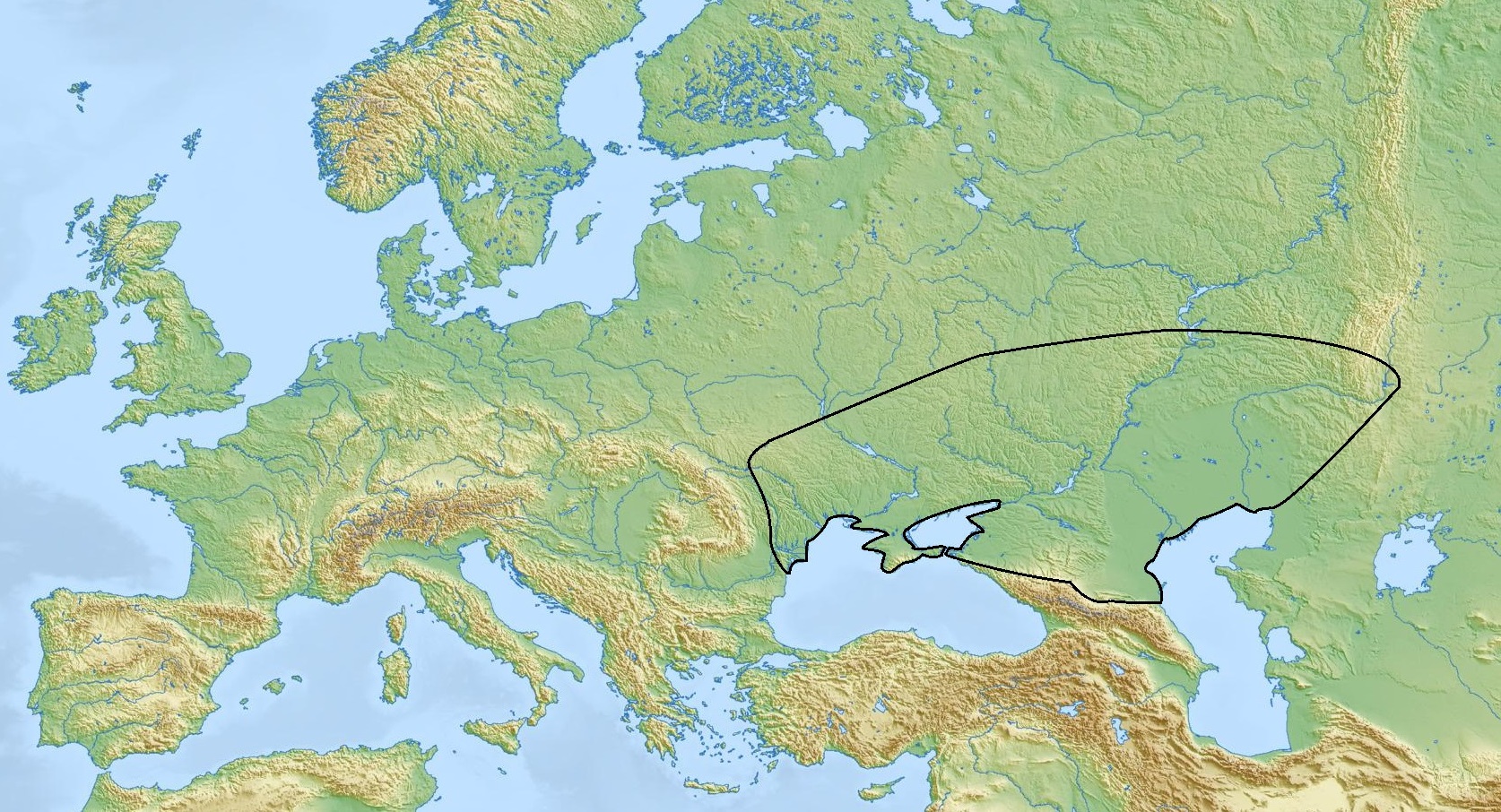
Map of the Yamnaya culture, based on map printed at page 651 in Encyclopaedia of Indo-European Culture, which was edited by J. P. Mallory and Douglas Q. Adams, and published by Taylor & Francis in 1997.
Martin Trautmann, Alin Frînculeasa, Bianca Preda-Bălănică, Marta Petruneac, Marin Focşǎneanu, Stefan Alexandrov, Nadezhda Atanassova, Piotr Włodarczak, Michał Podsiadło, János Dani, Zsolt Bereczki, Tamás Hajdu, Radu Băjenaru, Adrian Ioniță, Andrei Măgureanu, Despina Măgureanu, Anca-Diana Popescu, Dorin Sârbu, Gabriel Vasile, David Anthony, Volker Heyd. First bioanthropological evidence for Yamnaya horsemanship. Science Advances, 2023; 9 (9) DOI: 10.1126/sciadv.ade2451
From Squid Game and Physical: 100 to K-pop and BTS, translation is central to tectonic shifts in global cultural consumption

The Korean reality survival show Physical: 100 has become a global hit, topping Netflix’s non-English lineup in just a week following its premier on January 24 2023.
The name of the show says it all: 100 contestants with superb physiques participate in a variety of challenges to win 300 million Korean won, equivalent to A$335,000.
There are several reasons behind the success of the show. First, the idea of finding the fittest body through a series of gruelling real-life challenges is unprecedented.
Second, the show is reminiscent of another Korean entertainment success, Squid Game. From the studio settings to the ways the challenges operate, Physical: 100 has obviously been inspired by its fictional blockbuster predecessor. Third, the sheer scale of the challenges – such as moving a 1.5-tonne ship – is just mindboggling.
There is one element that is rarely talked about, despite its pivotal contribution to the success of the show: translation.
Without translation, the show would never have been able to reach a global audience. The same goes for all the Korean dramas, movies and shows that have gained huge popularity around the world. Translation is central to tectonic shifts in global cultural consumption, which has been traditionally led by the West.

The Rise Of Korean Culture As A Gamechanger
For decades, people in the East have looked to the West (mostly the United States and Europe) as a source of cultural consumption. Korea was no exception.
Local movies were once looked down upon by Korean people, who considered Western counterparts more advanced. It was not until the late 1990s that the Korean movie industry began to thrive, thanks largely to systematic government support.

Another contributor to the global popularity of Korean culture is the ascendance of Korean pop culture, better known as K-pop. This new genre of visually packed musical performance has benefited enormously from YouTube and has produced global household names such as BTS and Black Pink. As of 2021, the number of K-culture fans was estimated at more than 150 million.
Who Translates Korean Cultural Products?
The rise of Korean culture has witnessed a rapid growth of a dedicated global fandom and, interestingly, fan-led translation. Initiated by BTS fans, an enormous community also known as “Army”, fandom translation basically covers everything relating to their favourite artists. From YouTube videos and lyrics to news articles, fans from around the world who are proficient in the Korean language voluntarily translate it all into other languages and share them through social media.
Paid translation work is in demand too. Iyuno SDI, for example, provides translation services in more than 100 languages to global media companies such as Netflix, Disney and Amazon. It is, however, not always humans who translate: AI-enabled machine translation (XL8) does much of the work. Draft translation done by machines is then reviewed and edited by more than 30,000 freelance translators across the world.
Despite the growth of the translation industry, working conditions for translators are often problematic, as many translators are short of time to complete work and underpaid. Through this mass production process, cultural consideration may sometimes get lost, as happened in Physical: 100.
Translation Challenges In Physical: 100
If you’ve watched the show, you will remember Choo Sung-Hoon, a celebrity mixed martial arts (MMA) fighter. After Choo won his first one-on-one match against another MMA fighter, Shin Dong-Kook, Shin bowed deeply before Choo, with his head touching the ground. Is this standard practice among MMA fighters? No, the answer lies in the Korean term, sunbae-nim, which Shin used consistently to refer to Choo, but was not translated in the show.
Sunbae-nim refers to a person who is older or more experienced in a workplace, school, military unit or social context. Virtually all Koreans would know several people whom they consider as sunbae-nim.
Shin clearly idolises Choo, who is older and has been a big gun in the MMA field for almost two decades. It is therefore only natural for Shin to call Choo sunbae-nim, a term intended to deliver the amount of respect that Shin held for Choo. As there is no exact English equivalent, however, the term was often replaced in the subtitles by Choo’s given name, “Sung-Hoon”.
This might have given the wrong impression when Shin suggested to Choo that they have an MMA match, rather than playing the ball game prescribed in the show. Here is what Shin said (in the English subtitles) when he made the suggestion:
It would be rude of me to challenge a respected senior just to play with a ball.
“Respected senior” here refers to dae-sunbaenim (literally “great sunbaenim”) yet it sounds odd and unnatural. My suggestion? “It wouldn’t do justice to your distinguished MMA career if we just played with a ball.”
Translation As A Mutual Process
Titles and forms of address in Korean are always challenging to translate.
As someone who specialises in English-Korean translation, I believe it would be best to retain these original expressions. In this digital era, information is at one’s fingertips and is easy to look up. Just as “señor” or “monsieur” need no translation, Korean titles should be respected on their own terms.
When we recognise translation as a mutual process of engaging with an audience, a cultural shift from the West to the East may be achieved in a genuine sense.![]()
Jinhyun Cho, Senior Lecturer in Translation and Interpreting at Macquarie University, Macquarie University
This article is republished from The Conversation under a Creative Commons license. Read the original article.
Humans are still hunting for aliens. Here’s how astronomers are looking for life beyond Earth
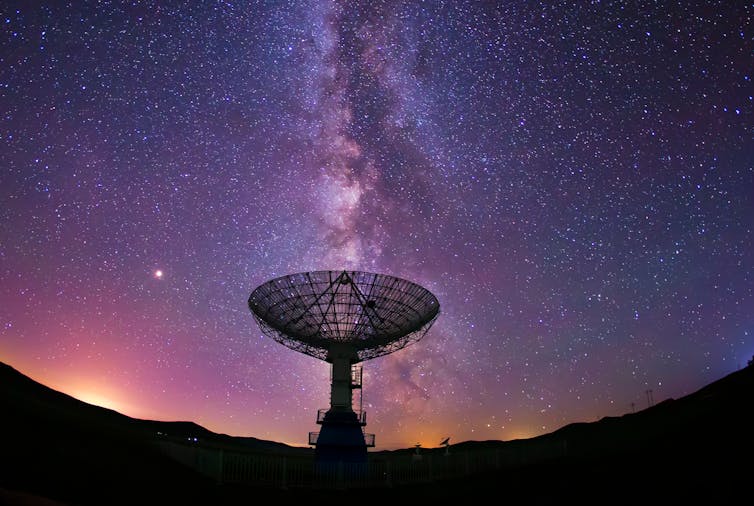
We have long been fascinated with the idea of alien life. The earliest written record presenting the idea of “aliens” is seen in the satiric work of Assyrian writer Lucian of Samosata dated to 200 AD.
In one novel, Lucian writes of a journey to the Moon and the bizarre life he imagines living there – everything from three-headed vultures to fleas the size of elephants.
Now, 2,000 years later, we still write stories of epic adventures beyond Earth to meet otherworldly beings (Hitchhiker’s Guide, anyone?). Stories like these entertain and inspire, and we are forever trying to find out if science fiction will become science fact.
Not All Alien Life Is The Same
When looking for life beyond Earth, we are faced with two possibilities. We might find basic microbial life hiding somewhere in our Solar System; or we will identify signals from intelligent life somewhere far away.
Unlike in Star Wars, we’re not talking far, far away in another galaxy, but rather around other nearby stars. It is this second possibility which really excites me, and should excite you too. A detection of intelligent life would fundamentally change how we see ourselves in the Universe.
In the last 80 years, programs dedicated to the search for extraterrestrial intelligence (SETI) have worked tirelessly searching for cosmic “hellos” in the form of radio signals.
The reason we think any intelligent life would communicate via radio waves is due to the waves’ ability to travel vast distances through space, rarely interacting with the dust and gas in between stars. If anything out there is trying to communicate, it’s a pretty fair bet they would do it through radio waves.

Listening To The Stars
One of the most exciting searches to date is Breakthrough Listen, the largest scientific research program dedicated to looking for evidence of intelligent life beyond Earth.
This is one of many projects funded by US-based Israeli entrepreneurs Julia and Yuri Milner, with some serious dollars attached. Over a ten-year period a total amount of US$100 million will be invested in this effort, and they have a mighty big task at hand.
Breakthrough Listen is currently targeting the closest one million stars in the hope of identifying any unnatural, alien-made radio signals. Using telescopes around the globe, from the 64-metre Murriyang Dish (Parkes) here in Australia, to the 64-antenna MeerKAT array in South Africa, the search is one of epic proportions. But it isn’t the only one.
Hiding away in the Cascade Mountains north of San Francisco sits the Allen Telescope Array, the first radio telescope built from the ground up specifically for SETI use.
This unique facility is another exciting project, able to search for signals every day of the year. This project is currently upgrading the hardware and software on the original dish, including the ability to target several stars at once. This is a part of the non-profit research organisation, the SETI Institute.
Space Lasers!
The SETI Institute is also looking for signals that would be best explained as “space lasers”.
Some astronomers hypothesise that intelligent beings might use massive lasers to communicate or even to propel spacecraft. This is because even here on Earth we’re investigating laser communication and laser-propelled light sails.
To search for these mysterious flashes in the night sky, we need speciality instruments in locations around the globe, which are currently being developed and deployed. This is a research area I’m excited to watch progress and eagerly await results.
As of writing this article, sadly no alien laser signals have been found yet.
Out There, Somewhere
It’s always interesting to ponder who or what might be living out in the Universe, but there is one problem we must overcome to meet or communicate with aliens. It’s the speed of light.
Everything we rely on to communicate via space requires light, and it can only travel so fast. This is where my optimism for finding intelligent life begins to fade. The Universe is big – really big.
To put it in perspective, humans started using radio waves to communicate across large distances in 1901. That first transatlantic signal has only travelled 122 light years, reaching just 0.0000015% of the stars in our Milky Way.
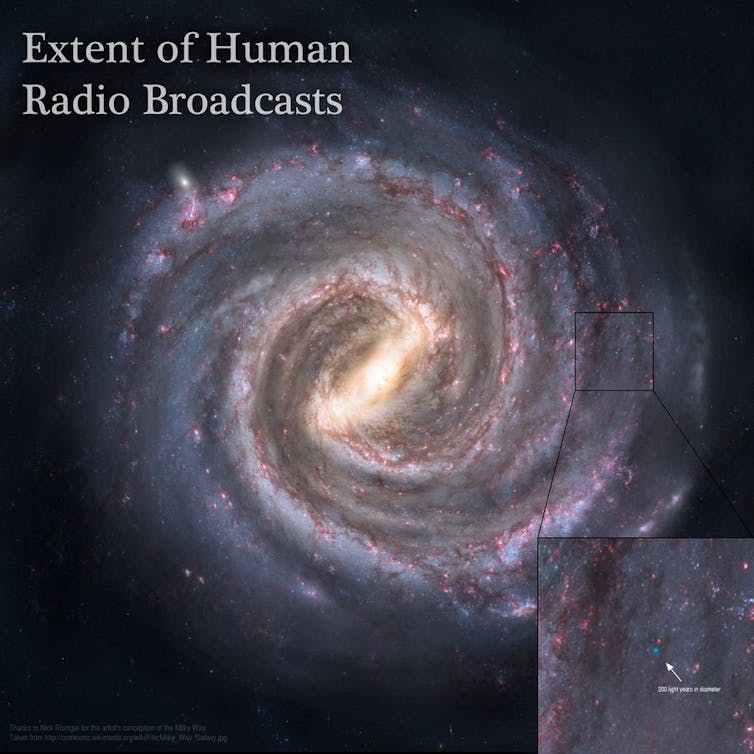
Did your optimism just fade too? That is okay, because here is the wonderful thing… we don’t have to find life to know it is out there, somewhere.
When we consider the trillions of galaxies, septillion of stars, and likely many more planets just in the observable Universe, it feels near impossible that we are alone.
We can’t fully constrain the parameters we need to estimate how many other lifeforms might be out there, as famously proposed by Frank Drake, but using our best estimates and simulations the current best answer to this is tens of thousands of possible civilisations out there.
The Universe might even be infinite, but that is too much for my brain to comprehend on a weekday.
Don’t Forget The Tiny Aliens
So, despite keenly listening for signals, we might not find intelligent life in our lifetimes. But there is hope for aliens yet.
The ones hiding in plain sight, on the planetary bodies of our Solar System. In the coming decades we’ll explore the moons of Jupiter and Saturn like never before, with missions hunting to find traces of basic life.
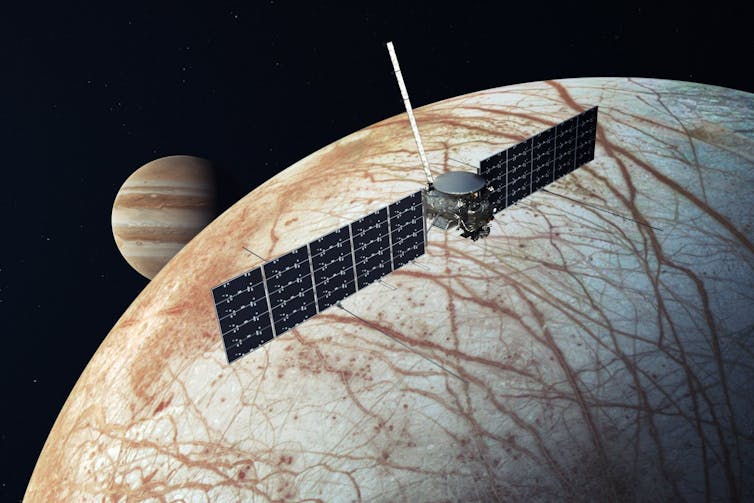
Mars will continue to be explored – eventually by humans – which could allow us to uncover and retrieve samples from new and unexplored regions.
Even if our future aliens are only tiny microbes, it would still be nice to know we have company in this Universe.
Correction: this article has been amended to clarify that Julia and Yuri Milner are no longer Russian citizens.![]()
Sara Webb, Postdoctoral Research Fellow, Centre for Astrophysics and Supercomputing, Swinburne University of Technology
This article is republished from The Conversation under a Creative Commons license. Read the original article.
AI could take your job, but it can also help you score a new one with these simple tips

It was once thought physical labour jobs would be the most at risk from the rise of artificial intelligence. But recent advances suggest we can expect disruption across a vast range of sectors, including knowledge-based industries.
We certainly need to have conversations about how AI will change the future of work. But perhaps we should also look beyond fear and ask how it might bring opportunity.
It’s expected that within five years AI will have replaced some 85 million jobs with 97 million new ones.
Many people will need to secure new opportunities to survive the shift towards an AI-based economy. If you’re considering competing in the AI-powered jobs market, now is the time to get ahead of the curve.
Here are five ways AI can help you do so.
1. Strengthen Your Professional Network
Experts say the majority of vacant positions aren’t formally advertised, and instead reside in what’s called the “hidden job market”. This means your networks are incredibly valuable.
This week LinkedIn released an AI-powered conversation starter tool called Collaborative Articles, which is expected to help users demonstrate their expertise and connect with others in their field.
There are also AI tools that can help you amplify the power of your networks through integration with LinkedIn. For instance, the paid tool Clay uses data sourced from your contacts’ social media accounts to identify shared interests, and makes suggestions for ways to re-engage with contacts.
It can also use location data to suggest opportunities for “chance encounters” which, although potentially a bit creepy, could be worthwhile.
Other paid AI tools that integrate with your LinkedIn profile include Taplio and Engage AI.
2. Write A Winning Job Application
AI tools can help you write CVs and cover letters that highlight your skills while also being tailored to the role you’re applying for.
Tools for writing resumes and cover letters, such as the paid application Rezi, typically integrate with LinkedIn. They let you import your work and education history, and generate customised job applications based on an advertised position’s description and the name of the hiring company.
Other similar tools include Jasper and Resume Worded.
To ensure spelling and grammar errors don’t hold your career back, you can run your CV and cover letter through tools such as QuillBot or Writer – while ChatGPT can help you improve word choices and phrasing.
3. Polish Your Interview Skills
Preparing for an interview can be stressful if you’re not sure which questions might be asked.
Although it’s not advisable to get ChatGPT to write your entire job application for you, there’s no reason you can’t use the conversational AI chatbot to help you prepare for a job interview.
For instance, you could try the following prompt:
Can you provide me with a list of potential interview questions for the position of {insert job title} at {insert company name}?
ChatGPT will then generate a list of potential interview questions based on the job title and company name you provided.
You could also try:
What should I talk about when giving an interview for a job in/at {insert industry or company name}?
You can even refine the outputs by including more information, such as the key skills and capabilities listed in the job selection criteria. Use these outputs to practise your responses and build your confidence going into the interview.
4. Tactfully Resign
If you’re ready to turn the page on your current job, you can ask ChatGPT to help you write a resignation letter that will keep your professional relationships intact long after you’ve left.
Here’s a prompt you could use:
Can you please suggest some polite and professional language for a resignation letter that expresses gratitude for the job, explains the reason for leaving, including {insert 1 or more reasons}, and provides an offer to assist my current employer with the transition?
Of course, you should amend the output to properly reflect your intentions – but ChatGPT provides a great starting point.
5. Ask For A Promotion
ChatGPT can also provide an encouraging nudge towards what is arguably one of the most daunting tasks when trying to climb the career ladder: asking for a promotion or raise. For this, you might try the following:
I’m planning to ask for a {promotion/raise} from my boss, but I’m not sure how to approach the conversation. Can you give me some tips on how to prepare for the meeting and what to say to make a compelling case for why I deserve a {promotion/raise}?
Looking To The Future
AI has already led to increased automation in many industries, including manufacturing, logistics and customer service. This makes sense: machines can perform routine and repetitive tasks more efficiently and cost-effectively.
However, not all jobs are easily replaceable by AI. Job seekers of the future will need to identify and showcase their unique humanness: those traits that are harder for AI to replicate, such as empathy, transparency, creativity, authenticity and the ability to cultivate trust through positivity and consistency.
For now, the advantages of leveraging AI are comparable to a road race where only a few competitors are driving cars while everyone else is pedalling a bicycle.
But this window of opportunity will narrow as AI tools become mass market products. Just as everyone traded in their Nokia 8210s for smartphones, soon the AI playing field will level and the first-mover advantage will be lost.
Even if AI itself doesn’t replace you in your workplace, another person who knows how to use it could soon be your main competitor.![]()
Bronwyn Eager, Senior Lecturer Freelancing, Small Business, and Entrepreneurship, University of Tasmania; Louise Grimmer, Senior Lecturer in Marketing, University of Tasmania, and Toby Newstead, Senior Lecturer in Management, University of Tasmania
This article is republished from The Conversation under a Creative Commons license. Read the original article.
Quantum mechanics: how the future might influence the past

In 2022, the physics Nobel prize was awarded for experimental work showing that the quantum world must break some of our fundamental intuitions about how the universe works.
Many look at those experiments and conclude that they challenge “locality” — the intuition that distant objects need a physical mediator to interact. And indeed, a mysterious connection between distant particles would be one way to explain these experimental results.
Others instead think the experiments challenge “realism” — the intuition that there’s an objective state of affairs underlying our experience. After all, the experiments are only difficult to explain if our measurements are thought to correspond to something real. Either way, many physicists agree about what’s been called “the death by experiment” of local realism.
But what if both of these intuitions can be saved, at the expense of a third? A growing group of experts think that we should abandon instead the assumption that present actions can’t affect past events. Called “retrocausality”, this option claims to rescue both locality and realism.

This is article is accompanied by a podcast series called Great Mysteries of Physics which uncovers the greatest mysteries facing physicists today – and discusses the radical proposals for solving them.
Causation
What is causation anyway? Let’s start with the line everyone knows: correlation is not causation. Some correlations are causation, but not all. What’s the difference?
Consider two examples. (1) There’s a correlation between a barometer needle and the weather – that’s why we learn about the weather by looking at the barometer. But no one thinks that the barometer needle is causing the weather. (2) Drinking strong coffee is correlated with a raised heart rate. Here it seems right to say that the first is causing the second.
The difference is that if we “wiggle” the barometer needle, we won’t change the weather. The weather and the barometer needle are both controlled by a third thing, the atmospheric pressure – that’s why they are correlated. When we control the needle ourselves, we break the link to the air pressure, and the correlation goes away.
But if we intervene to change someone’s coffee consumption, we’ll usually change their heart rate, too. Causal correlations are those that still hold when we wiggle one of the variables.
These days, the science of looking for these robust correlations is called “causal discovery”. It’s a big name for a simple idea: finding out what else changes when we wiggle things around us.
In ordinary life, we usually take for granted that the effects of a wiggle are going to show up later than the wiggle itself. This is such a natural assumption that we don’t notice that we’re making it.
But nothing in the scientific method requires this to happen, and it is easily abandoned in fantasy fiction. Similarly in some religions, we pray that our loved ones are among the survivors of yesterday’s shipwreck, say. We’re imagining that something we do now can affect something in the past. That’s retrocausality.
Quantum Retrocausality

The quantum threat to locality (that distant objects need a physical mediator to interact) stems from an argument by the Northern Ireland physicist John Bell in the 1960s. Bell considered experiments in which two hypothetical physicists, Alice and Bob, each receive particles from a common source. Each chooses one of several measurement settings, and then records a measurement outcome. Repeated many times, the experiment generates a list of results.
Bell realised that quantum mechanics predicts that there will be strange correlations (now confirmed) in this data. They seemed to imply that Alice’s choice of setting has a subtle “nonlocal” influence on Bob’s outcome, and vice versa – even though Alice and Bob might be light years apart. Bell’s argument is said to pose a threat to Albert Einstein’s theory of special relativity, which is an essential part of modern physics.
But that’s because Bell assumed that quantum particles don’t know what measurements they are going to encounter in the future. Retrocausal models propose that Alice’s and Bob’s measurement choices affect the particles back at the source. This can explain the strange correlations, without breaking special relativity.
In recent work, we’ve proposed a simple mechanism for the strange correlation – it involves a familiar statistical phenomenon called Berkson’s bias (see our popular summary here).
There’s now a thriving group of scholars who work on quantum retrocausality. But it’s still invisible to some experts in the wider field. It gets confused for a different view called “superdeterminism”.
Superdeterminism
Superdeterminism agrees with retrocausality that measurement choices and the underlying properties of the particles are somehow correlated.
But superdeterminism treats it like the correlation between the weather and the barometer needle. It assumes there’s some mysterious third thing – a “superdeterminer” – that controls and correlates both our choices and the particles, the way atmospheric pressure controls both the weather and the barometer.
So superdeterminism denies that measurement choices are things we are free to wiggle at will, they are predetermined. Free wiggles would break the correlation, just as in the barometer case. Critics object that superdeterminism thus undercuts core assumptions necessary to undertake scientific experiments. They also say that it means denying free will, because something is controlling both the measurement choices and particles.
These objections don’t apply to retrocausality. Retrocausalists do scientific causal discovery in the usual free, wiggly way. We say it is folk who dismiss retrocausality who are forgetting the scientific method, if they refuse to follow the evidence where it leads.
Evidence
What is the evidence for retrocausality? Critics ask for experimental evidence, but that’s the easy bit: the relevant experiments just won a Nobel Prize. The tricky part is showing that retrocausality gives the best explanation of these results.
We’ve mentioned the potential to remove the threat to Einstein’s special relativity. That’s a pretty big hint, in our view, and it’s surprising it has taken so long to explore it. The confusion with superdeterminism seems mainly to blame.
In addition, we and others have argued that retrocausality makes better sense of the fact that the microworld of particles doesn’t care about the difference between past and future.
We don’t mean that it is all plain sailing. The biggest worry about retrocausation is the possibility of sending signals to the past, opening the door to the paradoxes of time travel. But to make a paradox, the effect in the past has to be measured. If our young grandmother can’t read our advice to avoid marrying grandpa, meaning we wouldn’t come to exist, there’s no paradox. And in the quantum case, it’s well known that we can never measure everything at once.
Still, there’s work to do in devising concrete retrocausal models that enforce this restriction that you can’t measure everything at once. So we’ll close with a cautious conclusion. At this stage, it’s retrocausality that has the wind in its sails, so hull down towards the biggest prize of all: saving locality and realism from “death by experiment”.![]()
Huw Price, Emeritus Fellow, Trinity College, University of Cambridge and Ken Wharton, Professor of Physics and Astronomy, San José State University
This article is republished from The Conversation under a Creative Commons license. Read the original article.
Polaroids of the everyday and portraits of the rich and famous: you should know the compulsive photography of Andy Warhol

Review: Andy Warhol and Photography: A Social Media, Art Gallery of South Australia.
Andy Warhol is well known for his slick pop art imagery which fetches staggering amounts at auction. His Shot Sage Blue Marilyn sold in 2022 for US$195 million.
But there is a little-explored side to Warhol-the-photographer, whom curator Julie Robinson explores in a brilliant new exhibition.
Here, Warhol emerges as a compulsive photographer whose images range from snapshot polaroids of the everyday, to portraits of the rich and famous, to Warhol himself in various self-portraits.
His camera was the iPhone of today, obsessively putting out images well before the phrases “social media” and “selfie” were invented.
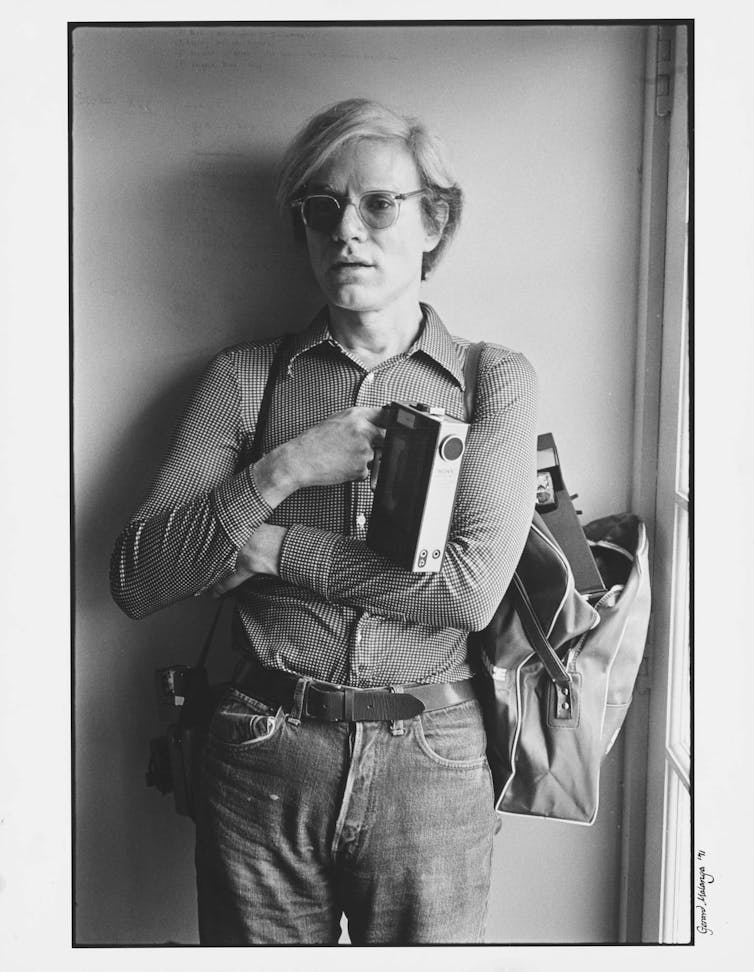
Warhol And The Camera
Warhol began using a polaroid camera in 1957 to record himself and his friends. He was a leading magazine illustrator in New York and he moved to using the camera as a source for imagery in commissions such as a photo spread for Harper’s Bazaar in 1963, and a cover image for Time Magazine in 1965 – both on display in the exhibition.
Photography for Warhol was a key part of his working method, even though some of his images have a snapshot quality.
He famously said:
I think anybody can take a good picture. My idea of a good picture is one that’s in focus and of a famous person doing something unfamous.
By 1961 he was using his photo-based imagery for his pop art silkscreens in his Campbell’s Soup Can series. His polaroid photographs continued to be the basis for many silkscreens, such as his exuberant Mick Jagger series (1975), co-signed by each.

His Ladies and gentlemen (1975) captured Black and Latino trans and drag queens. The models were sourced from the Gilded Grape bar, a nearby haunt of Factory photographers.

A stunning set of photographs on show come from his time in the 1970s and ‘80s producing gelatin-silver photo portraits of the celebrity figures based on initial Big Shot Polaroid images.
The dazzling array, which includes David Hockney, Henry Kissinger embracing Elizabeth Taylor, Liza Minnelli and Joseph Beuys, come from a mix of polished and in-situ photoshoots.

Late in his relatively short life, Warhol began stitching photographs together. Empire State Building (1982), showing multiples of the same image in grid formation, signals this new direction.
The Factory
This isn’t just an exhibition of Warhol, but also of his collaborators and contemporaries. The exhibition begins recreating the famous silver-lined Factory, the studio of Warhol and fellow photographers from 1964-68.
The Factory is remembered now as a site of legendary photographs and experimental films.
Warhol’s loosely scripted and silent experimental films on show from this time include the touchingly intimate Haircut (1964) and the delightfully chaotic Camp (1965). The “actors” were all, in fact, friends and acquaintances.
You sense the intensity of life there. Billy Name, the Factory’s archivist, said
it was almost as if the Factory became a big box camera - you’d walk in, expose yourself and develop yourself.
In this exhibition, Warhol’s photographs sit alongside photographs from Name, Steve Schapiro, Brigid Berlin and Robert Mapplethorpe.

Warhol himself is the subject in some photographs. Warhol would hand the camera around to other photographers like Jill Krementz who would capture him on film.
She is the photographer of Andy and Hitchcock, but the image is credited to Warhol, as often happened.

Other polaroids on show include Warhol’s homoerotic male torsos (1977), and the kissing series by Warhol’s collaborator Christopher Makos for a Valentine’s Day issue of Interview magazine, including Andy kissing John Lennon (1978).

Fleshing Out The Character
This is a large exhibition of 250-plus exhibits, including marked-up contact sheets, photobooth strip images, various cameras including the polaroid camera, issues of Interview magazine featuring Warhol’s photographs, and a video of his last exhibition in London in 1986 (he died unexpectedly in February 1987).

The final painting on show from that exhibition is Warhol’s camouflage-covered Self-portrait no. 9 (1986), an image that could be a composite of the many photographic portraits such as Makos’s Andy Warhol in American Flag, Madrid (1983).

The many portrayals of Warhol himself add flesh to his reputation as self-seeking, but they also penetrate the mask he so successfully cultivated. The Altered Image by Makos shows Warhol with a blond wig and wearing female make-up.
Makos recalled Warhol saying “I want to be pretty, just like everyone else”.

An Astounding Output
This exhibition is a wholly immersive time capsule capturing life in New York for Warhol and his circle in the 1960s, '70s and early '80s. It shows just how astounding Warhol’s output was as a photographer, and how photography underpinned his entire oeuvre.
As Makos observed at the opening, he had seen many a Warhol exhibition, but never one that captured this side of Warhol – and so perfectly too.
It is well worth a trip to Adelaide. It is not a touring exhibition and brings together key work from international and national collections.

The only inexplicable aspect is the lack of an exhibition catalogue, from a gallery with a reputation for producing prize-winning catalogues. Exhibitions are, by their nature, ephemeral events; the record lies in the catalogue.
For a groundbreaking one like this, presenting a new side to Warhol and his collaborative photographic practice, a record is needed.
Andy Warhol and Photography: A Social Media is at the Art Gallery of South Australia until May 14. ![]()
Catherine Speck, Emerita Professor, Art History and Curatorship, University of Adelaide
This article is republished from The Conversation under a Creative Commons license. Read the original article.
Great Mysteries of Physics 1: is time an illusion?

Without a sense of time, leading us from cradle to grave, our lives would make little sense. But on the most fundamental level, physicists aren’t sure whether the sort of time we experience exists at all.
This is the topic of the first episode of our new podcast series, Great Mysteries of Physics. Hosted by me, Miriam Frankel, science editor at The Conversation, and supported by FQxI, the Foundational Questions Institute, we talk to three researchers about the nature of time.
Scientists long assumed that time is absolute and universal – the same for everyone, everywhere, and existing independently of us. It is still treated in this way in quantum mechanics, which rules the microcosmos of atoms and particles. But Albert Einstein’s theories of relativity, which apply to nature on large scales, showed that time is relative rather than absolute – it can speed up or slow down depending on how fast you are travelling, for example. Time is also interwoven with space into “space time”.
Einstein’s theories enabled scientists to picture the universe in a new way: as a static, four dimensional block, with three spatial dimensions (height, width and depth) and time as a fourth. This block contains all of space and time simultaneously – and time doesn’t flow. There’s no special now in the block – what appears to be the present to one observer, is simply the past to another.
But if that’s true, then why is our experience of time moving from past to future so strong? One answer is that entropy, a measure of disorder, is always increasing in the universe. When you run the numbers, explains Sean Carroll, a physicist at Johns Hopkins University in the US, it turns out that the early universe had very low entropy. “[The universe] was very, very organised and non-random and it’s been sort of relaxing and getting more random and more disorganised ever since.” This is likely to create an arrow of time for human observers.
We don’t know why the universe started out with such low entropy, however. Carroll suggests it it may be because we are part of a multiverse containing many different universes. In such a world, some universes would, statistically speaking, have to start out with low entropy.
Emily Adlam, a philosopher of physics at the Rotman Institute of philosophy at the University of Western Ontario in Canada, on the other hand, believes the mystery of why our universe started with low entropy is a problem that ultimately stems from the fact that physics is riddled with assumptions about the time.
“I personally am very much on the side that says time does not flow,” she explains. “This is kind of an illusion that comes from the way in which we happen to be embedded in the world”. Her hunch is that, on the most fundamental level, everything happens all at once – even if it doesn’t appear that way to us.
Adlam argues the best way to understand time would be to remove it entirely from our theories of nature – to strip it out of the equations. Interestingly, when physicists try to unite general relativity with quantum mechanics into a “quantum gravity” theory of everything, time often disappears from the equations.
Experiments could also help shed light on the nature of time, helping to test various combinations of quantum mechanics and general relativity. Natalia Ares, an engineer at the University of Oxford, believes that studying the thermodynamics (the science of heat and work) of clocks may help. “By understanding clocks as machines, there are things that we can understand better about what the limits of timekeeping are,” she argues.
You can also listen to Great Mysteries of Physics via any of the apps listed above, our RSS feed, or find out how else to listen here. You can also read .![]()
Miriam Frankel, Podcast host, The Conversation
This article is republished from The Conversation under a Creative Commons license. Read the original article.
Lady Rhondda: the little-known suffragette whose efforts led to greater equality for women

The design for a statue of a leading suffragette has been unveiled in Newport, south Wales. Margaret Haig Thomas or Lady Rhondda was a lifelong campaigner for women’s rights and was the first woman to hold a hereditary peerage, though she was barred from taking up her seat in the House of Lords. She was also a successful businesswoman at a time when married women were often excluded from gainful employment.
The statue by artist Jane Robbins is part of a wider campaign dedicated to marking the contribution of women to the history of Wales. The sculpture is expected to be cast in bronze and erected in Newport in 2024.
The relationship between statues and our understanding of history is complex. In 2020, the toppling of the statue of slave trader Edward Colston sparked important questions about what statues are for and how they contribute to the public’s understanding of the past.
Many statues, like Colston’s, were created in the 19th century as honorific symbols of power. Those representations of authority are now rightfully being questioned. Conversely, the creation of statues of women has the potential to acknowledge their often hidden yet important impact.
Across the UK, there are very few statues dedicated to named women that aren’t royal or mythological in nature. Out of more than 800 statues, only 128 are of named, non-royal women. Until late 2021, there was not a single such statue in Wales.
This is why the ongoing campaign to create a statue of Lady Rhondda matters. She was a woman who sat on the boards of 33 companies and became the first female president of the Institute of Directors in 1926. She was an outlier.
But looking only to Lady Rhondda’s professional success risks aligning her with those traditional forms of biography, memorials and statues that typically celebrate “great” men as exceptional individuals.
Very few women can fit into this mould. And this limited view of success may be one of the reasons we know so little about women’s influence throughout history. Fortunately, the work of historians has uncovered Lady Rhondda’s life story beyond her professional achievements.

Lady Rhondda was an active member of the militant wing of the suffragettes, the Women’s Social and Political Union, under Emmeline Pankhurst and was arrested for setting fire to a postbox. She travelled across Wales mobilising women (and a few men) to the cause.
One of her vital accomplishments was her push for further reform immediately after landmark changes to women’s rights in the early 20th century. In fact, she shattered the misguided notion that votes for women meant equality had been achieved.
When the Sex Disqualification (Removal) Act 1919 permitted women to become professionals, such as solicitors, magistrates and civil servants, for the first time, it appeared that Lady Rhondda could also take up her hereditary peerage and sit in the House of Lords. But her entry was blocked by the Lord Chancellor, Lord Birkenhead.
Though she lost her case challenging this and was never able to sit in the Lords, she spent the next few decades campaigning for reform until her death in 1958. Her efforts influenced the passing of the Peerage Act 1963, which enabled female hereditary peers to take their seats for the first time.
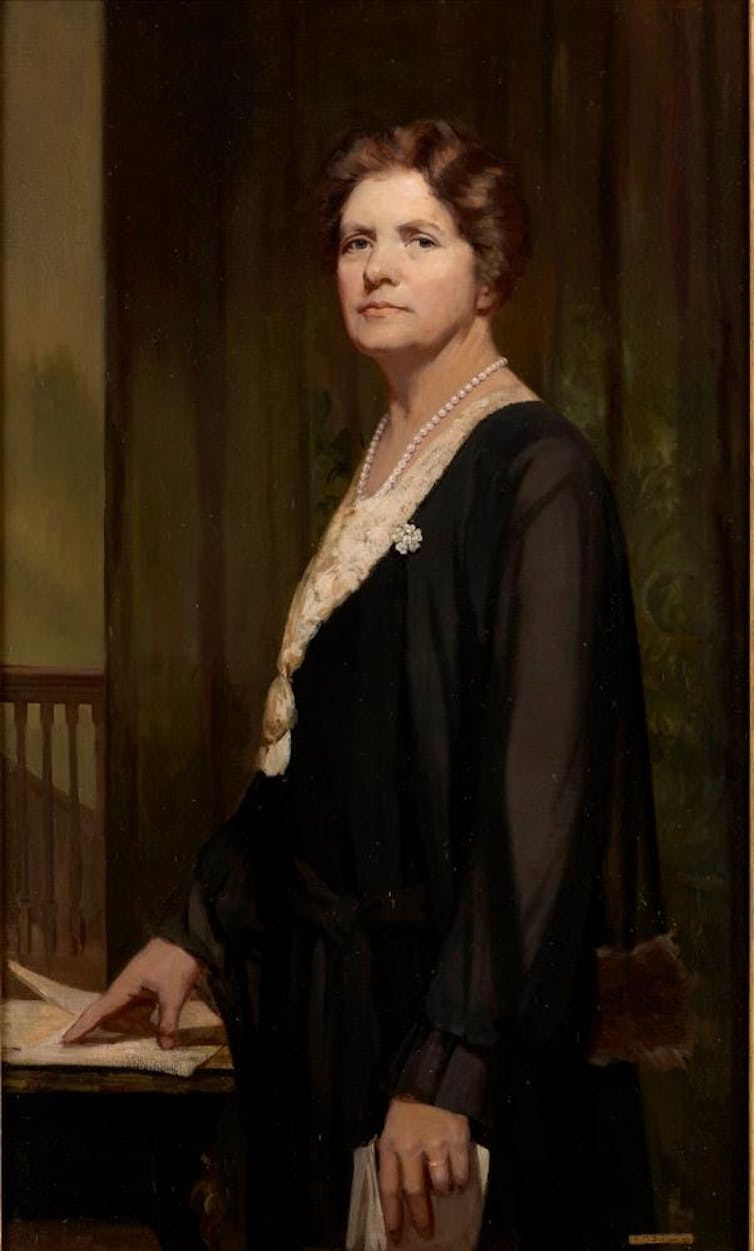
Lady Rhondda mobilised women to push for change on other fronts too. In February 1921, she established the Six Point Group. This was a pressure group comprising women able to vote at that time to work towards equal rights through legal reform. As their name suggests, they targeted six issues at a time. Once they had achieved as much as they could in one area, another issue would take its place.
The activities of the Six Point Group were publicised in Time and Tide, a groundbreaking feminist periodical that Lady Rhondda founded, owned and edited. It included work by literary greats such as Virginia Woolf and George Bernard Shaw.

While the Six Point Group remains a relatively unknown part of the women’s movement, it asserted an important influence. It raised awareness of issues relating to equal pay, reform of the law on child assault and the rights of housewives. It was also behind the establishment of the Married Women’s Association, which I have argued had a profound influence on married women’s property rights throughout the 20th century.
Statue
The campaign for a Lady Rhondda statue was initiated by Monumental Welsh Women, an organisation seeking to correct the almost complete absence of statues representing women’s achievements throughout history. Efforts to fund the statue continue.
In contrast with traditional statues, Lady Rhondda’s will be just over 2 metres (7 ft) in height, so the public can observe its features up close. The statue’s hoop will be made from hand casts of the women involved with the project, symbolising unity.
If it is erected, the statue will create new opportunities for dialogue not just about why women should be commemorated, but how.![]()
Sharon Thompson, Reader in Law, Cardiff University
This article is republished from The Conversation under a Creative Commons license. Read the original article.
Phoracantha Semipunctata: The Australian Eucalyptus Longhorn
This week an insect with a pretty shell came inside the house. After taking a photo and looking it up we found out it is a Eucalyptus longhorn, and a species of beetle in the family Cerambycidae.
Longhorn beetles (Cerambycidae), also known as long-horned or longicorns (whose larvae are often referred to as roundheaded borers), are a large family of beetles, with over 35,000 species described. Most species are characterized by extremely long antennae, which are often as long as or longer than the beetle's body.
Native to Australia, the Australian Eucalyptus Longhorn has now spread to many parts of the world, including practically all countries where tree species of Eucalyptus have been introduced. It has been classified as an invasive pest species of Eucalyptus outside Australia.
Within Australia, Phoracantha semipunctata primarily seeks decaying trees and branches.
Phoracantha semipunctata are typically dark brown and beige in colour and are approximately similar in size measuring at around 2.3cm long. They are most active during the early dusk hours, and are found in populations within host trees, which are predominantly male-oriented. These host trees are determined according to the suitability of adult mating and oviposition, and the viability of larvae development.
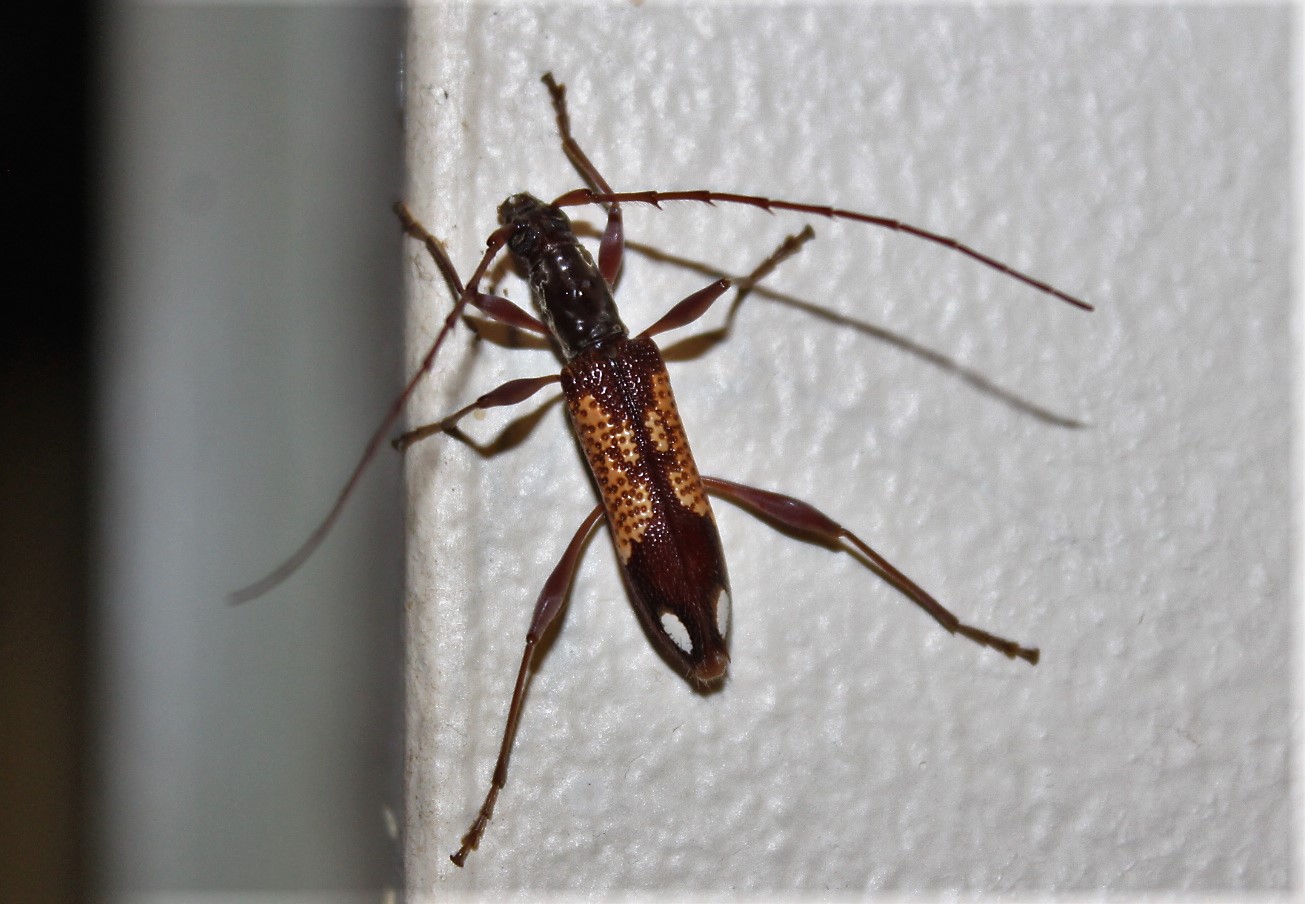
There are 4 key processes that occur within its lifecycle — Egg, larval, pupation and adult.
Female Phoracantha semipunctata lay approximately a batch of 40 eggs, where eggs are laid below detached bark, present within stressed host trees.
After the eggs hatch, larvae emerge and begin acquiring nutrients from the cambium and phloem segments, excavating through the external layer of bark to consume in the inner bark and exterior xylem tissues.
Pupation will occur after larvae development. Larvae Phoracantha semipunctata, will establish pupal chambers, within the sapwood or in some cases the heartwood, where they will develop into adult beetles. Pupation may take up to 10 days.
After pupation, adult Phoracantha semipunctata will then begin digging themselves out the pupal chamber in which they will then create a 8-10mm opening in the external bark layer. The total life cycle of P. semipunctata varies; however, in host trees with high larvae competition, their total lifecycle may be significantly depleted and only span up to two months.
Phoracantha semipunctata eggs and larvae are subject to various natural predators which may diminish their viability during the development process. Braconid parasites, including Syngaster lepidus, and Bracon capitator have been recorded to have negative effects. These female wasps infuse a certain venom within the larvae, stopping any further development and feeding that can be done.
There are also other species of beetle which lower larvae survivorship, including Trogodendron fasciculatum and Aeschyntelus vittatus.
Trogodendron fasciculatum, the yellow-horned clerid, is a small beetle of the family Cleridae (checkered beetles). It too is native to Australia, and feeds on other insects.
.jpg?timestamp=1678556922554)
Clerid beetle of the species Trogodendron fasciculatum (Schreibers) or yellowhorned clerid. Taken in January 2007 on a eucalyptus tree in Swifts Creek, Victoria, Australia. Photo: Fir0002/Flagstaffotos
Ants are also a problem for them as they simply carry the beetle eggs within Eucalyptus trees off to their own nest.
The resilience of Eucalyptus species to these insects is best achieved by looking after these. Making sure there is sufficient water during long durations of dry condition helps as longhorns need dry trees that are not too well to thrive and 'bore' into them.
Certainly not a 'boring' place to be though - seeing what comes indoors or what lives in the garden.
We'll add this into the collection for you and keep it in: Insects, Bugs & Local Wildlife Insights For Youngsters: 2023
LITTLE SHIPS OF BAYVIEW.
The little ships of Bayview they are bravely slim and small,They go out by Barrenjoey, where they shouldn't go at all;
You may watch their bowsprits tossing, where the coastal steamers go
These little ships of Bayview, with their sails as white as snow.
The little ships of Bayview, they come sailing In at night,
With a silver path behind them, and the moon to mark their flight;
There are shaky lights at Newport, and an arch of stars that know
The little ships of Bayview, with their sails as -white us snow.
There are songs across the water, as the little ships go by,
To their anchor-buoys at Bayview, where the sleepy houses lie;
Faint and drowsy nod their anchors, and the stars lean very low,
On the little ships of Bayview, with their sails as white as snow.
-GILBERT MANT.
LITTLE SHIPS OF BAYVIEW. (1925, August 22). The Sydney Morning Herald (NSW : 1842 - 1954), p. 11. Retrieved fromhttp://nla.gov.au/nla.news-article16237249
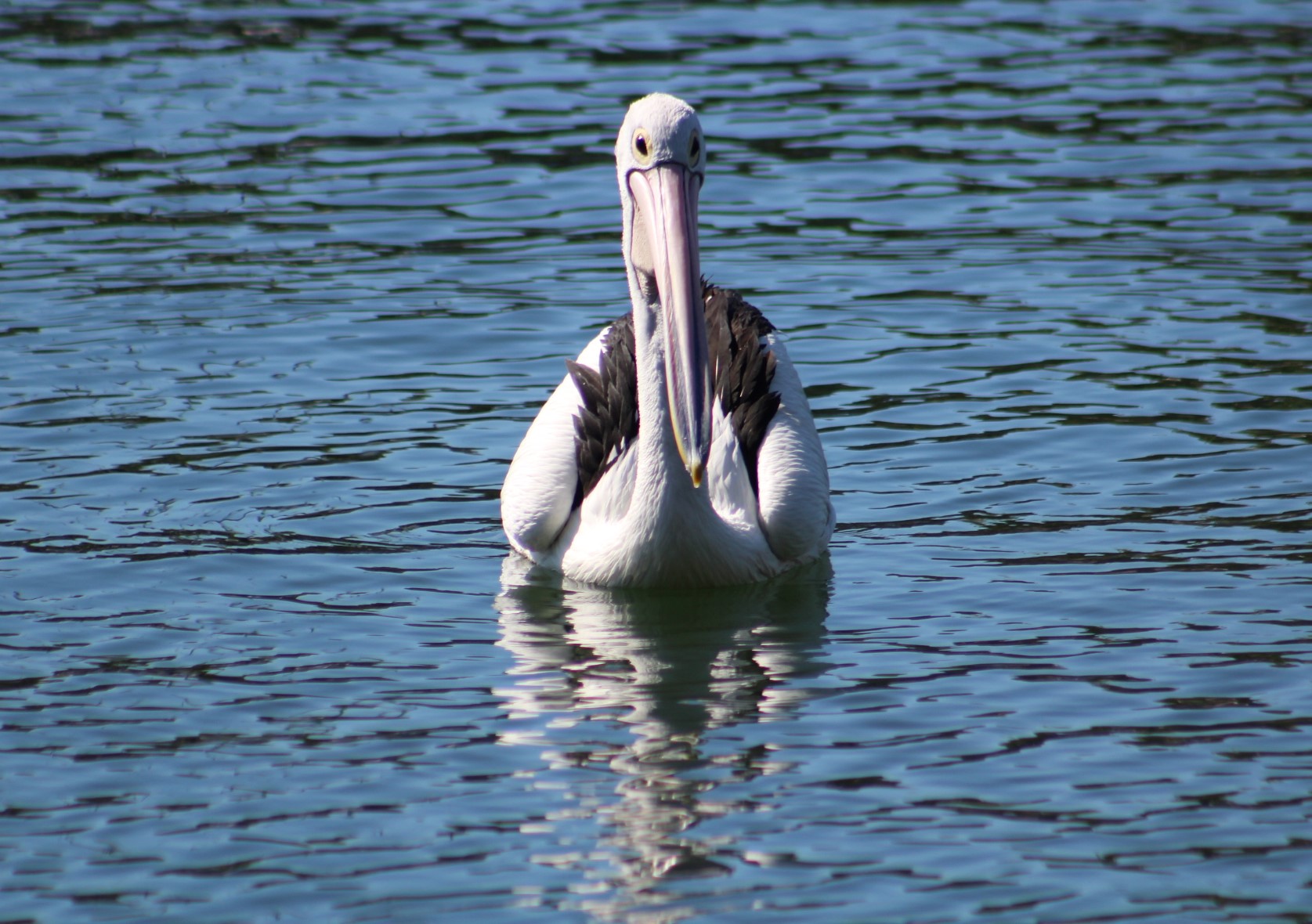
Pelican, Bayview, Pittwater - Saturday March 11, 2023
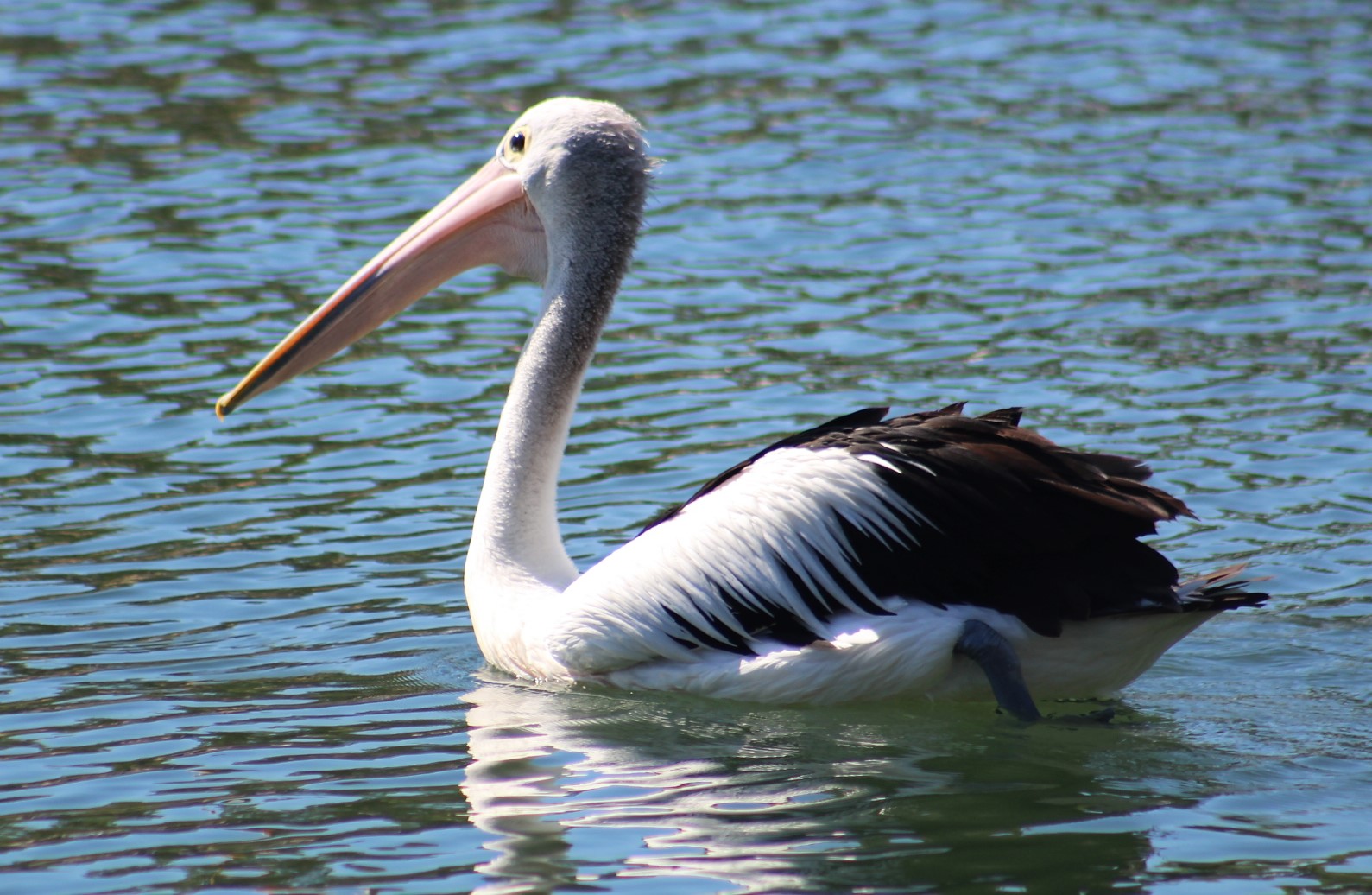
Armidale Provincial City
From the Film Australia Collection of the National Film and Sound Archive. Made by the Commonwealth Film Unit 1958. Directed by Ralph Hogg, Richard Mason.
An overview of the thriving city of Armidale, it's rural life, educational institutions and the highly regarded University of New England. Outlines the interconnection between the city and the land.
Poor Sleep Linked To Years Of Poor Cardiovascular Health
Spinal Cord Stimulation Doesn't Help With Back Pain, Says New Review
Applications Now Open For Inaugural $10,000 Military History Prize
Mary Wollstonecraft: an introduction to the mother of first-wave feminism

Mary Wollstonecraft has had something of a revival in recent years.
Though considered the mother of first-wave feminism, the 18th-century philosopher long endured her share of trolls refusing to take her seriously. She was dubbed a “hyena in a petticoat” by contemporary politician and writer Horace Walpole, accused of being “unsexed”, unladylike, and of having no shame. She even fell out of favour with some 20th-century feminists.
But in the last decade and a half, popular interest in her life and work has grown exponentially with the emergence of Wollstonecraft blogs,societies,campaigns and even Instagram and Facebook accounts in her name. Her public commemoration has ranged from the traditional blue plaque to a controversial sculpture in her old north London neighbourhood.
As the author of an impassioned plea for human rights, and one of the earliest and most-read statements of feminism, Wollstonecraft today has a well-deserved status as a feminist icon. But we should also take pause when looking at how she is presented, especially when she is shown as the main representative of British feminism.
Education As Politics
Born in 1759 in London to a middle-class family, Wollstonecraft spent her youth watching her mother suffer at the hands of an abusive father. An avid reader, frustrated by the limited education and career options open to girls, Wollstonecraft set out to educate herself.
With her sister and friend, she opened a day school for girls in Newington Green. The focus of most of her writings was moral conduct, education and child rearing because she believed that this was the main route to changing the culture and creating a new path for women and girls. For Wollstonecraft, education was political.
Like her fellow north London radicals, Wollstonecraft was a passionate supporter of the French Revolution. She hoped for a similar shift toward democratic republicanism in British politics.
When the political philosopher and MP, Edmund Burke, wrote his famous treatise condemning the revolution and defending the British monarchy, she was so incensed that she wrote and published a response. This was the start of the so-called “pamphlet wars” which resulted in hundreds of responses to Burke (the most famous of which was Thomas Paine’s Rights of Man).
Both Paine and Wollstonecraft defended a doctrine of “natural rights”. This is the idea that man is naturally endowed with rational thought and an ability to think independently, and therefore judge for himself.
But neither Paine nor most of the French revolutionaries that Wollstonecraft so admired actively extended this thinking to women. The new French Republic, in fact, relegated all women (and men without property) to the status of “passive” (non-voting) citizens who were not considered independent enough to make their own decisions.
Wollstonecraft’s most famous text, A Vindication of the Rights of Women, is largely a treatise on the edifying effects of the right kind of education on virtue.
Wollstonecraft did not mean sexual purity when she spoke of virtue, however. Virtue was indicative of moral character and primarily expressed in the ability to make sound, informed and rational judgements.
Moral character also included, for Wollstonecraft, humility and self-discipline and a willingness to look outward from selfish or trivial wants to the needs of others. These were the republican (and indeed Protestant) virtues that good citizens in the new post-revolutionary democracies would need.
Wollstonecraft argued that women are equally capable of acquiring these virtues and of benefiting from a full education if only given the chance to develop their capacities in the same way as men.
Gender Norms As Social Constructs
The idea that reason is not the sole provenance of men also meant that Wollstonecraft was already making an argument, often attributed to Simone de Beauvoir in The Second Sex and to the so-called second-wave feminism of the 1950s and 1960s, that gender norms are socially constructed.
Rational qualities, argues Wollstonecraft, are not naturally gendered. They are learned and shaped by environment, especially by upbringing, education and culture. If education is narrow and confined, it will produce narrow and confined thinking. This is what she meant when she wrote of women: “Make them free and they will quickly become wise and virtuous.”

Wollstonecraft wanted to free women from being forced to focus solely on trivial accomplishments that would make them a better wife. Wollstonecraft herself lived a life that largely defied convention, but it was evidently not an easy one.
This is, far too often, still the life that women live today: caught in a struggle to break free of preconceived notions about who and what we can be, what we should wear, how we should look, and what we should value in ourselves.
Wollstonecraft asserted the simple idea that women were fully fledged people with the capacity to decide on and forge a path for themselves. Obvious to us, but the revolutionary character of this idea, should not be underestimated.
It is the same notion that nearly a century later got John Stuart Mill lampooned and laughed at in the House of Commons when, as Westminster MP, he proposed to substitute the word “persons” for the word “men” in the voting reform bill of 1867 so as to include women in universal suffrage.
This idea, that women are rational beings with a right to self-determination, must still be fought for daily around the world. This is the case in every instance where, as women, we are forced to assert that we are not objects, or property, that we have not been made for someone else’s use or pleasure, that it is not justified to exclude us from education or politics, or prevent us from speaking our minds, whether through laws, violence, intimidation or ridicule.
Personal Liberation
Wollstonecraft has striking relevance for us and she is responsible for inspiring generations of activists. However, she had her blind spots. She was not writing for working class women and she said little about women of colour in spite of her abolitionism. Today’s women around the world deal with issues that Wollstonecraft could never have imagined.
Nor is it helpful when she is simplistically presented as paving the way for the suffragettes. In claiming Wollstonecraft, the suffragette movements rescued her memory from a largely negative obsession with her sexual morality. But they also did her a disservice by reducing her aims to a battle for legal and political equality.
Equal treatment is indeed a necessary condition for women’s progress. But it is not a sufficient condition for women’s freedom. Wollstonecraft herself was more interested in personal liberation. In fact, she never made voting a focus of her writings.
Wollstonecraft wanted something much more than voting, something that too often we still do not have: liberation from prescribed notions of who or what we can be and from the fear of being who we are.
Liberation from oppression means being able to define ourselves and the direction of our lives. And this requires access to the intellectual resources and knowledge needed to develop independence of mind. This is Wollstonecraft’s most important message, and one that should speak to everyone regardless of gender.![]()
Bridget Cotter, Lecturer, Social Sciences, University of Westminster
This article is republished from The Conversation under a Creative Commons license. Read the original article.
Pension Increase: How Often Important As How Much
About The Warfarin Shortage 2023

From The COTA NSW CEO: People Over 50 Largest Voter Group In NSW

Marika Kontellis
COTA NSW CEO
Australia’s first female journalists reported on wars and human rights around the world – but many died in obscurity

When I look out into a class of journalism students, the faces I see will often belong to young women. In contemporary journalism education, this is the norm. In many countries, about two thirds of journalism tertiary students are female. And in Australia, women have held the majority of journalism jobs for some time.
This is a remarkable turnaround when you consider journalism was, not that long ago, almost entirely produced by men. It was only after the 1950s that women started joining the profession in small numbers. Even then, they were typically confined to writing for the “women’s pages”.
Before this time, female journalists were almost unheard of. Which makes the women of Bold Types, who worked as journalists in Australia from 1860 to the end of World War II, particularly worthy of our attention.
Review: Bold Types: How Australia’s First Women Journalists Blazed a Trail – Patricia Clarke (National Library of Australia Publishing)
Facing obstacles at every turn, they were adventurous and incredibly courageous. As author Dr Patricia Clarke writes:
The journalists in Bold Types were a particularly ground-breaking group, given the societies in which they were living. The earlier journalists wrote thousands of words in longhand using quill pens. They ventured into muddy battlefields, down mines and into slums and prisons in their crinoline-style, ankle length dresses. Women who reached positions of standing and power could suffer the full brunt of gender discrimination either publicly or subtly. They also had to ignore the ethos of a society that disapproved of middle-class women working at all, much less in a such a public job at journalism.
Gender Inequality Was ‘Part Of The Deal’
An historian and author, Clarke is well placed to tell these stories. She worked as a journalist in male-dominated newsrooms, including at the ABC, during the 1950s and 1960s. Gender inequality was part of the deal, she writes, and sexual harassment was rampant.
At the time, most female journalists were employed on the women’s pages, where they typically covered social events and were paid at low rates, despite their coverage generating significant revenue from advertisers.
Some of the women who feature in Bold Types wrote for the women’s pages, often in addition to more satisfying work. But others eagerly took on roles that were usually only assigned to men. These include Anna Blackwell, Australia’s first female correspondent, who reported from Paris for the Sydney Morning Herald from 1860, and Jessie Couvreur, who worked for the London Times as Brussels correspondent in the 1890s after growing up in Hobart.
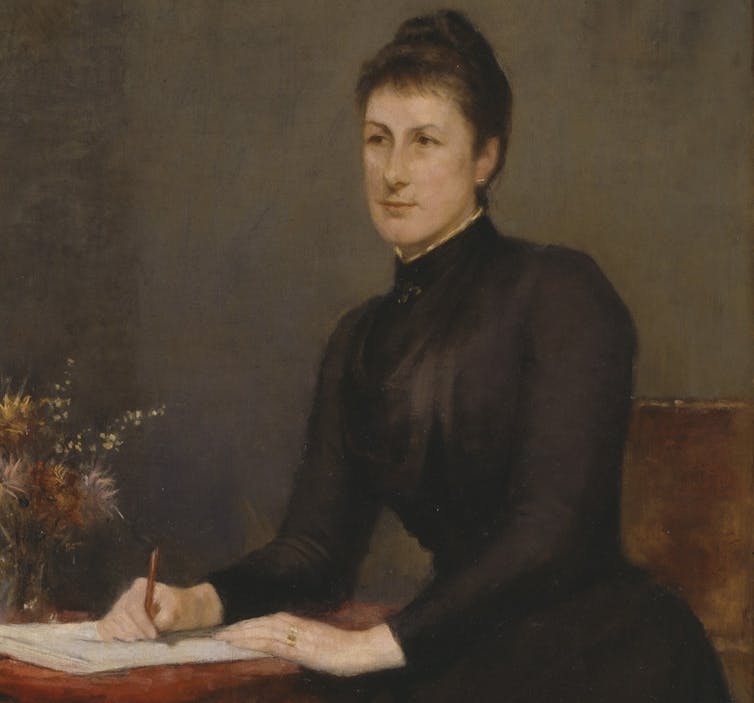
Others demonstrated remarkable bravery and resilience in jobs that were physically demanding and dangerous. Flora Shaw, a British journalist, travelled throughout regional Australia in 1892. Travelling by buggy and steamer, Shaw reported on the sugar, mineral and pastoral industries of Queensland.
She then toured Western sheep stations in a journey of more than 800 kms in an open buggy, in temperatures often above 40 degrees. After a short stint in Brisbane, she continued her journey through the southern states, reporting on the fruit and butter industries in Victoria and on the Barossa wine region. The hazards and discomfort she experienced were recounted in letters to her sister.

The trip took a toll on her health, but Shaw continued to write and post her articles to The Times. She returned to London in late 1883 to wide acclaim and was appointed to the influential position of Colonial Correspondent, a role that saw her become the highest-paid female journalist in London.
A few years later, another female journalist, Edith Dickenson, also travelled great distances under difficult circumstances to fulfil her reporting role. She was Australia’s first female war correspondent, sent to Durban in 1900 to cover the Second Boer War.
Edith had already lived an unconventional life, moving to Melbourne from England in 1886 to meet her lover, Dr Augustus Dickenson. Both Edith and Augustus were married to others; Augustus was eventually prosecuted and found guilty of deserting his infant daughter in England. For many years he regularly “disappeared”, moving between small towns in regional Australia, always accompanied by Edith and her sons.

During this time, Edith became a photographer and eventually began producing newspaper articles as a freelancer. Before being assigned to cover the war for the Adelaide Advertiser, she wrote about her journeys through India and the East, establishing herself as an “intrepid traveller with remarkable stamina”.
These traits were to prove invaluable in South Africa, where she was able to move across the country after receiving a formal correspondent’s pass. She gained a reputation for her detailed scene-setting and even-handed approach. When all civilians were barred from the town of Ladysmith due to high rates of dysentery and enteric (typhoid) fever, Edith managed to gain entry and interview survivors.
By October 1900, the British had taken the Boer capitals and most of the major fighting was over, so Edith left South Africa. However, she returned in 1901 to report on the concentration camps set up by the British to house displaced women and children.
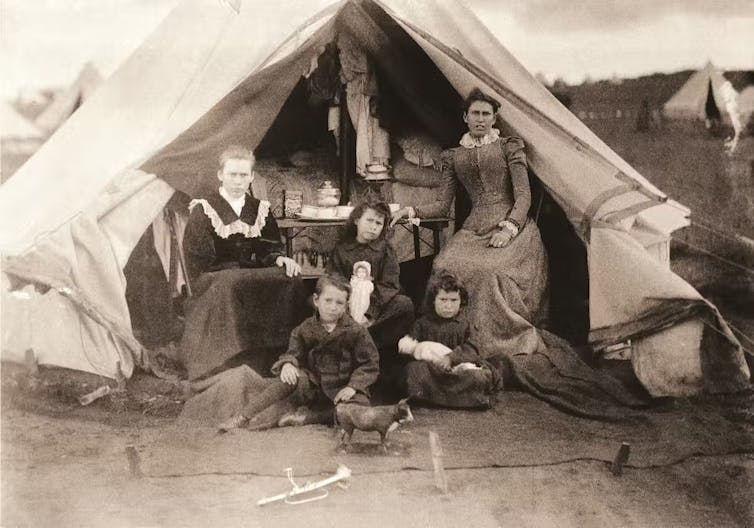
“During the next six months, Edith’s Advertiser articles were a savage indictment of conditions in British camps,” Clarke writes.
Everywhere she reported overcrowded tents, some located nearly two kilometres from a source of water, others set up on marshy ground. Food was inadequate, unsuitable, and contaminated. Malnutrition and epidemic diseases were rife, and mothers were separated from their children.
Dickenson died at age 52 after completing a third trip to South Africa. According to Clarke, she remained unequalled for many years, including the two world wars, when the movements of Australian women journalists were tightly controlled.
Extraordinary For Their Times
Not all the stories in Bold Types are as dramatic as Shaw and Dickenson’s, but each of the women profiled were extraordinary for their times. Most were freelancers, relying on low and irregular payments. Many were also activists fighting for women’s and/or workers’ rights. Almost all who worked in mainstream media faced opposition and condescension from male colleagues who felt threatened by their presence.

Some, like Texas-born Jennie Scott Griffiths, worked as journalists while overseeing large families (Scott Griffiths had ten children). Others, such as feminist and social activist Alice Henry, defied convention and never married or had children. In many cases, they brought attention to the discrimination and exploitation experienced by women. Speaking out against the establishment rarely led to success. A sad and recurring theme throughout the book is that these women often died in obscurity.
The women of Bold Types led the way for the many prominent women reporters and presenters in Australia today. The opportunities in journalism for women have grown hugely since the late 1970s, which signalled the end of the traditional women’s pages.
However, we still have a long way to go, cautions Clarke, echoing the Guardian’s Amy Remeikis in her introduction to the book. “The public profile of notable women disguises the fact that women journalists struggle to attain real influence in decision-making roles,” Clarke says. “Few reach leadership positions with power over recruitment and promotion, and content is still determined predominantly by men, resulting in sexual bias.”
Bold Types provides a welcome and overdue rewriting of the history of Australian journalism. It should be of interest to reporters, news bosses and educators, who can finally acknowledge the pioneering contributions of our first female journalists.![]()
Kathryn Shine, Associate Professor, Journalism, Curtin University
This article is republished from The Conversation under a Creative Commons license. Read the original article.
Housing Crisis: Five Initiatives That Should Be On The NSW Election Agenda - UNSW Housing Experts Weigh In
Antipsychotics are increasingly being prescribed to children – here’s why we should be concerned
Matthias Pierce, University of Manchester and Kathryn Abel, University of ManchesterAn increasing number of young people in the UK are being referred to child and adolescent mental health services (CAMHS). Alongside this is the rising number of children prescribed medicines that treat mental illness.
The evidence for the effectiveness and safety of these drugs comes almost entirely from studies in adults. Studies in children are rare.
While some of these drugs are effective in some children, the extent of improvement is often small. And there is limited information about the long-term safety in this age group.
In a recent study, we report that the proportion of children prescribed antipsychotic drugs doubled between 2000 and 2019. We analysed data from 7,216,791 people aged three to 18 years old.
In the UK, antipsychotics, also known as “major tranquillisers”, are approved for use in under-18s with psychosis or with severely aggressive behaviour. A growing body of evidence also suggests that two of these major tranquillisers, aripiprazole and risperidone, may be effective for improving irritability and “emotional dysregulation” in autistic children.
Percentage of children prescribed antipsychotic drugs in the UK by year:
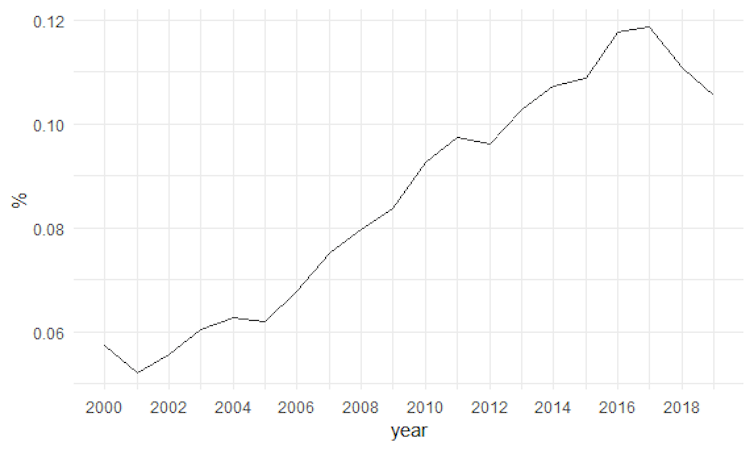
Although antipsychotics are most commonly being prescribed for children with autism and psychosis, they are also being prescribed for an increasingly wide range of other reasons, such as anxiety disorder, depression and ADHD.
In absolute terms, the overall percentage of children prescribed antipsychotics was small – 0.06% of children in 2000 and 0.11% in 2019. Clearly, some children benefit from taking these drugs.
Yet increasing use of these drugs in young people whose bodies and brains are still growing and developing raises questions about safety. Evidence for this has yet to be established.
Antipsychotics have significant side-effects, including sexual dysfunction, rapid weight gain and a greater risk of type 2 diabetes, known as metabolic syndrome.
Antipsychotics are grouped according to whether they belong to the first or the second generation of drugs developed for psychosis treatment. The first generation was developed in the 1950s, but the drugs were associated with a risk of infertility, stiffness, Parkinson’s-like tremors and other involuntary movements.
Second-generation antipsychotics, first emerged in the 1980s and were initially thought not to have these effects. However, many do, such as the widely prescribed drug risperidone. In addition, they have been found to have other negative effects on metabolism, including rapid weight gain and obesity, diabetic-like changes to blood glucose, and pre-diabetes.
At the beginning of the period we studied (2000), we saw almost as many first-generation as second-generation prescriptions to children. After 2009, more than 90% of all prescriptions to children were second-generation antipsychotics.
But we also noted that the older, first-generation antipsychotics were more likely to be prescribed to children in poorer areas. The reason for this potential prescribing inequality is not clear, but it needs to be investigated.
Not Everyone With A Diagnosis Needs A Pill
The increasing number of children taking antipsychotics could, of course, be the result of more children needing these treatments and the potential benefits they deliver. But the fact that many more children are being referred to CAMHS does not necessarily mean that many more children need treatment with major tranquillisers.
Another possibility is that it reflects a reduction in the stigma surrounding mental illness or better awareness of mental health problems at an earlier stage of distress, and changing attitudes of parents, teachers and GPs about what CAMHS provides.
The number of young people experiencing anxiety and depression has increased, particularly in girls and young women, but there is limited evidence that the types of conditions requiring antipsychotic treatment are increasing.
A recent study reports that the number of children with a diagnosis of autism increased exponentially over 20 years from 1998, probably reflecting a growing awareness of the disorder. Yet most of these cases are children with milder autism – children who are unlikely to require antipsychotic drugs.
Increasing access to CAMHS can have a perverse influence on the quality of care, such that more young people receive readily available prescriptions rather than more resource-intensive psychological, social or family support. In such a landscape, health inequalities highlighted during the pandemic may increase, and in so doing, further disadvantage children and families least able to gain the help they need.![]()
Matthias Pierce, Research Fellow in Psychology and Mental Health, University of Manchester and Kathryn Abel, Professor of Psychological Medicine, University of Manchester
This article is republished from The Conversation under a Creative Commons license. Read the original article.
Long COVID linked to air pollution exposure in young adults – new study

Although COVID-19 infections are typically less severe in young adults, that doesn’t mean they aren’t still at risk of complications from COVID-19. For example, around one in 25 adults aged over 16 have reported suffering from long-term COVID-19 symptoms after their first infection. For some, these symptoms lasted for almost two years.
While we are getting closer to understanding some of the genetic and immunological mechanisms that cause long COVID, there’s still a lot we don’t know about the condition – including why people with otherwise mild COVID-19 infections go on to develop long COVID.
We also now know about some of the risk factors that make people more likely to develop long COVID – including suffering from chronic diseases and having an unhealthy lifestyle. And our latest study has now revealed that, at least for young adults aged 26-28, where they live may heighten their risk of long COVID.
While most people recover from a COVID-19 infection after a few weeks, for some people their symptoms may continue to persist for months or even years afterwards. The most common symptoms include extreme tiredness, loss of smell (or taste), muscle aches and shortness of breath, though other symptoms – such as brain fog – have also been reported. While there is no one test for long COVID, a doctor may diagnose the condition through blood tests, checking blood pressure or chest x-rays.
Our study found that young adults who lived in highly polluted areas were more likely to suffer from long COVID compared to those living in areas with low levels of pollution.
Air Pollution And COVID-19
In our latest study, published in Lancet Regional Health Europe, we investigated the impact of long-term air pollution exposure on risk of long COVID in young adults.
To conduct our study, we used data from the ongoing BAMSE birth cohort. This study began in 1994 in Stockholm County, Sweden and recruited 4,000 newborns – many of whom are still being followed today. Participants were given frequent questionnaires and participated in clinical examinations during childhood and adolescence to track various aspects of their health.
Between August 2020 and February 2022, participants attended a COVID-focused follow-up. Among the 753 study participants who’d had COVID, almost one in six who’d had a mild or moderate infection reported suffering from lingering symptoms for two months or more. The most common persistent symptoms reported were altered sense of smell or taste, shortness of breath and extreme fatigue.
We then estimated the level of air pollution participants were exposed to before the pandemic by looking at pollution levels at their residential addresses. We found that being exposed to relatively high levels of air pollution in 2019 – especially fine particle air pollution, which primarily originates from traffic – was linked with a 28% greater likelihood of having long COVID compared with those living in low-pollution areas.

This association remained even after taking into account other factors potentially linked with both greater COVID risk and exposure to air pollution – including socioeconomic status, whether they smoked and if they had any other health conditions (such as asthma).
The association between air pollution and likelihood of developing long COVID were also stronger for specific long COVID symptoms – particularly those relating to respiratory health, such as shortness of breath.
Air Quality
Air pollution is the fourth leading cause of death worldwide. It’s linked to multiple diseases, including asthma, chronic obstructive pulmonary disease and stroke, as well as COVID-19.
Our study is now the first to link air pollution exposure with long COVID in young adults.
It’s currently unknown why air pollution may be linked to long COVID. But based on what we know from other studies on the harms of air pollution, one potential explanation could be because air pollution triggers inflammation in many tissues and organs of our body. While inflammation is the body’s way of protecting itself from harmful pathogens – such as bacteria or viruses – it can also be harmful and destructive to the body itself. Thus, long-term inflammation linked to air pollution exposure may trigger the range of symptoms people report experiencing with long COVID.
But it will be important to continue exploring other possible mechanisms, including genetic and immunological factors, that explain why people living in highly polluted areas are more likely to develop long COVID. It will also be important to explore whether there’s a similar link between air pollution and long COVID in other age groups.
And, since our study was conducted before most participants had received the COVID-19 vaccine, future research will need to take this into consideration and evaluate whether vaccination alters this link at all. These will be the focus of our next follow-up study with this cohort.
We hope that our findings will add to our understanding of long COVID, which may in turn help us better know how to diagnose and treat the condition. Our research also further adds to the current body of evidence showing just how harmful air pollution is for human health. Given everyone is somehow exposed to air pollution in their lifetime, it’s clear more needs to be done to reduce air pollution levels worldwide in order to improve all aspects of health.![]()
Zhebin Yu, Postdoctoral researcher in Environmental Medical Epidemiology, Karolinska Institutet; Erik Melen, Professor of Paediatrics, Karolinska Institutet, and Sandra Ekstrom, Postdoctoral Researcher in Epidemiology, Karolinska Institutet
This article is republished from The Conversation under a Creative Commons license. Read the original article.
Postpartum exercise can have many benefits – here’s how to do it safely

Returning to exercise after having a baby has many health benefits, including reducing symptoms of postpartum depression and improving fitness. But many women aren’t sure how to return to exercise safely after having a baby.
You can start preparing for your return to exercise during pregnancy. By exercising as long as it’s safe to do so, you can limit the amount of “deconditioning” (loss of fitness as a result of inactivity) the body undergoes – making it easier to get back to exercise after having a baby.
But even if you didn’t exercise very much during your pregnancy, it’s still possible to transition safely back into exercise after having your baby. The key is to progress gradually and listen to your body every step of the way.

This article is part of Quarter Life, a series about issues affecting those of us in our twenties and thirties. From the challenges of beginning a career and taking care of our mental health, to the excitement of starting a family, adopting a pet or just making friends as an adult. The articles in this series explore the questions and bring answers as we navigate this turbulent period of life.
You may be interested in:
Six reasons to take up yoga during pregnancy
Meeting a friend’s new baby? Here’s what – and what not – to do
Baby names: why we all choose the same ones
Those First Few Weeks
One of the first exercises you should do after having a baby is pelvic floor exercises. The pelvic floor helps maintain bowel and bladder function, supports the pelvic organs (bladder, bowel and uterus), and is important in facilitating sexual function and pleasure. During exercise, these muscles also tolerate the forces produced during exercise – those from the ground, transferred up the legs, and those produced internally in your abdomen.
Pelvic floor exercises can help prevent urinary incontinence, which affects around one in three women after having a baby. To strengthen the pelvic floor, tighten your muscles by imagining you’re trying to stop gas or the flow of urine. Release your muscles again after a second or two. That’s one repetition. Aim to do eight to 12 reps, with the goal of eventually holding each rep for ten seconds.
Core exercises, such as pelvic tilts or glute bridges, can also be reintroduced in the weeks after delivery. These help to recondition the abdominal wall muscles that have been stretched during pregnancy. Start with just a few repetitions of each exercise at first. You can also try doing body weight exercises such as squats and lunges.
Walking also has many health benefits, even in small doses, and is easy to get back into after giving birth. It’s safe to walk daily, just be sure not to do too much too soon. And avoid unnecessary strenuous activities in the weeks after giving birth, such as pushing a buggy up a steep hill. This is especially important if you’ve had a caesarean section, as your recovering muscles may not be ready for this strain yet.
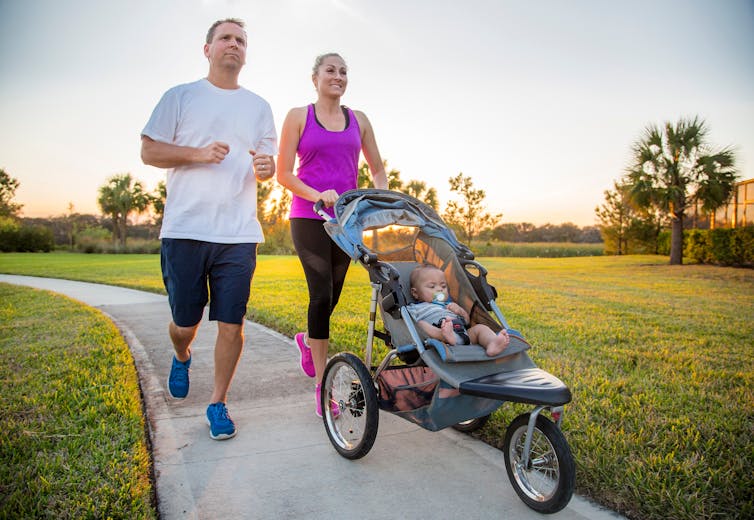
Low-Impact Exercise
After a few weeks of pelvic floor and core training, you’ll probably want to progress to low-impact exercises – such as cycling on a static bike or power walking – in order to exert yourself more and reap even more health benefits of exercise. You’ll know you’re ready to progress if you haven’t experienced any issues with your pelvic floor (such as incontinence and vaginal heaviness) or had setbacks such as pain or infections.
If lochia – the normal loss of blood following childbirth – has ceased you could also try swimming or water aerobics, which are known to offer many health benefits. If you’ve already been doing body-weight exercises, consider adding light weights to progress your strength. This will also prepare your body to move on to more intense exercises.
Medium-Impact Exercise
Around six to 12 weeks after giving birth, when tissue is more or less healed, many women start running again.
Running is not only good for your mood and mental health, it can also fit easily into your new postpartum routine. However, leg pain affects around 80% of postpartum runners when they return. Gradually increasing the amount of running you do – perhaps using a walk-to-run programme – may help you avoid this.
Resistance training during this time can also be beneficial. Not only does it rebuild strength, it may also reduce the amount of bone-mineral density loss, which can happen due to breastfeeding. Importantly, bone-mineral density is usually restored in breastfeeding mothers after weaning the baby, but strength training may speed up this process.
High-Impact Exercise
There are still no official guidelines on returning to high-impact sports (such as gymnastics or rugby) postpartum. However, research shows that both heavy lifting and Crossfit are not harmful to pelvic floor health in women – as long as you progress carefully.
If you can tolerate medium-impact exercises without symptoms and have done so for a few weeks, you can probably transition into higher-impact exercises. Just make sure to progress gradually and adapt as needed. While there are no defined timeframes, research shows that, on average, professional power lifters return to Olympic lifting at 16 weeks postpartum. It is therefore likely that most women will be able to return to high-impact exercise somewhere between eight and 16 weeks.
Other Considerations
It isn’t just the type or amount of exercise you need to think about after giving birth. Other factors, such as birth trauma, poor mental health and energy levels may delay your progress in returning to exercise. Fear of exercise can also get in the way of returning to exercise, potentially due to the lack of clear guidance informing women about how to return and the commonly experienced pelvic floor symptoms – such as leaking or vaginal heaviness. In such cases, it’s important to seek help from a medical professional.
Every woman’s body is different, meaning the time it takes to return to exercise will vary. You’ll know your body, and by listening to its limits and what feels right for you, you’ll be able to return to, and enjoy, exercise after having a baby.![]()
Izzy Moore, Reader in Human Movement and Sports Medicine, Cardiff Metropolitan University and Gráinne Donnelly, Associate Perinatal Physical Activity Research Group Team Member, Canterbury Christ Church University
This article is republished from The Conversation under a Creative Commons license. Read the original article.
Drunk Mice Sober Up After A Hormone Shot
Plastic Containers Can Contain PFAS - And It's Getting Into Food
Fledgling Chronic Back Pain Therapy Needs More Rigorous Study
How Heavy Alcohol Consumption Increases Brain Inflammation
What Is A Cultural Policy And Why Does Australia Need One?
Age Of First Exposure To Tackle Football And Years Played Associated With Less White Matter In Brain
When It Comes To Food Allergies, Trust Your Gut
Bald Eagles Aren't Fledging As Many Chicks Due To Avian Influenza
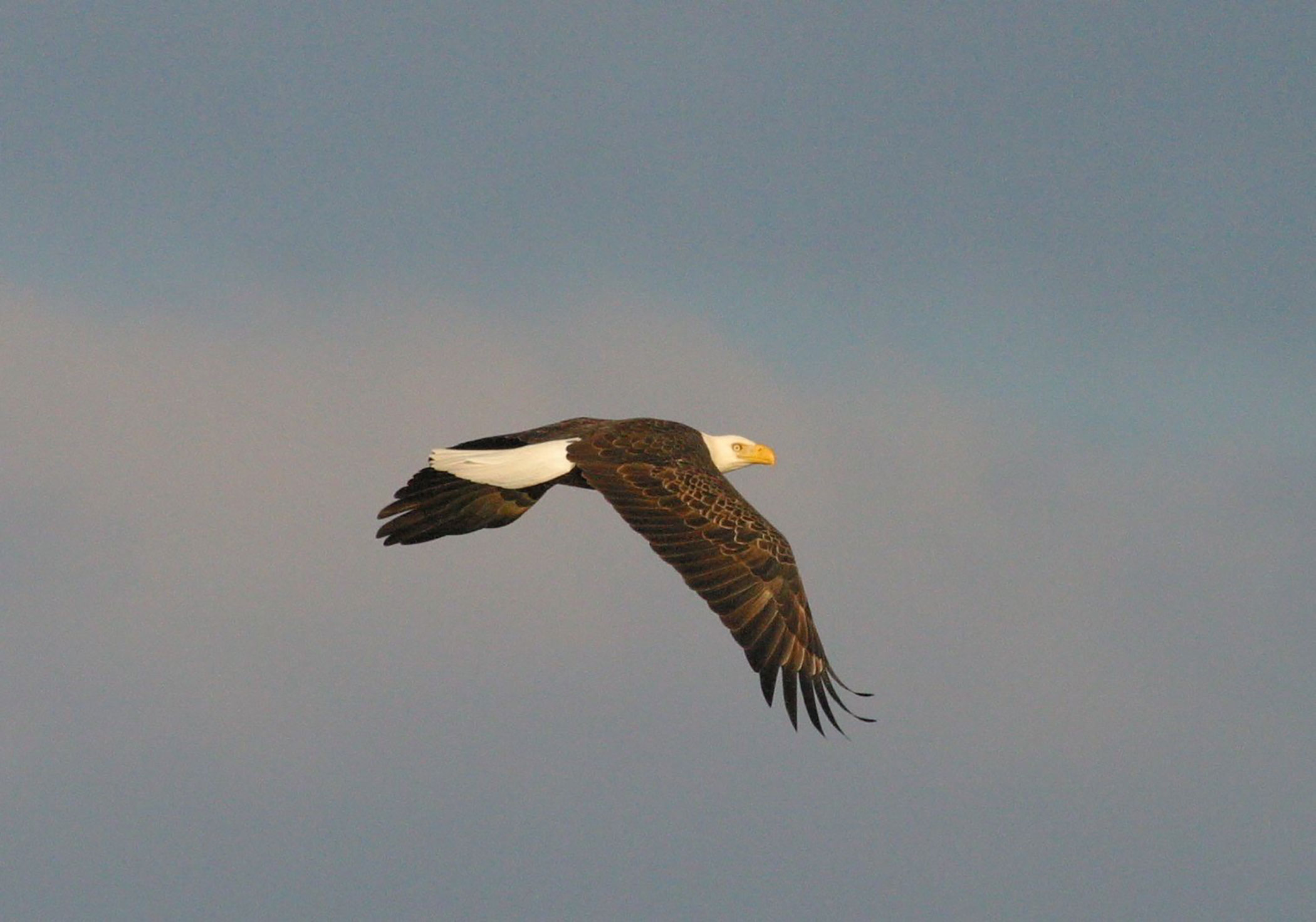
Disclaimer: These articles are not intended to provide medical advice, diagnosis or treatment. Views expressed here do not necessarily reflect those of Pittwater Online News or its staff.
